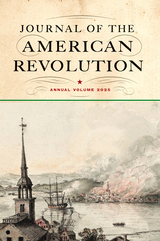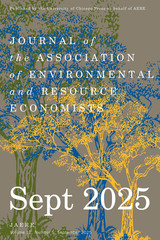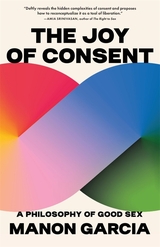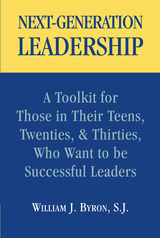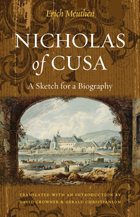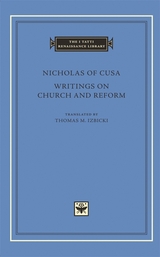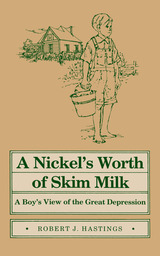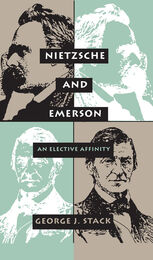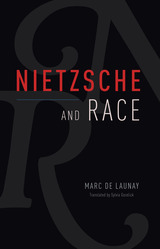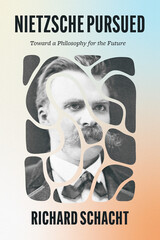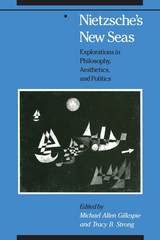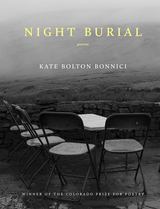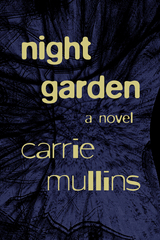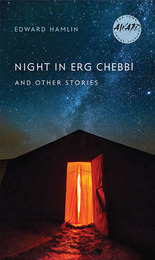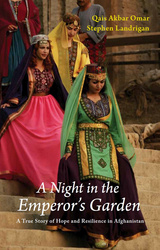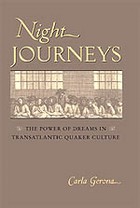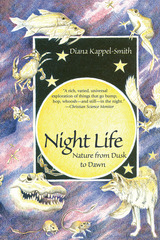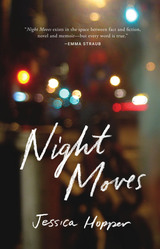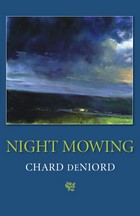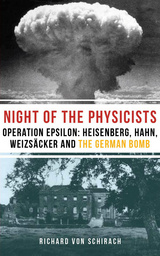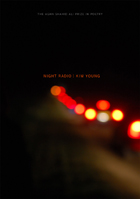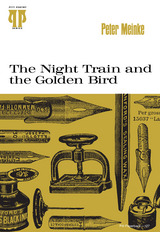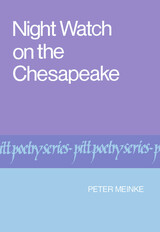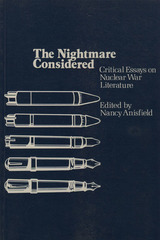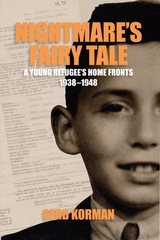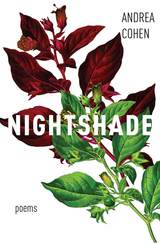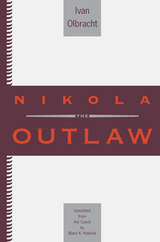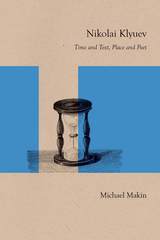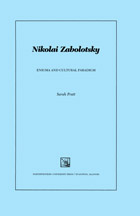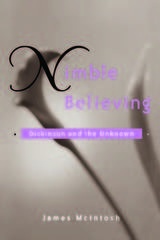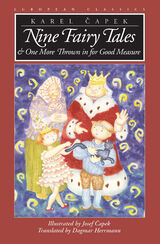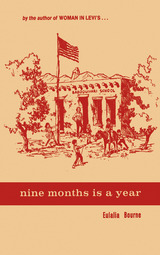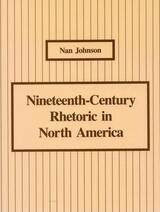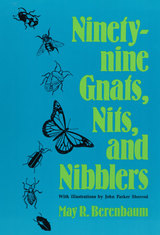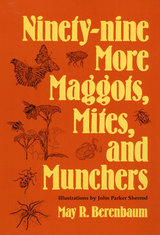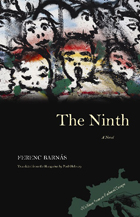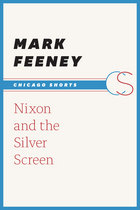Next-Generation Cognitive Radar Systems
Kumar Vijay Mishra
The Institution of Engineering and Technology, 2024 Next-Generation Cognitive Radar Systems brings together contributions from leading researchers who are engaged in the research and development of next generation cognitive abilities in radar engineering. It features recent advances in the theory and applications of advanced Cognitive Radar (CR) tools and examines emerging challenges. The chapters include mathematical and computational methods to combat important CR challenges as well as the applications of recent theories and algorithms to various applied CR aspects.
Next-Generation Leadership: A Toolkit for Those in Their Teens, Twenties, & Thirties, Who Want to be Successful Leaders
William J. Byron
University of Scranton Press, 2010 Drawing on his five decades of leadership experience, William Byron outlines in this volume the theory, practice, and purpose of leadership. Intuition, humility, empathy, simplicity of lifestyle, and sound speaking and writing skills are all essential for effective leadership, and Byron devotes separate, in-depth chapters to each. Aimed at an audience now largely overlooked by leadership literature, Next Generation Leadership will appeal to the business, government, religion, and nonprofit leaders of tomorrow.
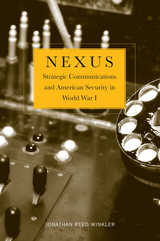 Nexus: Strategic Communications and American Security in World War I
Jonathan Reed Winkler
Harvard University Press, 2008 In an illuminating study that blends diplomatic, military, technology, and business history, Jonathan Reed Winkler shows how U.S. officials during World War I discovered the enormous value of global communications.
At the outbreak of war in 1914, British control of the cable network affected the Americans’ ability to communicate internationally, and the development of radio worried the Navy about hemispheric security. The benefits of a U.S. network became evident during the war, especially in the gathering of intelligence. This led to the creation of a peacetime intelligence operation, later termed the “Black Chamber,” that was the forerunner of the National Security Agency.
After the war, U.S. companies worked to expand network service around the world but faced industrial limitations. Focused on security concerns, the Wilson administration objected to any collaboration with British companies that might alleviate this problem. Indeed, they went so far as to create a radio monopoly and use warships to block the landing of a cable at Miami.
These efforts set important precedents for later developments in telephony, shortwave radio, satellites—even the internet. In this absorbing history, Winkler sheds light on the early stages of the global infrastructure that helped launch the United States as the predominant power of the century.
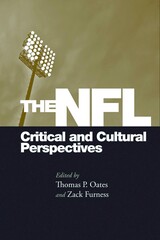 The NFL: Critical and Cultural Perspectives
Thomas Oates
Temple University Press, 2015 The National Football League is one of the most significant cultural engines in contemporary American life. Yet despite intense and near ubiquitous media coverage, commentators rarely turn a critical lens on the league to ask what material and social forces have contributed to its success, and how the NFL has influenced public life in the United States. The editors of and contributors to The NFL examine the league as a culturally, economically, and politically powerful presence in American life. The essays, by established and up-and-coming scholars, explore how the NFL is packaged for commercial consumption, the league's influence on American identity, and its relationship to state and cultural militarism. The NFL is the first collection of critical essays to focus attention on the NFL as a cultural force. It boldly moves beyond popular celebrations of the sport and toward a fuller understanding of football's role in shaping contemporary sport, media, and everyday life. Contributors include: David L. Andrews, Aaron Baker, Michael Butterworth, Jacob Dittmer, Dan Grano, Samantha King, Kyle Kusz, Toby Miller, Ronald L. Mower, Dylan Mulvin, Oliver J.C. Rick, Katie Rodgers, and the editors.
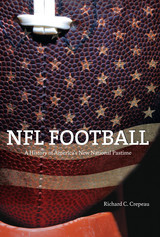 NFL Football: A History of America's New National Pastime
Richard C. Crepeau
University of Illinois Press, 2014 This wide-ranging history synthesizes scholarship and media sources to give the reader an inside view of the television contracts, labor issues, and other off-the-field forces that shaped the National Football League. Historian Richard Crepeau shows how Commissioner Pete Rozelle's steady leadership guided the league's explosive growth during the era of Monday Night Football and the Super Bowl's transformation into a mid-winter spectacle. Crepeau also delves into the league's masterful exploitation of media from radio to the internet, its ability to get taxpayers to subsidize team stadiums, and its success in delivering an outlet for experiencing vicarious violence to a public uneasy over the changing rules of masculinity.
Probing and learned, NFL Football tells an epic American success story peopled by larger-than-life figures and driven by ambition, money, sweat, and dizzying social and technological changes.
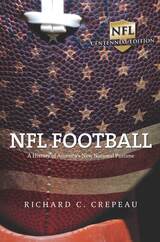 NFL Football: A History of America's New National Pastime
Richard C. Crepeau
University of Illinois Press, 2020 The new NFL Centennial Edition A multi-billion-dollar entertainment empire, the National Football League is a coast-to-coast obsession that borders on religion and dominates our sports-mad culture. But today's NFL also provides a stage for playing out important issues roiling American society. The updated and expanded edition of NFL Football observes the league's centennial by following the NFL into the twenty-first century, where off-the-field concerns compete with touchdowns and goal line stands for headlines. Richard Crepeau delves into the history of the league and breaks down the new era with an in-depth look at the controversies and dramas swirling around pro football today: - Tensions between players and Commissioner Roger Goodell over collusion, drug policies, and revenue;
- The firestorm surrounding Colin Kaepernick and protests of police violence and inequality;
- Andrew Luck and others choosing early retirement over the threat to their long-term health;
- Paul Tagliabue's role in covering up information on concussions;
- The Super Bowl's evolution into a national holiday.
Authoritative and up to the minute, NFL Football continues the epic American success story.
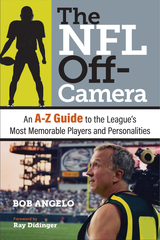 The NFL Off-Camera: An A–Z Guide to the League's Most Memorable Players and Personalities
Bob Angelo
Temple University Press, 2023 During his four-decade career at NFL Films, writing and directing segments for weekly highlight shows and national telecasts, Bob Angelo saw and heard things that never made their way into his productions. Now, in The NFL Off-Camera, Angelo mines the thousands of interviews he conducted to compile a revealing collection of short, insightful essays profiling his favorite—and least favorite—pro football players, coaches, team owners, executives, and broadcasters—all of whom he interacted with personally.
Angelo effuses about his meeting with the larger-than-life Jim Brown and appreciates the trash talking John Randle. He poignantly reflects on “Bullet” Bob Hayes, the world's fastest man who “could not outrun his demons,” and showcases the mercurial Duane Thomas and the free-wheeling Tony Siragusa. The NFL Off-Camera reveals why Angelo sparred with Hall-of-Fame player turned broadcaster Frank Gifford and demonstrates why Super Bowl champion head coach Sean Payton is his “least favorite person in pro football.”
From Jared Allen to Jim Zorn, The NFL Off-Camera explores nearly 100 of the game’s outsized personalities and debunks some of football's most enduring myths. Angelo’s original, unfiltered look at Pro Football is as hard-hitting and exciting as any one of his NFL Films.
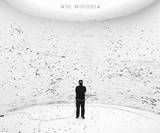 Nic Nicosia
By Nic Nicosia
University of Texas Press, 2012 Photographer and filmmaker Nic Nicosia makes pictures. Since the late 1970s, Nicosia has staged and constructed sets, objects, and situations to be photographed rather than to reproduce something that already exists. These conceptual fabrications have ranged from elaborate sets with live actors to dioramas and abstract constructions. Whether his pictures contain a disturbing suburban narrative, or are fabricated by the act of drawing, or are simply created by the use of common objects with dramatic lighting, the familiar thread of Nicosia’s unique vision and sensibility is always present. Nic Nicosia is the first major publication of the artist’s work and covers his entire oeuvre through 2011. The catalog presents images from all of Nicosia’s major photographic series, including Domestic Dramas, Near (modern) Disasters, The Cast, Life as We Know It, Real Pictures, Love + Lust, Acts, Sex Acts, Untitled Landscapes, 365 SaFe Days, Untitled (drawing), Space Time Light, I See Light, and in the absence of others, as well as stills from the videos Middletown, Moving Picture, Middletown Morning, Cerchi E Quadratti, On Acting America, and 9 1/2 Hours to SaFe. Accompanying the catalog is an overview of Nicosia’s career by Michelle White, an interview with the artist by Sue Graze, and an original short story by Philipp Meyer that powerfully resonates with the sense of wonder and menace in Nicosia’s art.
 Nicaragua and the Politics of Utopia: Development and Culture in the Modern State
Daniel Chavez
Vanderbilt University Press, 2015 The history of modern Nicaragua is populated with leaders promising a new and better day. Inevitably, as Nicaragua and the Politics of Utopia demonstrates, reality casts a shadow and the community must look to the next leader. As an impoverished state, second only to Haiti in the Americas, Nicaragua has been the scene of cyclical attempts and failures at modern development. Author Daniel Chavez investigates the cultural and ideological bases of what he identifies as the three decisive movements of social reinvention in Nicaragua: the regimes of the Somoza family of much of the early to mid-twentieth century; the governments of the Sandinista party; and the present day struggle to adapt to the global market economy.
For each era, Chavez reveals the ways Nicaraguan popular culture adapted and interpreted the new political order, shaping, critiquing, or amplifying the regime's message of stability and prosperity for the people. These tactics of interpretation, otherwise known as meaning-making, became all-important for the Nicaraguan people, as they opposed the autocracy of Somocismo, or complemented the Sandinistas, or struggled to find their place in the Neoliberal era. In every case, Chavez shows the reflective nature of cultural production and its pursuit of utopian idealism.
The Nicaraguan Constitution of 1987: English Translation and Commentary
Kenneth J. Mijeski
Ohio University Press, 1991 This volume of seven essays on the 1987 Nicaraguan constitution does not accept a priori the judgment that Latin American constitutions are as fragile as egg shells, easily broken and discarded if found to be inconvenient to the interests of the rulers. Rather, they are viewed as being central to understanding political life in contemporary Nicaragua.
The perspectives of the analysts and their conclusions are not consensual. They prohibit glib and facile general conclusions. Some find the constitution to be nothing more than a façade for arbitrary and capricious rule; others that the document reflects clear commitments to the democratic rule of law. Thus far the implementation of the constitution has resulted in the peaceful transition of power from the Sandinistas to the National Opposition Union.
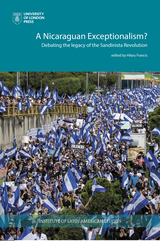 Nicaraguan Exceptionalism? Debating the Legacy of the Sandinista Revolution
Edited by Hilary Francis
University of London Press, 2019 In recent years, child migrants from Central America have arrived in the United States in unprecedented numbers. But whilst minors from Honduras, Guatemala and El Salvador make the perilous journey to the north, their Nicaraguan peers have remained in Central America. Nicaragua also enjoys lower murder rates and far fewer gang problems when compared with her neighbours. Why is Nicaragua so different? The present government has promulgated a discourse of Nicaraguan exceptionalism, arguing that Nicaragua is unique thanks to heritage of the 1979 Sandinista revolution. This volume critically interrogates that claim, asking whether the legacy of the revolution is truly exceptional. An interdisciplinary work, the book brings together historians, anthropologists and sociologists to explore the multifarious ways in which the revolutionary past continues to shape public policy - and daily life - in Nicaragua’s tumultuous present.
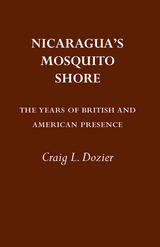 Nicaragua's Mosquito Shore: The Years of British and American Presence
Craig L. Dozier
University of Alabama Press, 1985 Nicaragua’s Mosquito Shore provides a general history of eastern Nicaragua from the time of the first British entry in 1633 to the present. The territory is populated chiefly by Mosquito Indians, who speak their own language and some Mosquito. Separated from Nicaragua’s Pacific plain by mountains, the Atlantic coastal plain extends between 70 and 100 miles into the interior. Early Spanish settlers were ousted by the British, who engaged in the mahogany trade, and who also hoped for trade with Americans seeking a short route to California. In 1850, with the signing of the Clayton-Bulwer Treaty, the U.S. and Britain agreed that neither country would seek to acquire exclusive control over a Nicaraguan canal. Plans for the development of a Nicaraguan canal had a marked influence on the region for the next 100 years. During the second half of the 19th century both rubber and bananas were produced commercially in eastern Nicaragua, and the Standard Fruit Company of New Orleans became the larges single commercial influence in the region. The first over American intervention in eastern Nicaragua occurred in 1912, when a contingent of Marines was dispatched to protect American commercial interests. The Marines remained for thirteen years. Dozier develops the history of the current political troubles in Nicaragua, which had their origin in the early 1930s and which center about the control of the rich area inhabited by the Mosquitos. His book presents the historical background for the tragic events that are now taking place in that region.
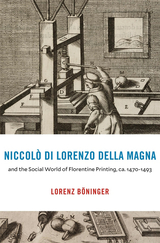 Niccolò di Lorenzo della Magna and the Social World of Florentine Printing, ca. 1470–1493
Lorenz Böninger
Harvard University Press, 2021 A new history of one of the foremost printers of the Renaissance explores how the Age of Print came to Italy.
Lorenz Böninger offers a fresh history of the birth of print in Italy through the story of one of its most important figures, Niccolò di Lorenzo della Magna. After having worked for several years for a judicial court in Florence, Niccolò established his business there and published a number of influential books. Among these were Marsilio Ficino’s De christiana religione, Leon Battista Alberti’s De re aedificatoria, Cristoforo Landino’s commentaries on Dante’s Commedia, and Francesco Berlinghieri’s Septe giornate della geographia. Many of these books were printed in vernacular Italian.
Despite his prominence, Niccolò has remained an enigma. A meticulous historical detective, Böninger pieces together the thorough portrait that scholars have been missing. In doing so, he illuminates not only Niccolò’s life but also the Italian printing revolution generally. Combining Renaissance studies’ traditional attention to bibliographic and textual concerns with a broader social and economic history of printing in Renaissance Italy, Böninger provides an unparalleled view of the business of printing in its earliest years. The story of Niccolò di Lorenzo furnishes a host of new insights into the legal issues that printers confronted, the working conditions in printshops, and the political forces that both encouraged and constrained the publication and dissemination of texts.
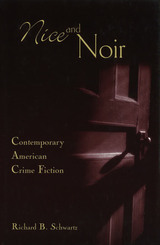 Nice and Noir: Contemporary American Crime Fiction
Richard B. Schwartz
University of Missouri Press, 2002
Owners of mystery bookshops will tell you that there are several sorts of buyers: those who purchase on impulse or whim; genre addicts who buy paperbacks by the week and by the armful; and those who have caught up on canonical texts and regularly buy new novels by select authors in hardcover. Richard B. Schwartz belongs in the last group, with his own list of approximately seventy favorite writers.
Nice and Noir: Contemporary American Crime Fiction explores the work of these writers, building upon a reading of almost seven hundred novels from the 1980s and 1990s. By looking at recurring themes in these mysteries, Schwartz offers readers new ways to approach the works in relation to contemporary cultural concerns.
With sensitivity to a culture consisting of frontiers and borders, Schwartz examines the position of the vigilante in art and society, racial bridges and divides, the absence of divine presence and compensating narrative strategies, the unresolved nature of the crime plot and its roots in chivalric romance. The special importance of setting and the growing importance of grotesque humor in the fiction studied here are addressed by the author, as is the journalistic/instructional dimension of the field and the importance of crossover narratives.
This book is not only a study and appreciation of an important subgenre and its contemporary practitioners; it also utilizes both literary history and theoretical material. Information has been drawn from fanzines, from discussions with writers, booksellers, agents, and editors, and from the author’s own extensive knowledge of literature and American culture.
Nice and Noir is wide-ranging but neither ponderous nor lugubrious. Its language is accessible but not simplistic. The book will have a broad appeal—both to academics and to general readers with some interest in American studies and popular culture.
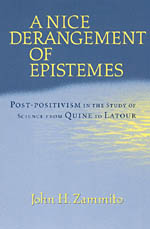 A Nice Derangement of Epistemes: Post-positivism in the Study of Science from Quine to Latour
John H. Zammito
University of Chicago Press, 2004 Since the 1950s, many philosophers of science have attacked positivism—the theory that scientific knowledge is grounded in objective reality. Reconstructing the history of these critiques, John H. Zammito argues that while so-called postpositivist theories of science are very often invoked, they actually provide little support for fashionable postmodern approaches to science studies.
Zammito shows how problems that Quine and Kuhn saw in the philosophy of the natural sciences inspired a turn to the philosophy of language for resolution. This linguistic turn led to claims that science needs to be situated in both historical and social contexts, but the claims of recent "science studies" only deepened the philosophical quandary. In essence, Zammito argues that none of the problems with positivism provides the slightest justification for denigrating empirical inquiry and scientific practice, delivering quite a blow to the "discipline" postmodern science studies.
Filling a gap in scholarship to date, A Nice Derangement of Epistemes will appeal to historians, philosophers, philosophers of science, and the broader scientific community.
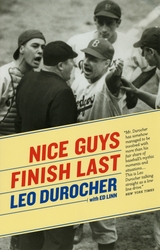 Nice Guys Finish Last
Leo Durocher with Ed Linn
University of Chicago Press, 2009 “I believe in rules. Sure I do. If there weren't any rules, how could you break them?”
The history of baseball is rife with colorful characters. But for sheer cantankerousness, fighting moxie, and will to win, very few have come close to Leo “the Lip” Durocher. Following a five-decade career as a player and manager for baseball’s most storied franchises, Durocher teamed up with veteran sportswriter Ed Linn to tell the story of his life in the game. The resulting book, Nice Guys Finish Last, is baseball at its best, brimming with personality and full of all the fights and feuds, triumphs and tricks that made Durocher such a success—and an outsized celebrity.
Durocher began his career inauspiciously, riding the bench for the powerhouse 1928 Yankees and hitting so poorly that Babe Ruth nicknamed him “the All-American Out.” But soon Durocher hit his stride: traded to St. Louis, he found his headlong play and never-say-die attitude a perfect fit with the rambunctious “Gashouse Gang” Cardinals. In 1939, he was named player-manager of the Brooklyn Dodgers—and almost instantly transformed the underachieving Bums into perennial contenders. He went on to manage the New York Giants, sharing the glory of one of the most famous moments in baseball history, Bobby Thomson’s “shot heard ’round the world,” which won the Giants the 1951 pennant. Durocher would later learn how it felt to be on the other side of such an unforgettable moment, as his 1969 Cubs, after holding first place for 105 days, blew a seemingly insurmountable 8-1/2-game lead to the Miracle Mets.
All the while, Durocher made as much noise off the field as on it. His perpetual feuds with players, owners, and league officials—not to mention his public associations with gamblers, riffraff, and Hollywood stars like George Raft and Larraine Day—kept his name in the headlines and spread his fame far beyond the confines of the diamond.
A no-holds-barred account of a singular figure, Nice Guys Finish Last brings the personalities and play-by-play of baseball’s greatest era to vivid life, earning a place on every baseball fan’s bookshelf.
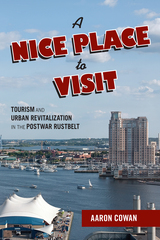 A Nice Place to Visit: Tourism and Urban Revitalization in the Postwar Rustbelt
Aaron Cowan
Temple University Press, 2016 How did tourism gain a central role in the postwar American Rustbelt city? And how did tourism development reshape the meaning and function of these cities? These are the questions at the heart of Aaron Cowan’s groundbreaking book, A Nice Place to Visit. Cowan provides an insightful, comparative look at the historical development of Cincinnati, St. Louis, Pittsburgh, and Baltimore in the post–World War II period to show how urban tourism provided a potential solution to the economic woes of deindustrialization. A Nice Place to Visit chronicles the visions of urban leaders who planned hotels, convention centers, stadiums, and festival marketplaces to remake these cities as tourist destinations. Cowan also addresses the ever-present tensions between tourist development and the needs and demands of residents in urban communities. A Nice Place to Visit charts how these Rustbelt cities adapted to urban decline and struggled to meet the challenge of becoming an appealing place to visit, as well as good and just communities in which to live.
Niche
David Edwards and Jay Cantor; photographs by Daniel Faust
Harvard University Press, 2007 Niche tells the story of an artist who meets a scientist and through the encounter makes a hypothesis: If the artist became a stem cell and then divided into a neuron, would he discover the meaning of intelligence? David Edwards and Jay Cantor introduce a new fiction genre—the novel catalogue—to coincide with the opening of the new art and design innovation center in Paris, Le Laboratoire. In the novel catalogue, the process through which creators create matters as much as the works that result from the creation. The novel catalogue fictionalizes the creative process of an exhibition season which opens with the artistic outcome of an experiment between Fabrice Hyber, a French artist, and Robert Langer of MIT.
Nicholas I, Patriarch of Constantinople: Letters
R. J. H. Jenkins and L. G. Westerink
Harvard University Press Next to Photius and Michael Cerularius, Nicholas I is probably the most prominent of the patriarchs of Constantinople. He was the central figure in the “tetragamy” affair, the conflict over Leo VI’s fourth marriage, which divided the Church for nearly a century and resulted in Nicholas’s temporary deposition. He was also a major influence in both the domestic and foreign politics of the Eastern Empire throughout the first quarter of the tenth century. His correspondence with the Papal court and with Bulgarian, Caucasian, and Arab provinces, as well as with his own clergy, is a historical source of the first importance, collected in Nicholas I, Patriarch of Constantinople: Letters.
This volume is supplemented by Nicholas I, Patriarch of Constantinople: Miscellaneous Writings (CFHB XX, DOT VI).
Nicholas I, Patriarch of Constantinople: Miscellaneous Writings
L. G. Westerink
Harvard University Press Miscellaneous Writings is a supplement to Nicholas I, Patriarch of Constantinople: Letters. The two volumes together contain all the extant writings of a great Byzantine churchman, politician, and author of the first quarter of the tenth century.
Besides a few stray letters not preserved by the regular manuscript tradition, the Miscellaneous Writings include eight patriarchal documents, including the Tome of Union of 920; a brief but impressive sermon on the capture of Thessalonica in 904; extracts from a pamphlet on the famous controversy around Leo VI’s fourth marriage; and five hymns, three of which are attested as written by the patriarch, while the remaining two should more probably be assigned to a namesake.
Nicholas of Cusa: A Sketch for a Biography
Erich Meuthen
Catholic University of America Press, 2010 This translation of Erich Meuthen's well-known biography of Nicholas of Cusa presents the foremost summary of Cusanus's life and thought. F
 Nicholas of Cusa's On Learned Ignorance: A Commentary on De docta ignorantia
Karsten Harries
Catholic University of America Press, 2024 This is the first commentary to have been written on Nicholas of Cusa's most famous work, On Learned Ignorance. This fact testifies to the difficulty of what has long been recognized to be the most significant philosophical text produced by the Renaissance. While there are many passages in the work that can be cited in support of Cassirer's celebration of Cusanus as the first modern philosopher, that judgment is challenged by the way his work is rooted in a faith and a tradition likely to strike us as thoroughly medieval. This commentary shows how closely the two are linked. Despite the many ways in which what the cardinal has to say belongs to a past that the progress of reason would seem to have left irrecoverably behind, it yet provides us with a continuing challenge. Key to On Learned Ignorance is the incommensurability of the infinite and the finite, of God and creation. Cusanus lets us recognize the essential transcendence of reality, so different from the ontology implied by Descartes' insistence on clear and distinct understanding, which has presided over the progress of science and has helped shape our world. What makes Cusanus’ thought important is not the way it anticipates modernity, but the way it challenges often taken-for-granted presuppositions of our worldview, most importantly a distinctly modern self-assertion or self-elevation that has made our human reason the measure of reality. If it is impossible to deny the countless ways in which our science and technology have given us ever deeper insights into the mysteries of nature and improved our lives, it is equally impossible to deny that this very progress today endangers this fragile earth and the quality of our lives. Cusanus can help us preserve our humanity.
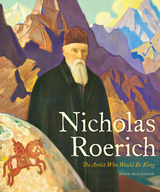 Nicholas Roerich: The Artist Who Would Be King
John McCannon
University of Pittsburgh Press, 2022 Russian painter, explorer, and mystic Nicholas Roerich (1874–1947) ranks as one of the twentieth century’s great enigmas. Despite mystery and scandal, he left a deep, if understudied, cultural imprint on Russia, Europe, India, and America. As a painter and set designer Roerich was a key figure in Russian art. He became a major player in Diaghilev’s Ballets Russes, and with Igor Stravinsky he cocreated The Rite of Spring, a landmark work in the emergence of artistic modernity. His art, his adventures, and his peace activism earned the friendship and admiration of such diverse luminaries as Albert Einstein, Eleanor Roosevelt, H. G. Wells, Jawaharlal Nehru, Raisa Gorbacheva, and H. P. Lovecraft.
But the artist also had a darker side. Stravinsky once said of Roerich that “he ought to have been a mystic or a spy.” He was certainly the former and close enough to the latter to blur any distinction. His travels to Asia, supposedly motivated by artistic interests and archaeological research, were in fact covert attempts to create a pan-Buddhist state encompassing Siberia, Mongolia, and Tibet. His activities in America touched Franklin Delano Roosevelt’s cabinet with scandal and, behind the scenes, affected the course of three US presidential elections.
In his lifetime, Roerich baffled foreign affairs ministries and intelligence services in half a dozen countries. He persuaded thousands that he was a humanitarian and divinely inspired thinker—but convinced just as many that he was a fraud or a madman. His story reads like an epic work of fiction and is all the more remarkable for being true. John McCannon’s engaging and scrupulously researched narrative moves beyond traditional perceptions of Roerich as a saint or a villain to show that he was, in many ways, both in equal measure.
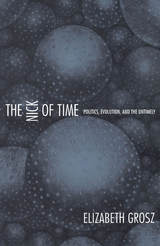 The Nick of Time: Politics, Evolution, and the Untimely
Elizabeth Grosz
Duke University Press, 2004 In this pathbreaking philosophical work, Elizabeth Grosz points the way toward a theory of becoming to replace the prevailing ontologies of being in social, political, and biological discourse. Arguing that theories of temporality have significant and underappreciated relevance to the social dimensions of science and the political dimensions of struggle, Grosz engages key theoretical concerns related to the reality of time. She explores the effect of time on the organization of matter and on the emergence and development of biological life. Considering how the relentless forward movement of time might be conceived in political and social terms, she begins to formulate a model of time that incorporates the future and its capacity to supersede and transform the past and present. Grosz develops her argument by juxtaposing the work of three major figures in Western thought: Charles Darwin, Friedrich Nietzsche, and Henri Bergson. She reveals that in theorizing time as an active, positive phenomenon with its own characteristics and specific effects, each of these thinkers had a profound effect on contemporary understandings of the body in relation to time. She shows how their allied concepts of life, evolution, and becoming are manifest in the work of Gilles Deleuze and Luce Irigaray. Throughout The Nick of Time, Grosz emphasizes the political and cultural imperative to fundamentally rethink time: the more clearly we understand our temporal location as beings straddling the past and the future without the security of a stable and abiding present, the more transformation becomes conceivable.
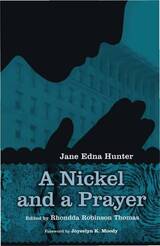 A Nickel and a Prayer
Jane Edna Hunter, Edited by Rhondda Robinson Thomas, with a foreword by Joycelyn Moody
West Virginia University Press, 2010 Virtually unknown outside of her adopted hometown of Cleveland, Ohio, Jane Edna Harris Hunter was one of the most influential African American social activists of the early-to mid-twentieth century. In her autobiography A Nickel and a Prayer, Hunter presents an enlightening two-part narrative that recollects her formative years in post-Civil War South and her activist years in Cleveland. First published in 1940, Hunter’s autobiography recalls a childhood filled with the pleasures and pains of family life on the former plantation where her ancestors had toiled, adventures and achievements in schools for African American children, tests and trials during her brief marriage, and recognition and respect while completing nursing training and law school. When sharing the story of her life as an activist, Hunter describes the immense obstacles she overcame while developing an interracial coalition to support the Phillis Wheatley Association and nurturing its growth from a rented home that provided accommodation for twenty-two women to a nine-story building that featured one hundred and thirty-five rooms.
This new and annotated edition of A Nickel and a Prayer includes the final chapter, “Fireside Musings,” that Hunter added to the second, limited printing of her autobiography and an introduction that lauds her as a multifaceted social activist who not only engaged in racial uplift work, but impacted African American cultural production, increased higher education opportunities for women, and invigorated African American philanthropy. This important text restores Jane Edna Harris Hunter to her rightful place among prominent African American race leaders of the twentieth century.
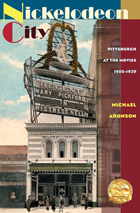 Nickelodeon City: Pittsburgh at the Movies, 1905-1929
Michael Aronson
University of Pittsburgh Press, 2010 From the 1905 opening of the wildly popular, eponymous Nickelodeon in the city's downtown to the subsequent outgrowth of nickel theaters in nearly all of its neighborhoods, Pittsburgh proved to be perfect for the movies. Its urban industrial environment was a melting pot of ethnic, economic, and cultural forces—a “wellspring” for the development of movie culture—and nickelodeons offered citizens an inexpensive respite and handy escape from the harsh realities of the industrial world.
Nickelodeon City provides a detailed view inside the city's early film trade, with insights into the politics and business dealings of the burgeoning industry. Drawing from the pages of the Pittsburgh Moving Picture Bulletin, the first known regional trade journal for the movie business, Michael Aronson profiles the major promoters in Pittsburgh, as well as many lesser-known ordinary theater owners, suppliers, and patrons. He examines early film promotion, distribution, and exhibition, and reveals the earliest forms of state censorship and the ensuing political lobbying and manipulation attempted by members of the movie trade. Aronson also explores the emergence of local exhibitor-based cinema, in which the exhibitor assumed control of the content and production of film, blurring the lines between production, consumption, and local and mass media.
Nickelodeon City offers a fascinating and intimate view of a city and the socioeconomic factors that allowed an infant film industry to blossom, as well as the unique cultural fabric and neighborhood ties that kept nickelodeons prospering even after Hollywood took the industry by storm.
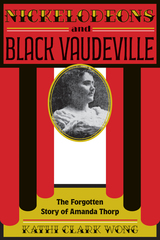 Nickelodeons and Black Vaudeville: The Forgotten Story of Amanda Thorp
Kathi Clark Wong
University of Tennessee Press, 2023 In an era of online streaming, it may be difficult to recognize the importance of a woman who in 1908 established the first silent movie theater in Richmond, Virginia: the Dixie nickelodeon. But Amanda Thorp, an independent, self-made woman, was on the ground floor of a popular culture that would grow to be enormously influential in our modern era. In Nickelodeons and Black Vaudeville: The Forgotten Story of Amanda Thorp, Kathi Clark Wong’s extensive archival research uncovers Thorp’s impressive contributions not only to moviegoing and its growth in America, but also perhaps even more surprisingly, Thorp’s support of early Black vaudeville in the Jim Crow South.
Movie theater entrepreneurs like Thorp, who got her start at her Wonderland Theater in Bucyrus, Ohio, helped create our culture’s insatiable appetite for film. But it was after she established the Dixie in Richmond, that Thorp—a White woman—also saw a market for providing Black-centric entertainment. She converted the Dixie to all-Black patronage and began to bring in scores of Black vaudeville acts. Later, she built the Hippodrome Theater, in the heart of Richmond’s now-historic Jackson Ward, expressly for Black entertainment. Though she eventually left the field of Black entertainment behind, Thorp developed other movie venues in Richmond that brought in tens of thousands of (White) moviegoers over the years and which were widely admired for their elaborate trappings.
Thanks to Wong’s research, contemporary readers can now benefit from the story of Amanda Thorp, a woman who amidst severe gender role constraints not only claimed social capacity on the crest of a rapidly growing industry but also, almost inadvertently, contributed to the success of early Black vaudeville, a subject which thus far has not received the scholarly attention it deserves.
A Nickel's Worth of Skim Milk: A Boy's View of the Great Depression
Robert J. Hastings
Southern Illinois University Press, 1986 Told from the point of view of a young boy, this account shows how a family “faced the 1930s head on and lived to tell the story.” It is the story of growing up in southern Illinois, specifically the Marion, area during the Great Depression. But when it was first published in 1972 the book proved to be more than one writer’s memories of depression-era southern Illinois. “People started writing me from all over the country,” Hastings notes. “And all said much the same: ‘You were writing about my family, as much as your own. That’s how I remember the 1930s, too.’” As he proves time and again in this book, Hastings is a natural storyteller who can touch upon the detail that makes the tale both poignant and universal. He brings to life a period that marked every man, woman, and child who lived through it even as that national experience fades into the past.
 Nicomachean Ethics
Aristotle
Harvard University Press Antiquity’s most influential account of life’s Supreme Good.
Aristotle, great Greek philosopher, researcher, reasoner, and writer, born at Stagirus in 384 BC, was the son of a physician. He studied under Plato at Athens and taught there (367–347); subsequently he spent three years at the court of a former pupil in Asia Minor. After some time at Mitylene, in 343–342 he was appointed by King Philip of Macedon to be tutor of his teen-aged son Alexander. After Philip’s death in 336, Aristotle became head of his own school (of “Peripatetics”), the Lyceum at Athens. Because of anti-Macedonian feeling there after Alexander’s death in 323, he withdrew to Chalcis in Euboea, where he died in 322.
Nearly all the works Aristotle prepared for publication are lost; the priceless ones extant are lecture-materials, notes, and memoranda (some are spurious). They can be categorized as follows:
I Practical: Nicomachean Ethics; Great Ethics (Magna Moralia); Eudemian Ethics; Politics; Economics (on the good of the family); On Virtues and Vices.
II Logical: Categories; Analytics (Prior and Posterior); Interpretation; Refutations used by Sophists; Topica.
III Physical: Twenty-six works (some suspect) including astronomy, generation and destruction, the senses, memory, sleep, dreams, life, facts about animals, etc.
IV Metaphysics: on being as being.
V Art: Rhetoric and Poetics.
VI Other works including the Constitution of Athens; more works also of doubtful authorship.
VII Fragments of various works such as dialogues on philosophy and literature; and of treatises on rhetoric, politics, and metaphysics.
The Loeb Classical Library edition of Aristotle is in twenty-three volumes.
 Nietzsche
Lou Salomé
University of Illinois Press, 1988 This English translation of Friedrich Nietzsche in seinen Werken offers a rare, intimate view of the philosopher by Lou Salomé, a free-thinking, Russian-born intellectual to whom Nietzsche proposed marriage at only their second meeting.
Published in 1894 as its subject languished in madness, Salomé's book rode the crest of a surge of interest in Nietzsche's iconoclastic philosophy. She discusses his writings and such biographical events as his break with Wagner, attempting to ferret out the man in the midst of his works.
Salomé's provocative conclusion -- that Nietzsche's madness was the inevitable result of his philosophical views -- generated considerable controversy. Nietzsche's sister, Elisabeth Förster-Nietzsche, dismissed the book as a work of fantasy. Yet the philosopher's longtime acquaintance Erwin Rohde wrote, "Nothing better or more deeply experienced or perceived has ever been written about Nietzsche."
Siegfried Mandel's extensive introduction examines the circumstances that brought Lou Salomé and Nietzsche together and the ideological conflicts that drove them apart.
Nietzsche
Crane Brinton
Harvard University Press
Nietzsche & Emerson: An Elective Affinity
George J. Stack
Ohio University Press, 1993 George J. Stack traces the sources of ideas and theories that have long been considered the exclusive province of Friedrich Nietzsche to the surprisingly radical writings of the American essayist and poet, Ralph Waldo Emerson. Nietzsche and Emerson makes us see Emerson’s writings in a new, more intensified light and presents a new perspective on Nietzsche’s philosophy. Stack traces how the rich theoretical ideas and literary images of Emerson entered directly into the existential dimension of Nietzsche’s thought and hence into the stream of what has been considered a distinctively European intellectual movement.
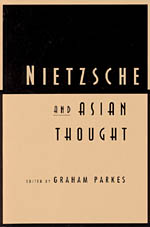 Nietzsche and Asian Thought
Edited by Graham Parkes
University of Chicago Press, 1991 Friedrich Nietzsche's work has had a significant impact on the intellectual life of non-Western cultures and elicited responses from important thinkers outside of the Anglo-American philosophical traditions as well. Bringing together thirteen internationally renowned scholars, this is the first collection of essays to address the connection between Nietzsche's ideas and philosphies in India, China, and Japan.
The contributors are Roger T. Ames, Johann Figl, Chen Guying, Michel Hulin, Arifuku Kogaku, David A. Kelly, Glen T. Martin, Sonoda Muneto, Graham Parkes, okochi Ryogi, Eberhard Scheiffele, Mervyn Sprung, and Joan Stambaugh.
"Exemplary. Its comparative approach is incisive yet accessible. I consider it a 'must read'"—Kathleen Marie Higgins, Philosophy East and West
"An excellent introduction to the broad ranging reception of Nietzsche among Asian thinkers."—James R. Watson, Canadian Philosophical Review
"The essays in this welcome collection are invariably thought-provoking and genuinely cross-disciplinary."—Kenneth Surin, Religious Studies Review
"A worthy and undogmatic introduction to several fascinating questions concerning the relations between Nietzschean thought and certain traditions of thought in India, China, and Japan."—Don Miller, Asian Studies Review
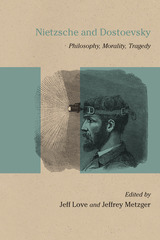 Nietzsche and Dostoevsky: Philosophy, Morality, Tragedy
Edited by Jeff Love and Jeffrey Metzger
Northwestern University Press, 2016 After more than a century, the urgency with which the writing of Fyodor Dostoevsky and Friedrich Nietzsche speaks to us is undiminished. Nietzsche explicitly acknowledged Dostoevsky’s relevance to his work, noting its affinities as well as its points of opposition. Both of them are credited with laying much of the foundation for what came to be called existentialist thought. The essays in this volume bring a fresh perspective to a relationship that illuminates a great deal of twentieth-century intellectual history. Among the questions taken up by contributors are the possibility of morality in a godless world, the function of philosophy if reason is not the highest expression of our humanity, the nature of tragedy when performed for a bourgeois audience, and the justification of suffering if it is not divinely sanctioned. Above all, these essays remind us of the supreme value of the questioning itself that pervades the work of Dostoevsky and Nietzsche.
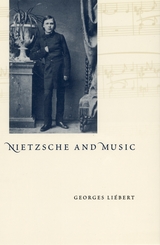 Nietzsche and Music
Georges Liébert
University of Chicago Press, 2003 "Without music, life would be an error."—Friedrich Nietzsche
In his youth, Friedrich Nietzsche yearned to become a great composer and wrote many pieces of music. He later claimed to be "the most musical of all philosophers." Yet most books on Nietzsche fail to explore the importance of music for his thought.
Nietzsche and Music provides the first in-depth examination of the fundamental significance of music for Nietzsche's life and work. Nietzsche's views on music are essential for understanding his philosophy as a whole. Part biography and part critical examination, Georges Liébert brilliantly demonstrates that despite failed attempts at a professional career as composer, Nietzsche never fully removed himself from the world of music, but instead, became a composer of philosophy, utilizing the musical form as a template for his own writings and creative thought. Liébert's study surveys Nietzsche's opinions about particular composers and compositions, as well as his more theoretical writings on music and its relation to the other arts. He also explores Nietzsche's listening habits, his playing and style of composition, and his many contacts in the musical world, including his controversial and contentious relationship with Richard Wagner. For Nietzsche, music gave access to a realm of wisdom that transcended thought. Music was Nietzsche's great solace; in his last years, it was his refuge from madness.
A virtuoso exploration of this little-known but crucial aspect of Nietzsche's life and work, this volume will be of enormous value to scholars of philosophy, music, aesthetics, and literature.
Nietzsche and Race
Marc de Launay
University of Chicago Press, 2023 A definitive debunking of the “Nietzsche as Nazi” caricature.
The caricature of Friedrich Nietzsche as a proto-Nazi is still with us, having originated with his own Nazi sister, Elisabeth Förster, who curated Nietzsche’s disparate texts to suit her own purposes. In Nietzsche and Race, Marc de Launay deftly counters this persistent narrative in a series of concise and highly accessible reflections on the concept of race in Nietzsche’s publications, notebooks, and correspondence. Through a fresh reading of Nietzsche’s core philosophical project, de Launay articulates a new understanding of race in Nietzsche’s body of work free from the misunderstanding of his detractors.
Nietzsche and the Problem of Sovereignty
Richard J. White
University of Illinois Press, 1997 From The Birth of Tragedy on, Nietzsche worked to comprehend the
nature of the individual. Richard White shows how Nietzsche was inspired
and guided by the question of personal "sovereignty" and how
through his writings he sought to provoke the very sovereignty he described.
White argues that Nietzsche is a philosopher our contemporary age must
therefore come to understand if we are ever to secure a genuinely meaningful
direction for the future. Profoundly relevant to our era, Nietzsche's
philosophy addresses a version of individuality that allows us to move
beyond the self-dispossession of mass society and the alternative of selfish
individualism--to fully understand how one becomes what one is.
A volume in the International Nietzsche Studies series, edited by
Richard Schacht
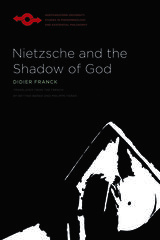 Nietzsche and the Shadow of God
Didier Franck; Translated from the French by Bettina Bergo and Philippe Farah
Northwestern University Press, 2011 In Nietzsche and the Shadow of God (Nietzsche et l’ombre de Dieu), his study of Nietzsche’s integral philosophical corpus, Franck revisits the fundamental concepts of Nietzsche’s thought, from the death of God and the will to power, to the body as the seat of thinking and valuing, and finally to his conception of a post-Christian justice. The work engages Heidegger’s interpretation of Nietzsche’s destruction of the Platonic-Christian worldview, showing how Heidegger’s hermeneutic overlooked Nietzsche’s powerful confrontation with revelation and justice by working through the Christian body, as set forth in the Epistles of Saint Paul and reread both by Martin Luther and by German Idealism. Franck shows systematically how Nietzsche “transvalued” the metaphysical tenets of the Christian body of believers. In so doing, he provides an unparalleled demonstration of the coherence of Nietzsche’s project and the ways in which the revaluation of values, amor fati, and the trials of eternal recurrence reshape the living self toward a creative existence beyond original sin—indeed, beyond an ethics of “good” versus “evil.”
Bergo and Farah’s clear translation introduces this work to an English-speaking audience for the first time.
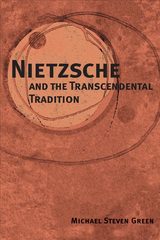 Nietzsche and the Transcendental Tradition
Michael Steven Green
University of Illinois Press, 2002 In recent years, both analytic thinkers and postmodern theorists have looked at Friedrich Nietzsche's epistemology from the perspectives of their philosophical traditions. Michael Steven Green's penetrating study tries instead to do justice to Nietzsche's views on truth and knowledge by looking at them from the perspective of his contemporaries, particularly the Neo-Kantian philosopher Afrikan Spir, whose ideas exerted a tremendous influence on Nietzsche's thought. Despite his generally naturalist outlook, Nietzsche was committed to an antinaturalist theory of cognition inherited from Kant and Spir. Green shows how this fundamental tension in Nietzsche's thought led him to present not only the antirealism that has commonly been attributed to him in the past, but two other epistemological positions. These are a denial of the possibility of human thought entirely, and an error theory–-the argument that all of our judgments are false–-that has strong parallels in Spir's thought and Kant's antinomies. Viewing Nietzsche's error theory in light of Kantian transcendental idealism, Green makes sense of arguments that have previously confounded Nietzsche interpreters. Green also provides the first English translations of many passages from Spir's writings and Nietzsche's notebooks. In examining Nietzsche's thought through the lens of the philosophical influences upon him–-the philosophers that Nietzsche himself read–-Green establishes a significant new foundation from which to assess Nietzsche's place in modern philosophy and culture.
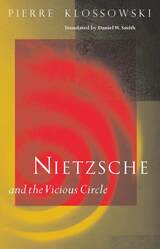 Nietzsche and the Vicious Circle
Pierre Klossowski
University of Chicago Press, 1997 A landmark explication of Nietzsche's work from one of the most prominent experts on the philosopher's thought
Long recognized as a masterpiece of Nietzsche scholarship, Nietzsche and the Vicious Circle is made available here for the first time in English. Taking a structuralist approach to the relation between Nietzsche's thought and his life, Klossowski emphasizes the centrality of the notion of Eternal Return (a cyclical notion of time and history) for understanding Nietzsche's propensities for self-denial, self-reputation, and self-consumption.
Nietzsche's ideas did not stem from personal pathology, according to Klossowski. Rather, he made a pathological use of his best ideas, anchoring them in his own fluctuating bodily and mental conditions. Thus Nietzsche's belief that questions of truth and morality are at base questions of power and fitness resonates dynamically and intellectually with his alternating lucidity and delirium.
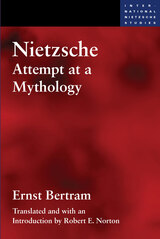 Nietzsche: Attempt at a Mythology
Ernst Bertram. Translated and with an Introduction by Robert E. Norton
University of Illinois Press, 2008 The only English translation of a crucial interpretation of Nietzsche First published in 1918, Ernst Bertram's Nietzsche: Attempt at a Mythology substantially shaped the image of Nietzsche for the generation between the wars. It won the Nietzsche Society's first prize and was admired by luminous contemporaries including André Gide, Hermann Hesse, Gottfried Benn, and Thomas Mann. Although translated into French in 1932, the book was never translated into English following the decline of Nietzsche's and Bertram's reputations after 1945. Now, with Nietzsche's importance for twentieth-century thought undisputed, the work by one of his most influential interpreters can at last be read in English. Employing a perspectival technique inspired by Nietzsche himself, Bertram constructs a densely layered portrait of the thinker that shows him riven by deep and ultimately irresolvable cultural, historical, and psychological conflicts. At once lyrical and intensely probing, richly complex yet thematically coherent, Bertram's book is a masterpiece in a forgotten tradition of intellectual biography.
 The Nietzsche Canon: A Publication History and Bibliography
William H. Schaberg
University of Chicago Press, 1996 Although the past several years have witnessed an outpouring of scholarship on nearly every aspect of Nietzsche's thought, a portrait of Nietzsche as author has been conspicuously lacking. Here, William H. Schaberg presents a detailed publication history and biography of Nietzsche as author and an equally comprehensive annotated bibliography of his work. Schaberg describes how and why Nietzsche's books were written, when and by whom they were published, and how many copies were printed and sold, a story set against the background of publishing practice in nineteenth-century Germany. Schaberg establishes a genealogy of Nietzsche's works and clarifies the relationships between those works, an understanding of which is essential to any informed opinion of his philosophy.
Included for the first time in any language is an extensive account of Nietzsche's finances and his relationships with his publishers. Schaberg reveals a man who was obsessed with money, fought bitterly with his publishers, complained about his readers, and all the while continued to produce more and more books that went unread. He also reveals the influential role of Nietzsche's sister Elizabeth, who provoked disputes between Nietzsche and his publisher during her brother's lifetime and deliberately falsified information after his death.
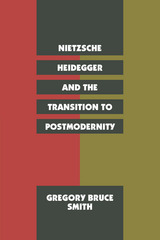 Nietzsche, Heidegger, and the Transition to Postmodernity
Gregory Bruce Smith
University of Chicago Press, 1995 Among the most influential and enigmatic thinkers of the modern age, Nietzsche and Heidegger have become pivotal in the struggle to define postmodernism. In this work, Gregory Smith offers the most comprehensive examination to date of the turn to postmodernity in the writings of these philosophers.
Smith argues that, while much of postmodern thought is rooted in Nietzsche and Heidegger, it has ironically attempted, whether unwittingly or by design, to deflect their philosophy back onto a modern path. Other alternative paths emanating from both Nietzschean and Heideggerian thought that might more powerfully speak to postmodern culture have been ignored. Nietzsche and Heidegger, Smith suggests, have made possible a far more revolutionary critique of modernity then even their most ardent postmodern admirers have realized.
Smith contends that the influences on the postmodern in the thought of Nietzsche and Heidegger are founded in a new vision of praxis liberated from theory. Ultimately, these philosophers do transcend the nihilism often found in the guise of postmodernism. Their thought is, moreover, consistent with the possibility of limited constitutional government and the rule of law. Smith's book takes the first step toward recovering these possibilities and posing the fundamental questions of politics and ethics in ways that have heretofore been closed off by late-modern thought.
Nietzsche: His Philosophy of Contradictions and the Contradictions of His Philosophy
Wolfgang Muller-Lauter
University of Illinois Press, 1999 This is the first translation into English of a milestone in Nietzsche interpretation. Wolfgang Müller-Lauter examines Nietzsche's doctrines of the will to power and the overman in light of Nietzsche's philosophy of real contradictions. He shows that Nietzsche's vision of inherently contradictory "wills to power" is the source of irresolvable contradictions in his philosophy.
Müller-Lauter has remained at the forefront of German Nietzsche studies throughout the quarter century since this book first appeared. This long-awaited translation, containing two substantial subsequent essays, is a major addition to the English-language Nietzsche literature
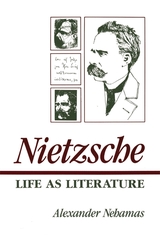 Nietzsche: Life as Literature
Alexander Nehamas
Harvard University Press, 1985 More than eighty years after his death, Nietzsche’s writings and his career remain disquieting, disturbing, obscure. His most famous views—the will to power, the eternal recurrence, the Übermensch, the master morality—often seem incomprehensible or, worse, repugnant. Yet he remains a thinker of singular importance, a great opponent of Hegel and Kant, and the source of much that is powerful in figures as diverse as Wittgenstein, Derrida, Heidegger, and many recent American philosophers.
Alexander Nehamas provides the best possible guide for the perplexed. He reveals the single thread running through Nietzsche’s views: his thinking of the world on the model of a literary text, of people as if they were literary characters, and of knowledge and science as if they were literary interpretation. Beyond this, he advances the clarity of the concept of textuality, making explicit some of the forces that hold texts together and so hold us together. Nehamas finally allows us to see that Nietzsche is creating a literary character out of himself, that he is, in effect, playing the role of Plato to his own Socrates.
Nehamas discusses a number of opposing views, both American and European, of Nietzsche’s texts and general project, and reaches a climactic solving of the main problems of Nietzsche interpretation in a step-by-step argument. In the process he takes up a set of very interesting questions in contemporary philosophy, such as moral relativism and scientific realism. This is a book of considerable breadth and elegance that will appeal to all curious readers of philosophy and literature.
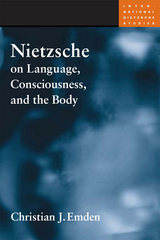 Nietzsche on Language, Consciousness, and the Body
Christian J. Emden
University of Illinois Press, 2005 Nietzsche and the philosopy of language have been a well trafficked crossroads for a generation, but almost always as a checkpoint for post-modernism and its critics. This work takes a historical approach to Nietzsche’s work on language, connecting it to his predecessors and contemporaries rather than his successors. Though Nietzsche invited identification with Zarathustra, the solitary wanderer ahead of his time, for most of his career he directly engaged the intellectual currents and scientific debates of his time.
Emden situates Nietzsche’s writings on language and rhetoric within their wider historical context. He demonstrates that Nietzsche is not as radical in his thinking as has been often supposed, and that a number of problems with Nietzsche disappear when Nietzsche’s works are compared to works on the same subjects by writers of the 18th and 19th centuries. Further, the relevance of rhetoric and the history of rhetoric to philosophy and the history of philosophy is reasserted, in consonance with Nietzsche’s own statements and practices. Important in this regard are the role of fictions, descriptions, and metaphor.
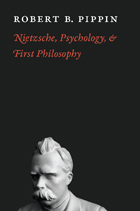 Nietzsche, Psychology, and First Philosophy
Robert B. Pippin
University of Chicago Press, 2010 Friedrich Nietzsche is one of the most elusive thinkers in the philosophical tradition. His highly unusual style and insistence on what remains hidden or unsaid in his writing make pinning him to a particular position tricky. Nonetheless, certain readings of his work have become standard and influential. In this major new interpretation of Nietzsche’s work, Robert B. Pippin challenges various traditional views of Nietzsche, taking him at his word when he says that his writing can best be understood as a kind of psychology.
Pippin traces this idea of Nietzsche as a psychologist to his admiration for the French moralists: La Rochefoucauld, Pascal, Stendhal, and especially Montaigne. In distinction from philosophers, Pippin shows, these writers avoided grand metaphysical theories in favor of reflections on life as lived and experienced. Aligning himself with this project, Nietzsche sought to make psychology “the queen of the sciences” and the “path to the fundamental problems.” Pippin contends that Nietzsche’s singular prose was an essential part of this goal, and so he organizes the book around four of Nietzsche’s most important images and metaphors: that truth could be a woman, that a science could be gay, that God could have died, and that an agent is as much one with his act as lightning is with its flash.
Expanded from a series of lectures Pippin delivered at the Collège de France, Nietzsche, Psychology, and First Philosophy offers a brilliant, novel, and accessible reading of this seminal thinker.
Nietzsche Pursued: Toward a Philosophy for the Future
Richard Schacht
University of Chicago Press, 2024 An ambitious venture into Nietzsche’s envisioned philosophy for the future.
Nietzsche advocated for a post-theistic “philosophy of the future”—a new approach to human reality that would bend Western thought away from nihilism in a life-affirming, value-creative direction. His early demise left this endeavor only just begun. In Nietzsche Pursued, Richard Schacht examines Nietzsche’s revisionist approach to familiar philosophical topics, exploring how some may be further pursued in Nietzschean ways.
Each chapter focuses on one topic that is central to Nietzsche's vision of what philosophy can and should be and do. Among them: his kind of naturalism, humanity, perspectivism, morality, and music. Building on his analysis in Nietzsche’s Kind of Philosophy, Schacht invites readers to see with new appreciation the ongoing significance of Nietzsche’s thought for philosophy’s future.
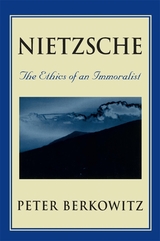 Nietzsche: The Ethics of an Immoralist
Peter Berkowitz
Harvard University Press, 1995 Once regarded as a conservative critic of culture, then enlisted by the court theoreticians of Nazism, Nietzsche has come to be revered by postmodern thinkers as one of their founding fathers, a prophet of human liberation who revealed the perspectival character of all knowledge and broke radically with traditional forms of morality and philosophy.
In Nietzsche: The Ethics of an Immoralist, Peter Berkowitz challenges this new orthodoxy, asserting that it produces a one-dimensional picture of Nietzsche's philosophical explorations and passes by much of what is provocative and problematic in his thought. Berkowitz argues that Nietzsche's thought is rooted in extreme and conflicting opinions about metaphysics and human nature. Discovering a deep unity in Nietzsche's work by exploring the structure and argumentative movement of a wide range of his books, Berkowitz shows that Nietzsche is a moral and political philosopher in the Socratic sense whose governing question is, "What is the best life?"
Nietzsche, Berkowitz argues, puts forward a severe and aristocratic ethics, an ethics of creativity, that demands that the few human beings who are capable acquire a fundamental understanding of and attain total mastery over the world. Following the path of Nietzsche's thought, Berkowitz shows that this mastery, which represents a suprapolitical form of rule and entails a radical denigration of political life, is, from Nietzsche's own perspective, neither desirable nor attainable.
Out of the colorful and richly textured fabric of Nietzsche's books, Peter Berkowitz weaves an interpretation of Nietzsche's achievement that is at once respectful and skeptical, an interpretation that brings out the love of truth, the courage, and the yearning for the good that mark Nietzsche's magisterial effort to live an examined life by giving an account of the best life.
 Nietzsche's Corps/e: Aesthetics, Politics, Prophecy, or, the Spectacular Technoculture of Everyday Life
Geoff Waite
Duke University Press, 1996 Appearing between two historical touchstones—the alleged end of communism and the 100th anniversary of Nietzsche’s death—this book offers a provocative hypothesis about the philosopher’s afterlife and the fate of leftist thought and culture. At issue is the relation of the dead Nietzsche (corpse) and his written work (corpus) to subsequent living Nietzscheanism across the political spectrum, but primarily among a leftist corps that has been programmed and manipulated by concealed dimensions of the philosopher’s thought. If anyone is responsible for what Geoff Waite maintains is the illusory death of communism, it is Nietzsche, the man and concept.
Waite advances his argument by bringing Marxist—especially Gramscian and Althusserian—theories to bear on the concept of Nietzsche/anism. But he also goes beyond ideological convictions to explore the vast Nietzschean influence that proliferates throughout the marketplace of contemporary philosophy, political and literary theory, and cultural and technocultural criticism. In light of a philological reconstruction of Nietzsche’s published and unpublished texts, Nietzsche’s Corps/e shuttles between philosophy and everyday popular culture and shows them to be equally significant in their having been influenced by Nietzsche—in however distorted a form and in a way that compromises all of our best interests.
Controversial in its “decelebration” of Nietzsche, this remarkable study asks whether the postcontemporary age already upon us will continue to be dominated and oriented by the haunting spectre of Nietzsche’s corps/e. Philosophers, intellectual historians, literary theorists, and those interested in western Marxism, popular culture, Friedrich Nietzsche, and the intersection of French and German thought will find this book both appealing and challenging.
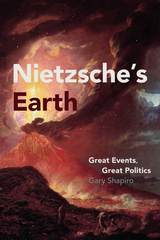 Nietzsche's Earth: Great Events, Great Politics
Gary Shapiro
University of Chicago Press, 2016 We have Nietzsche to thank for some of the most important accomplishments in intellectual history, but as Gary Shapiro shows in this unique look at Nietzsche’s thought, the nineteenth-century philosopher actually anticipated some of the most pressing questions of our own era. Putting Nietzsche into conversation with contemporary philosophers such as Deleuze, Agamben, Foucault, Derrida, and others, Shapiro links Nietzsche’s powerful ideas to topics that are very much on the contemporary agenda: globalization, the nature of the livable earth, and the geopolitical categories that characterize people and places.
Shapiro explores Nietzsche’s rejection of historical inevitability and its idea of the end of history. He highlights Nietzsche’s prescient vision of today’s massive human mobility and his criticism of the nation state’s desperate efforts to sustain its exclusive rule by declaring emergencies and states of exception. Shapiro then explores Nietzsche’s vision of a transformed garden earth and the ways it sketches an aesthetic of the Anthropocene. He concludes with an explanation of the deep political structure of Nietzsche’s “philosophy of the Antichrist,” by relating it to traditional political theology. By triangulating Nietzsche between his time and ours, between Bismarck’s Germany and post-9/11 America, Nietzsche’s Earth invites readers to rethink not just the philosopher himself but the very direction of human history.
 Nietzsche's Earthbound Wisdom: The Philosopher, the Poet, and the Sage
Keith Ansell-Pearson
University of Chicago Press, 2025 An incisive exploration of Nietzsche as a bold, visionary poet-philosopher.
Today, Nietzsche is justly celebrated for his rich, philosophical naturalism, but Keith Ansell-Pearson warns that we must not overlook the visionary dimension of his thinking and his focus on the need to cultivate a new care of the self and care of life. In Nietzsche’s Earthbound Wisdom, Ansell-Pearson recovers Nietzsche’s love for a philosophy that guides us through our passions, one that opens us more fully to the possibilities of life and the joy of knowledge.
Ansell-Pearson offers close readings of Nietzsche’s texts in conversation with philosophical and literary figures including Augustine, Baudelaire, Carlyle, Dostoevsky, Emerson, Flaubert, Stendhal, and more. Throughout, Ansell-Pearson examines Nietzsche’s sophisticated critique of literary naturalism and his alternative conception of the poet as a seer who has a deep longing for a new earth.
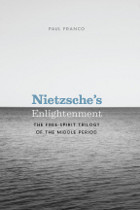 Nietzsche's Enlightenment: The Free-Spirit Trilogy of the Middle Period
Paul Franco
University of Chicago Press, 2011 While much attention has been lavished on Friedrich Nietzsche’s earlier and later works, those of his so-called middle period have been generally neglected, perhaps because of their aphoristic style or perhaps because they are perceived to be inconsistent with the rest of his thought. With Nietzsche’s Enlightenment, Paul Franco gives this crucial section of Nietzsche’s oeuvre its due, offering a thoughtful analysis of the three works that make up the philosopher’s middle period: Human, All too Human; Daybreak; and The Gay Science. It is Nietzsche himself who suggests that these works are connected, saying that their “common goal is to erect a new image and ideal of the free spirit.” Franco argues that in their more favorable attitude toward reason, science, and the Enlightenment, these works mark a sharp departure from Nietzsche’s earlier, more romantic writings and differ in important ways from his later, more prophetic writings, beginning with Thus Spoke Zarathustra. The Nietzsche these works reveal is radically different from the popular image of him and even from the Nietzsche depicted in much of the secondary literature; they reveal a rational Nietzsche, one who preaches moderation instead of passionate excess and Dionysian frenzy. Franco concludes with a wide-ranging examination of Nietzsche’s later works, tracking not only how his outlook changes from the middle period to the later but also how his commitment to reason and intellectual honesty in his middle works continues to inform his final writings.
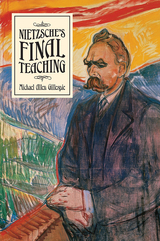 Nietzsche's Final Teaching
Michael Allen Gillespie
University of Chicago Press, 2017 In the seven and a half years before his collapse into madness, Nietzsche completed Thus Spoke Zarathustra, the best-selling and most widely read philosophical work of all time, as well as six additional works that are today considered required reading for Western intellectuals. Together, these works mark the final period of Nietzsche’s thought, when he developed a new, more profound, and more systematic teaching rooted in the idea of the eternal recurrence, which he considered his deepest thought.
Cutting against the grain of most current Nietzsche scholarship, Michael Allen Gillespie presents the thought of the late Nietzsche as Nietzsche himself intended, drawing not only on his published works but on the plans for the works he was unable to complete, which can be found throughout his notes and correspondence. Gillespie argues that the idea of the eternal recurrence transformed Nietzsche’s thinking from 1881 to 1889. It provided both the basis for his rejection of traditional metaphysics and the grounding for the new logic, ontology, theology, and anthropology he intended to create with the aim of a fundamental transformation of European civilization, a “revaluation of all values.” Nietzsche first broached the idea of the eternal recurrence in Thus Spoke Zarathustra, but its failure to gain attention or public acceptance led him to present the idea again through a series of works intended to culminate in a never-completed magnum opus. Nietzsche believed this idea would enable the redemption of humanity. At the same time, he recognized its terrifying, apocalyptic consequences, since it would also produce wars of unprecedented ferocity and destruction.
Through his careful analysis, Gillespie reveals a more radical and more dangerous Nietzsche than the humanistic or democratic Nietzsche we commonly think of today, but also a Nietzsche who was deeply at odds with the Nietzsche imagined to be the forefather of Fascism. Gillespie’s essays examine Nietzsche’s final teaching—its components and its political, philosophical, and theological significance. The book concludes with a critical examination and a reflection on its meaning for us today.
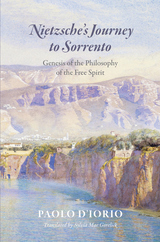 Nietzsche's Journey to Sorrento: Genesis of the Philosophy of the Free Spirit
Paolo D'Iorio
University of Chicago Press, 2016 “When for the first time I saw the evening rise with its red and gray softened in the Naples sky,” Nietzsche wrote, “it was like a shiver, as though pitying myself for starting my life by being old, and the tears came to me and the feeling of having been saved at the very last second.” Few would guess it from the author of such cheery works as The Birth of Tragedy, but as Paolo D’Iorio vividly recounts in this book, Nietzsche was enraptured by the warmth and sun of southern Europe. It was in Sorrento that Nietzsche finally matured as a thinker.
Nietzsche first voyaged to the south in the autumn of 1876, upon the invitation of his friend, Malwida von Meysenbug. The trip was an immediate success, reviving Nietzsche’s joyful and trusting sociability and fertilizing his creative spirit. Walking up and down the winding pathways of Sorrento and drawing on Nietzsche’s personal notebooks, D’Iorio tells the compelling story of Nietzsche’s metamorphosis beneath the Italian skies. It was here, D’Iorio shows, that Nietzsche broke intellectually with Wagner, where he decided to leave his post at Bâle, and where he drafted his first work of aphorisms, Human, All Too Human, which ushered in his mature era. A sun-soaked account of a philosopher with a notoriously overcast disposition, this book is a surprising travelogue through southern Italy and the history of philosophy alike.
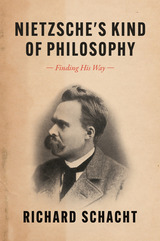 Nietzsche's Kind of Philosophy: Finding His Way
Richard Schacht
University of Chicago Press, 2023 A holistic reading of Nietzsche’s distinctive thought beyond the “death of God.”
In Nietzsche’s Kind of Philosophy, Richard Schacht provides a holistic interpretation of Friedrich Nietzsche’s distinctive thinking, developed over decades of engagement with the philosopher’s work. For Schacht, Nietzsche’s overarching project is to envision a “philosophy of the future” attuned to new challenges facing Western humanity after the “death of God,” when monotheism no longer anchors our understanding of ourselves and our world. Schacht traces the developmental arc of Nietzsche’s philosophical efforts across Human, All Too Human, Daybreak, Joyful Knowing (The Gay Science), Thus Spoke Zarathustra, Beyond Good and Evil, and On the Genealogy of Morality. He then shows how familiar labels for Nietzsche—nihilist, existentialist, individualist, free spirit, and naturalist—prove insufficient individually but fruitful if refined and taken together. The result is an expansive account of Nietzsche’s kind of philosophy.
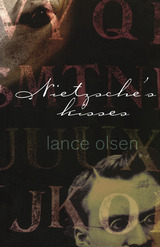 Nietzsche's Kisses: A Novel
Lance Olsen
University of Alabama Press, 2006 Nietzsche's Kisses is the story of Friedrich Nietzsche's last mad night on earth. Locked in a small room on the top floor of a house in Weimar, the most radical and influential of nineteenth-century German philosophers hovers between dream and wakefulness, memory and hallucination, the first person, second, and third, past and present, reliving his brief love affair with feminist Lou Salome, his stormy association with Richard Wagner, and his conflicted relationship with Lisbeth, his radibly anti-Semitic sister. Here is an authoritative portrait of the Nietzsche we know and the Nietzsche we don't. His titantic ego, suppressed, squelched, and sealed up within him, all but unknown to his acquaintances, creates a maniacal and raging giant inside his own skull that is mysterious and unnerving. Both stylistically and formally innovative, the prose in Nietzsche's Kisses is surprising and rich. The result is a vivid, complex experience of Nietzsche's final hours.
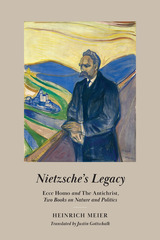 Nietzsche's Legacy: "Ecce Homo" and "The Antichrist," Two Books on Nature and Politics
Heinrich Meier
University of Chicago Press, 2024 A reappraisal of Ecce Homo and The Antichrist within Nietzsche’s oeuvre. Nietzsche's Legacy takes on the most challenging and misunderstood works in Nietzsche’s oeuvre to illuminate his view of what a philosopher is and what constitutes a philosophic life. Interpreting Ecce Homo and The Antichrist as twin books meant to replace the abandoned Will to Power project, Heinrich Meier recovers them from the stigma of Nietzsche’s late mental collapse, showing that these works are, above all, a lucid self-assessment. The carefully written pair contains both the highest affirmation—the Yes of the “revaluation of all values”—and the most resolute negation—the No to Christianity. How the Yes and the No go together, how the relation between nature and politics is to be determined, how Nietzsche’s intention is governing the political-philosophical double-face: this is the subject of Nietzsche’s Legacy, which opens up a new understanding of Nietzsche’s philosophy as a whole.
Nietzsche's New Seas: Explorations in Philosophy, Aesthetics, and Politics
Edited by Michael Allen Gillespie and Tracy B. Strong
University of Chicago Press, 1988 Nietzsche's New Seas makes available for the first time in English a representative sample of the best recent Nietzsche scholarship from Germany, France, and the United States. Michael Allen Gillespie and Tracy B. Strong have brought together scholars from a variety of disciplines—philosophy, history, literary criticism, and musicology—and from schools of thought that differ both methodologically and ideologically. The contributors—Karsten Harries, Robert Pippin, Eugen Fink, Hans-Georg Gadamer, Kurt Paul Janz, Sarah Kofman, Jean-Michel Rey, and the editors themselves—take a new approach to Nietzsche, one that begins with the claim that his enigmatic utterances can best be understood by examining the style or structure of his thought.
 Nietzsche's Perspectivism
Steven Hales and Rex Welshon
University of Illinois Press, 2000 In Nietzsche's Perspectivism, Steven Hales and Rex Welshon offer an analytic approach to Nietzsche's important idea that truth is perspectival. Drawing on Nietzsche's entire published corpus, along with manuscripts he never saw to press, they assess the different perspectivisms at work in Nietzsche's views with regard to truth, logic, causality, knowledge, consciousness, and the self. They also examine Nietzsche's perspectivist ontology of power and the attendant claims that substances and subjects are illusory while forces and alliances of power constitute the only reality.
Hales and Welshon present Nietzsche's treatment of perspectivism as both more complex and more fruitful than the common view of it as a doctrine that truth is not objective. Neither a metaphor nor a methodology, perspectivism emerges as a protean concept akin to a unifying theme; an alternative to the absolutism that recurs in science, philosophy, and religion; and a technique for revealing the unimagined possibilities open to every individual.
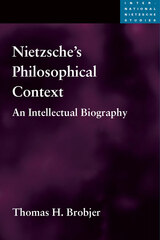 Nietzsche's Philosophical Context: An Intellectual Biography
Thomas Brobjer
University of Illinois Press, 2007 Friedrich Nietzsche was immensely influential and, counter to most expectations, also very well read. An essential new reference tool for those interested in his thinking, Nietzsche’s Philosophical Context identifies the chronology and huge range of philosophical books that engaged him. Rigorously examining the scope of this reading, Thomas H. Brobjer consulted over two thousand volumes in Nietzsche’s personal library, as well as his book bills, library records, journals, letters, and publications. This meticulous investigation also considers many of the annotations in his books. In arguing that Nietzsche’s reading often constituted the starting point for, or counterpoint to, much of his own thinking and writing, Brobjer’s study provides scholars with fresh insight into how Nietzsche worked and thought; to which questions and thinkers he responded; and by which of them he was influenced. The result is a new and much more contextual understanding of Nietzsche's life and thinking.
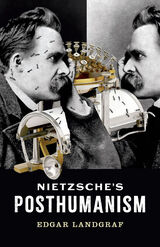 Nietzsche's Posthumanism
Edgar Landgraf
University of Minnesota Press, 2023 A timely and trenchant commentary on the centrality of Nietzsche’s thought for our time
While many posthumanists claim Nietzsche as one of their own, rarely do they engage his philosophy in any real depth. Nietzsche’s Posthumanism addresses this need by exploring the continuities and disagreements between Nietzsche’s philosophy and contemporary posthumanism. Focusing specifically on Nietzsche’s reception of the life sciences of his day and his reflections on technology—research areas as central to Nietzsche’s work as they are to posthumanism—Edgar Landgraf provides fresh readings of Nietzsche and a critique of post- and transhumanist philosophies. Through Landgraf’s inquiry, lesser-known aspects of Nietzsche’s writings emerge, including the neurophysiological basis of his epistemology (which anticipates contemporary debates on embodiment), his concerns with insects and the emergent social properties they exhibit, and his reflections on the hominization and cultivation effects of technology. In the process, Landgraf challenges major commonplaces about Nietzsche’s philosophy, including the idea that his social theory asserts the rights of “the strong” over “the weak.” The ethos of critical posthumanism also offers a new perspective on key ethical and political contentions of Nietzsche’s writings. Nietzsche’s Posthumanism presents a uniquely framed introduction to tenets of Nietzsche’s thought and major trends in posthumanism, making it an essential exploration for anyone invested in Nietzsche and his contemporary relevance, and in posthumanism and its genealogy. Retail e-book files for this title are screen-reader friendly.
Nietzsche's Revaluation of Values: A STUDY IN STRATEGIES
E. E. Sleinis
University of Illinois Press, 1994 Nietzsche's Revaluation of Values is an assessment of Nietzsche's challenging plan to revalue all values, including knowledge, morality, religion, art, and the state. E. E. Sleinis analyzes the success of Nietzsche's enterprise as well as its inadequacies; among the positive contributions he singles out Nietzsche's theory of value, his conception of higher-order values, and his conception of the maximally affirmative attitude as creations of enduring importance.
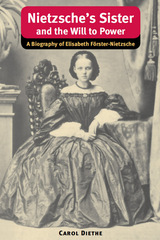 Nietzsche's Sister and the Will to Power: A Biography of Elisabeth Förster-Nietzsche
Carol Diethe
University of Illinois Press, 2002 A penetrating study of the sister who betrayed and endangered her famous brother's legacy In 1901, a year after her brother Friedrich's death, Elisabeth Förster-Nietzsche published The Will to Power, a hasty compilation of writings he had never intended for print. In Nietzsche's Sister and the Will to Power, Carol Diethe contends that Förster-Nietzsche's own will to power and her desire to place herself--not her brother--at the center of cultural life in Germany are centrally responsible for Nietzsche's reputation as a belligerent and proto-Fascist thinker. Offering a new look at Nietzsche's sister from a feminist perspective, this spirited and erudite biography examines why Elisabeth Förster-Nietzsche recklessly consorted with anti-Semites, from her own husband to Hitler himself, out of convenience and a desire for revenge against a brother whose love for her waned after she caused the collapse of his friendship with Lou Salomé. The book also examines their family dynamics, Nietzsche's dismissal of his sister's early writing career, and the effects of limited education on intelligent women. Diethe concludes by detailing Förster-Nietzsche's brief marriage and her subsequent colonial venture in Paraguay, maintaining that her sporadic anti-Semitism was, like most things in her life, an expedient tool for cultivating personal success and status. A volume in the series International Nietzsche Studies, edited by Richard Schacht
Nigerian Video Films: Revised and Expanded Edition
Jonathan Haynes
Ohio University Press, 2000 Nigerian video films—dramatic features shot on video and sold as cassettes—are being produced at the rate of nearly one a day, making them the major contemporary art form in Nigeria. The history of African film offers no precedent for such a huge, popularly based industry. The contributors to this volume, who include film and television directors, an anthropologist, and scholars of film studies and literature, take a variety of approaches to this flourishing popular art. Topics include aesthetic forms and distribution; the configurations of various ethnic audiences; the new media environment dominated by cassette technology; the video’s materialism in a period of economic collapse; transformation of the traditional Yoruba traveling theater; individualism and the moral crisis in Igbo society; Hausa cultural values; the negotiation of gender roles, and the genre of Christian videos.
 Nigger Heaven
Carl Van Vechten
University of Illinois Press, 1926 No other contemporary novel received the volume and intensity of criticism and curiosity that greeted Nigger Heaven upon its publication in 1926. Carl Van Vechten's novel generated a storm of controversy because of its scandalous title and fed an insatiable hunger on the part of the reading public for material relating to the black culture of Harlem's jazz clubs, cabarets, and social events.
"The book and not the title is the thing," James Weldon Johnson insisted with regard to Nigger Heaven, and the book is indeed a nuanced and vibrant portrait of "the great black walled city" of Harlem. Opening on a scene of tawdry sensationalism, Nigger Heaven shifts decisively to a world of black middle-class respectability, defined by intellectual values, professional ambition, and an acute consciousness of class and racial identity.
Here is a Harlem where upper-class elites discuss art in well-appointed drawing rooms; rowdy and lascivious drunks spend long nights in jazz clubs and speakeasies; and politically conscious young intellectuals drink coffee and debate "the race problem" in walk-up apartments. At the center of the story, two young people--a quiet, serious librarian and a volatile aspiring writer--struggle to love each other as their dreams are slowly suffocated by racism.
This reissue is based on the seventh printing, which included poetry composed by Langston Hughes especially for the book. Kathleen Pfeiffer's astute introduction investigates the controversy surrounding the shocking title and shows how the novel functioned in its time as a site to contest racial violence. She also signals questions of racial authenticity and racial identity raised by a novel about black culture written by a white admirer of that culture.
 Night After Night
Diana Starr Cooper
Island Press, 1994 "Seen from across a field at night, with its swags of white lights scalloped from mast to mast against the sky, it looks like an ocean liner far out on the water. Yet it is still a tent. It appears on Monday, in what was an empty field on Sunday. While it's there, it forms the landscape around it in a new way, transforming its meanings just as horses do when they walk into a pasture. A week later, there's an empty field again. The tent is gone, and so is the little village of trucks and trailers that clustered around it as if it were a castle. Did I dream it?" --from Night After NightNight After Night is an enrapturing meditation on a small, traditional, one-ring circus. Diana Cooper delights us with the realization that circus is more than mere entertainment. It is a splendid classical art form, grounded in venerable skills and traditions, with its deepest sources in the vitality of myth, ritual, fantasy, fear, wonder, laughter, and awe.Throughout the book, Cooper raises important issues such as human/animal communication and coexistence, permutations of fantasy and reality, the beauties of diversity, and notions about what is, and is not natural. Her love of and respect for the culture of circus -- the forms and understandings that enable it to bring joy to all it touches- infuse every page of this literary treasure.
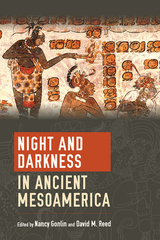 Night and Darkness in Ancient Mesoamerica
Nancy Gonlin
University Press of Colorado, 2021 Night and Darkness in Ancient Mesoamerica is the first volume to explicitly incorporate how nocturnal aspects of the natural world were imbued with deep cultural meanings and expressed by different peoples from various time periods in Mexico and Central America. Material culture, iconography, epigraphy, art history, ethnohistory, ethnographies, and anthropological theory are deftly used to illuminate dimensions of darkness and the night that are often neglected in reconstructions of the past.
The anthropological study of night and darkness enriches and strengthens the understanding of human behavior, power, economy, and the supernatural. In eleven case studies featuring the residents of Teotihuacan, the Classic period Maya, inhabitants of Rio Ulúa, and the Aztecs, the authors challenge archaeologists to consider the influence of the ignored dimension of the night and the role and expression of darkness on ancient behavior. Chapters examine the significance of eclipses, burials, tombs, and natural phenomena considered to be portals to the underworld; animals hunted at twilight; the use and ritual meaning of blindfolds; night-blooming plants; nocturnal foodways; fuel sources and lighting technology; and other connected practices.
Night and Darkness in Ancient Mesoamerica expands the scope of published research and media on the archaeology of the night. The book will be of interest to those who study the humanistic, anthropological, and archaeological aspects of the Aztec, Maya, Teotihuacanos, and southeastern Mesoamericans, as well as sensory archaeology, art history, material culture studies, anthropological archaeology, paleonutrition, socioeconomics, sociopolitics, epigraphy, mortuary studies, volcanology, and paleoethnobotany.
Contributors: Jeremy Coltman, Christine Dixon, Rachel Egan, Kirby Farah, Carolyn Freiwald, Nancy Gonlin, Julia Hendon, Cecelia Klein, Jeanne Lopiparo, Brian McKee, Jan Marie Olson, David M. Reed, Payson Sheets, Venicia Slotten, Michael Thomason, Randolph Widmer, W. Scott Zeleznik
 Night breaks apart, like pomegranate seeds in my palm: Poems
Aakriti Kuntal
Seagull Books, 2025 Aakriti Kuntal wields language like a blade and a balm, carving out poetry that is urgent and unafraid to ask what it means to exist.
What does it mean to exist within language—to shape it, and in turn, to be shaped by it? In Night breaks apart, like pomegranate seeds in my palm, Aakriti Kuntal crafts poems that unravel at the edges of self and myth, where language is neither home nor escape, but a threshold to something more elemental. Her verses move like water rolling and sifting through sediment, shifting between dream and flesh. Through intimate confessions and stark observations, she confronts the absurdity of suffering, the weight of the body, and the vast, unknowable machinery of the universe. Each poem resists easy meaning, instead offering raw honesty: language as both wound and salve.
For readers drawn to the introspective and the experimental, Kuntal’s poetry echoes the emotional depth of Ocean Vuong and the intellectual play of Anne Carson. This collection is for those who seek poetry not as answers, but as an experience—visceral, and unafraid to press against the limits of being.
Night Burial
Kate Bolton Bonnici
University Press of Colorado, 2020 In Night Burial, Kate Bolton Bonnici mourns her mother’s death from ovarian cancer by tracing the composition, decomposition, and recomposition of the maternal body. Opening with an epigraph from Julia Kristeva’s Stabat Mater, which recognizes the “abyss that opens up between the body and what had been its inside,” Night Burial moves from breastfeeding to laying sod on a grave, weaving together Alabama pine forests, fairy tales, philosophy, classical and Renaissance literatures, church practices, and hospice care. Through centuries-old and newly imagined poetic forms, Night Burial crafts a haunting litany for the dead. These poems ask the essential questions of grief, intertwined with family and place: how do we address the absent beloved and might the poem become its own conjuring whereby the I can once again speak to the you?
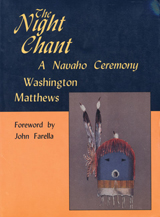 The Night Chant: A Navaho Ceremony
Washington Matthews
University of Utah Press, 1995 The Night Chant is one of the great nine-day, Navajo winter healing ceremonies. During its course, nearly all the important characters of the Navajo pantheon are mentioned in legends, depicted in sand paintings, and impersonated with the use of masks and other ritual objects. Originally published in 1902, Washington Matthews's The Night Chant contains one of the few extensive descriptions of this important ceremony. Washington Matthews studied Navajo language and lifeways as an ethnologist and linguistics expert in the late-nineteenth century. His unique opportunities to observe ceremonies and record the roles of participants resulted in landmark studies of Navajo ritual and tradition. Matthews spent more than twenty years working with hatathli, or singers, to record the many songs and rites that comprise the intricate Night Chant. provides a detailed description of healing rites, songs, myths, and prayers for the ceremony, which is performed only during 'frosty weather.' This edition includes powerful contemporary observations in a foreword by John Farella.
Night Clerk at the Hotel of Both Worlds
Angela Ball
University of Pittsburgh Press, 2007 Winner of the 2006 Donald Hall Prize in Poetry.
Angela Ball’s lyrical, wry, and rueful poems float on a river of incongruities on which we may find Ron Popeil, Lord Byron, and Rudyard Kipling sharing the same raft; they create a fascinating commerce between the sublime and the ridiculous.
Night Garden: A Novel
Carrie Mullins
Ohio University Press, 2016 A harrowing, redemptive coming-of-age journey from youthful innocence to the darkest levels of addiction and human experience. When tragedy strikes her family, seventeen-year-old Marie Massey runs away from a safe, privileged life in her small college town and into the arms of a much older man in a neighboring Kentucky county. Though innocent at first, Marie’s budding relationship with the charismatic, thirty-year-old Bobo Owens and his family of bootleggers and drug dealers sets in motion a cataclysmic chain of events from which no one will emerge unscathed. In this stark reflection of the many challenges rural young people face in the heart of the opioid epidemic, debut novelist Carrie Mullins presents a haunting narrative about the ways addiction can destroy American communities. Published in 2016 by Old Cove Press
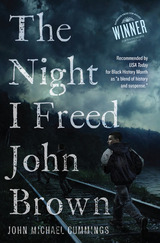 The Night I Freed John Brown
John Michael Cummings
West Virginia University Press, 2016 Winner of The Paterson Prize for Books for Young People Recommended by USA Today for Black History Month as "a blend of history and suspense." In this novel for young adults, Josh knows there is something about the tall Victorian House on the Harpers Ferry Hill, the one his father grew up in, that he can’t quite put his finger on. And his impossible father won’t give him any clues. He’s hiding something. And then there’s the famous John Brown. The one who all the tourists come to hear about. The one whose statue looms over Josh’s house. Why does he seem to haunt Josh and his whole family? When the fancy Richmonds come to town and move right next door, their presence forces Josh to find the answers and stand up to the secrets of the House, to his father—and to John Brown, too. The historic village of Harpers Ferry comes alive in this young boy’s brave search for answers and a place of his own in this brilliant first novel by John Michael Cummings.
Night in Erg Chebbi and Other Stories
Edward Hamlin
University of Iowa Press, 2015 Night in Erg Chebbi and Other Stories spans the globe, taking us from Belfast to Brazil, Morocco to Manhattan. The teenaged daughter of an IRA assassin flees Northern Ireland only to end up in Baby Doc’s terrifying Haiti. An American woman who’s betrayed her brother only to lose him to a Taliban bullet comes face to face with her demons during a vacation in Morocco. A famed photojournalist must find a way to bring her life’s work to closure before she goes blind, a quest that changes her understanding of the very physics of light.
By turns innocent and canny, the characters of Night in Erg Chebbi and Other Stories must learn to improvise—quickly—when confronted with stark choices they never dreamed they’d have to make. Lyrical, immaculately constructed and deeply felt, these nine stories take us far beyond our comfort zones and deep into the wilds of the human heart.
A Night in the Emperor's Garden: A True Story of Hope and Resilience in Afghanistan
Qais Akbar Omar and Stephen Landrigan
Haus Publishing, 2015 In 2005, everything seemed possible in Afghanistan. The Taliban was gone. A new government had been elected. A cultural renaissance was energizing the country.
An actress visiting from Paris casually proposed to some Afghan actors in Kabul: Why not put on a play? The challenges were huge. It had been thirty years since men and women had appeared on stage together in Afghanistan. Was the country ready for it? Few Afghan actors had ever done theater. Did they even know how? They had performed only in films and television dramas.
Still, a company of actors gathered—among them a housewife, a policewoman, and a street kid turned film star. With no certainty of its outcome, they set out on a journey that would have life-changing consequences for all of them, and along the way lead to A Night in the Emperor’s Garden.
 Night In The Middle Ages
Jean Verdon
University of Notre Dame Press, 2002 "The contemporary world is uncomfortable with night, more precisely with night it has not domesticated with electricity. What was it like in the Middle Ages when darkness was nearly unbroken from the setting to the rising of the sun?" In Night in the Middle Ages renowned medievalist Jean Verdon offers an answer to this intriguing question. His book--filled with fascinating stories that capture events of the medieval night, from the ordinary to the fantastic--includes a cast of characters ranging from Duke Louis of Orléans and Chrétien de Troyes to students, bailiffs, monks, and workers.
Part 1 of the book describes dark activities that are masked by the cloak of night. Murders, robberies, rape, betrayal, and licentious behavior all figure prominently in this set of stories. Fantasy forces of evil such as witches, werewolves, and even Satan himself, are also discussed. In the second section, Verdon depicts how medieval society attempted to "tame" the night through architecture, improved lighting methods, armed night patrols, watchmen, and curfews. He also describes sleeping arrangements (such as beds and bedrooms) and sleeping patterns in the Middle Ages, including dreams, nightmares, and sleepwalking. Finally, Verdon turns his attention to "sublime night" when people were visited by visions and "divine light." He suggests that the medieval world was better equipped by religion than the modern world to deal with the darkness of the night. < p>Appearing for the first time in an English translation, Night in the Middle Ages is a lively and entertaining cultural history.
JEAN VERDON is professor emeritus of literature and humanities at Limoges University. He is the author of Les Loisirs au Moyen Age and Isabeau de Bavière.
----------
"Verdon mines his sources with dexterous imagination as he elucidates an extraordinarily wide swath of medieval life, from crime to sexuality to architecture to religion." --The Atlantic Monthly
"Provides stories that capture events of the medieval night, activities that are masked by the cloak of night that are from the ordinary to the fantastic, and depicts how medieval society attempted to tame the night through architecture, improved lighting methods, night patrols, and curfews." --ForeWord Magazine
"This is a lively, wide-ranging, and largely anecdotal account, based mainly on narrative primary sources, of many aspects of life during the Middle Ages. Verdon's style is sprightly, the translation readable and reliable…. Recommend for public and undergraduate libraries." --Choice
"…Night in the Middle Ages contains many valuable and informative moments. It is, first and foremost, a repository of entertaining anecdotes, which are woven together into a coherent and clearly organised narrative." --The Glass
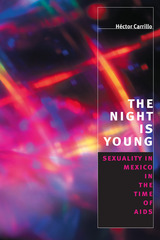 The Night is Young: Sexuality in Mexico in the Time of AIDS
Héctor Carrillo
University of Chicago Press, 2002 The Night Is Young takes us past the stereotypes of macho hombres and dark-eyed señoritas to reveal the complex nature of sexuality in modern-day Mexico. Drawing on field research conducted in Guadalajara, Mexico's second-largest city, Héctor Carrillo shows how modernization, globalization, and other social changes have affected a wide range of hetero- and homosexual practices and identities.
Carrillo finds that young Mexicans today grapple in a variety of ways with two competing tendencies. On the one hand, many seek to challenge traditional ideas and values they find limiting. But they also want to maintain a sense of Mexico's cultural distinctiveness, especially in relation to the United States. For example, while Mexicans are well aware of the dangers of unprotected sex, they may also prize the surrender to sexual passion, even in casual sexual encounters—an attitude which stems from the strong values placed on collective life, spontaneity, and an openness toward intimacy. Because these expectations contrast sharply with messages about individuality, planning, and overt negotiation commonly promoted in global public health efforts, Carrillo argues that they demand a new approach to AIDS prevention education in Mexico.
A Mexican native, Carrillo has written an exceptionally insightful and accessible study of the relations among sexuality, social change, and AIDS prevention in Mexico. Anyone concerned with the changing place of sexuality in a modern and increasingly globalized world will profit greatly from The Night Is Young.
Night Life: Nature from Dusk to Dawn
Diana Kappel-Smith
University of Arizona Press Journey with Diana Kappel-Smith into the nocturnal world of wild North America. Night Life combines scientific descriptions and personal reflections on creatures ranging from spiders and snakes to large predators of the northern Plains.
Night Logic
Matthew Gellman
Tupelo Press, 2023 The poems in Night Logic deal with queer coming-of-age and desire, as well as the persistent impact that childhood trauma can have on queer relationship-building. Focusing on the speaker’s longing to be seen, as well as his frequent desire to hide, Night Logic charts the speaker’s journey out of the closet and into an adult world that is both daunting and liberating at once. These confessional poems use the natural imagery of the speaker’s childhood to evoke longing and loss, as the landscape around him functions as both mirror and conduit. Again and again, the poems analyze the role that the closet has played in his struggles with self-articulation, as well as his parents’ divorce and the ways in which that rupture disorients him in his search for connection (romantic or otherwise). Night Logic explores the psychology of suppression in lucid, cinematic detail, presenting an elegant portrait of the pain that often comes with individuation.
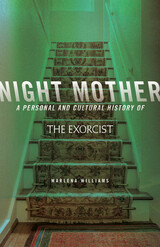 Night Mother: A Personal and Cultural History of The Exorcist
Marlena Williams
Ohio State University Press, 2023 Never watch The Exorcist, Marlena Williams’s mother told her, just as she’d been told by her own mother as a Catholic teen in rural Oregon when the horror classic premiered. And like her mother, Mary, Williams watched it anyway. An inheritance passed from mother to daughter, The Exorcist looms large—in popular culture and in Williams’s own life, years after Mary’s illness and death. In Night Mother, Williams investigates the film not only as a projection of Americans’ worst fears in the tumultuous 1970s and a source of enduring tropes around girlhood, faith, and transgression but also as a key to understanding her mother and the world she came from. The essays in Night Mother delve beneath the surface of The Exorcist to reveal the deeper stories the film tells about faith, family, illness, anger, guilt, desire, and death. Whether tracing the career of its young star, Linda Blair, unpacking its most infamous scenes, exploring its problematic depictions of gender and race, or reflecting on the horror of growing up female in America, Williams deftly blends bold personal narrative with shrewd cultural criticism. Night Mother offers fresh insights for both fans of the film and newcomers alike.
Night Moves
By Jessica Hopper
University of Texas Press, 2018 Written in taut, mesmerizing, often hilarious scenes, Night Moves captures the fierce friendships and small moments that form us all. Drawing on her personal journals from the aughts, Jessica Hopper chronicles her time as a DJ, living in decrepit punk houses, biking to bad loft parties with her friends, exploring Chicago deep into the night. And, along the way, she creates an homage to vibrant corners of the city that have been muted by sleek development. A book birthed in the amber glow of Chicago streetlamps, Night Moves is about a transformative moment of cultural history—and how a raw, rebellious writer found her voice.
Night Mowing
Chard deNiord
University of Pittsburgh Press, 2005 The poems in Night Mowing find their influence in the natural and the erotic; the biblical and the classical; the aesthetic and the spiritual. The landscape exists as both an ecstatic source of inspiration and as an endangered garden, and the narrator of these poems moves through that landscape in admiration and anguish: trying to preserve his joyful innocence while fully aware of the transience of all that he sees. Each poem in its specifics, whether focusing on a lover, a mountain, a dog, or a critic, wrestles with the universal and sacred, revealing the instinct of the poems to move toward purity and deep feeling even in dark times.
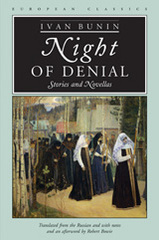 Night of Denial: Stories and Novellas
Ivan Bunin
Northwestern University Press, 2006 The first Russian to be awarded the Nobel Prize for literature, Ivan Bunin is often considered the last of the great Russian masters. Already renowned in Russia before the revolution, he fled the country in 1920 and lived the remainder of his life in France, where he continued to write for thirty years. Bunin made his name as a short-story writer with such masterpieces as "The Gentleman from San Francisco," the title piece in one of his collections and one of the stories in this volume. His last book of stories, Dark Avenues, was published in the 1940s. Among his longer works were a fictional autobiography, The Life of Arseniev (1930), and its sequel, Youth (1939), which were later collected into one volume, and two memoirs, The Accursed Days (1926), and Memories and Portraits (1950). He also wrote books on Tolstoy and Chekhov, both of whom he knew personally. Bunin, in fact, serves as a link-both personal and literary-between Tolstoy, whom he met as a young man, Chekhov, a close friend, and Vladimir Nabokov, who was influenced by Bunin early in his career and who moved in the same émigré literary circles in the twenties and thirties.
Bunin achieved his greatest mastery in the short story, and much of his finest work appears in this volume-the largest collection of his prose works ever published in English. In Robert Bowie's fine translation, with extensive annotations and a lengthy critical afterword, this work affords readers of English their first opportunity for a sustained encounter with a Russian classic, and one of the great writers of the twentieth century.
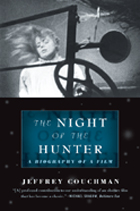 The Night of the Hunter: A Biography of a Film
Jeffrey Couchman
Northwestern University Press, 2009 Reaching simultaneously into the realms of film and literature, this detailed exploration of The Night of the Hunter examines the genesis and the eclectic form of each work and the process of transformation by which the novel became a motion picture. It provides the first major study of the long-lost first-draft screenplay by James Agee and confronts a fifty-year controversy about the authorship of the film. This is a story of artistic convergence on many levels--of novelist and director, director and actor, and cinematic form and tastes. The novel, a 1953 debut from Davis Grubb, was a popular and critical success, remaining on the New York Times best-seller list for four months. Hollywood responded to its atmospheric lyricism, and in the hands of first time director Charles Laughton, the book became a film that is equal parts thriller, allegory, and fever dream, filled with slow, inexorable suspense. On the set, Laughton functioned both as an auteur and a collaborator to create his vision of the book, mixing cinematic flourishes both realistic and abstract in sometimes tense situations. The talents that clashed or came together along the road from book to movie make the final film a product of rich stylistic contradiction and rewarding complexity. Through biography, production history, and critical analysis of the novel and film, author Jeffrey Couchman makes the case that this initially overlooked cinematic gem is a prismatic work that continually reveals new aspects of itself.
The Night of the Physicists: Operation Epsilon: Heisenberg, Hahn, Weizsäcker and the German Bomb
Richard von Schirach
Haus Publishing, 2015 In the spring of 1945 the Allies arrested the physicists they believed had worked on the German nuclear programme. Interned in an English country house owned by MI6, their conversations were secretly recorded. Operation Epsilon sought to determine how close Nazi Germany had come to building an atomic bomb. It was in this quiet setting – Farm Hall, near Cambridge – that the interned physicists first heard of the attack on Hiroshima. Aside from changing the course of history, that night was also one of great shock and personal defeat for the physicists – they were under the assumption that they alone had discovered nuclear fission. This is the story of Nazi Germany’s hunt for a nuclear bomb. It is a tale of the genius and guilt of lauded, respected scientists.
 Night Patrol and Other Stories
Mikhail Kuraev
Duke University Press, 1994 "We live in a fantastic reality," Mikhail Kuraev writes. "Life itself, the turns of history, people’s fates are unlikely, amazing and fantastic." This is the strange reality, the fantastic world of Russia before glasnost, that comes to life in Kuraev’s remarkable short stories and novellas. Celebrated as one of the true innovators to emerge in recent years, Kuraev mines the rich literary tradition and the deep and not so distant past of his native Russia to produce tales that are both deeply moving and stylistically intriguing.
Though steeped in history, his stories pluck from obscurity the little people history ignores—and, in the Soviet Union of Stalin, often crushed. In the complex "Captain Dikshtein," a fictional account of an incident in the 1921 Kronstad, Kuraev evokes life within Soviet military culture and draws a vivid, difficult portrait of one particular life amid the ships and artillery. In "Night Patrol," a lowly member of the Soviet secret police narrates his evening rounds, interspersing the nightly arrests with reflections on his long career in the KGB. In "Petya on His Way to the Heavenly Kingdom," set in a construction site for a hydroelectric dam near Murmansk, a soldier’s murder of the village simpleton resonates through a small community committed to an enormous and enormously dubious technological project. Ranging over a broad landscape of historical foibles, Kuraev’s sympathetic wit and satiric brilliance have invited comparison to Gogol, but are finally unique. In this book, English-reading audiences will discover a new and challenging voice in a tradition that has given the world some of its greatest stories.
Night Radio
Kim Young
University of Utah Press, 2012 Winner of the Agha Shahid Ali Poetry Prize
Set against the sprawling backdrop of Los Angeles, Night Radio excavates the kidnapping and sexual assault of a young girl and the resulting layers of trauma exacted upon her and her family. Working within the paradox of the insufficiency of language and the necessity of expression, these poems elevate overwhelming experiences into near-mythic narrative. Night Radio’s attempt through art to “make sense” of a seemingly senseless world raises troubling and timeless questions about the value, necessity, and futility of the aesthetic act. At the heart of the book is a journey toward reconciliation—wherein one discovers an abiding though hard-won faith within a complex, overwhelming, and, at times, frightening universe.
Finalist for the Kate Tufts Discovery Award.
 Night Riders: Defending Community in the Black Patch, 1890–1915
Christopher Waldrep
Duke University Press, 1993 In the late nineteenth century, industrialization was making its way into rural America. In an agricultural region of Kentucky and Tennessee called the Black Patch for the dark tobacco grown there, big business arrived with a vengeance, eliminating competition, manipulating prices, and undermining local control. The farmers fought back. Night Riders tells the story of the struggle that followed, and reveals the ambiguities and complexities of a drama that convulsed this community for over two decades.
Christopher Waldrep shows that, contrary to many accounts, these wealthy tobacco planters did not resist these new forces simply because of a nostalgia for a bygone time. Instead, many sought to become modern capitalists themselves--but on their own terms. The South's rural elite found their ability to hire and control black labor--the established racial practice of the community--threatened by the low prices offered by big companies for their raw materials. In response, farmers organized and demanded better prices for their tobacco. The tobacco companies then attempted to divide the farmers by offering higher prices to those willing to break with the others. When some cultivators succumbed, their betrayal awakened a deeply rooted vigilante tradition that called for the protection of community at all costs. Waldrep analyzes the spasm of violence that ensued in which horsemen, riding at night, destroyed tobacco barns and the warehouses where the companies stored their tobacco. But despite this fierce upheaval, the Black Patch community endured.
The most thorough treatment ever given to the Black Patch war, Night Riders illuminates a moment in history in which the traditional and the modern, the rural and the industrial, fought for the future--and past--of a community.
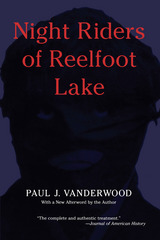 Night Riders of Reelfoot Lake
Paul Vanderwood
University of Alabama Press, 2003 A notable and tragic case of the struggle between legal and social justice
Reelfoot Lake has been a hunting and fishing paradise from the time of its creation in 1812, when the New Madrid earthquake caused the Mississippi River to flow backward into low-lying lands. Situated in the northwestern corner of the state of Tennessee, it attracted westward-moving pioneers, enticing some to settle permanently on its shores.
Threatened in 1908 with the loss of their homes and livelihoods to aggressive, outsider capitalists, rural folk whose families had lived for generations on the bountiful lake donned hoods and gowns and engaged in “night riding,” spreading mayhem and death throughout the region as they sought vigilante justice. They had come to regard the lake as their own, by “squatters’ rights,” but now a group of entrepreneurs from St. Louis had bought the titles to the land beneath the shallow lake and were laying legal claim to Reelfoot in its entirety. People were hanged, beaten, and threatened and property destroyed before the state militia finally quelled the uprising. A compromise that made the lake public property did not entirely heal the wounds which continue to this day.
Paul Vanderwood reconstructs these harrowing events from newspapers and other accounts of the time. He also obtained personal interviews with participants and family members who earlier had remained mum, still fearing prosecution. The Journal of American History declares his book “the complete and authentic treatment” of the horrific dispute and its troubled aftermath.
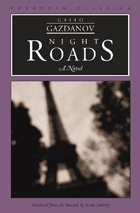 Night Roads: A Novel
Gaito Gazdanov
Northwestern University Press, 2009 Drawing together episodes of rich atmosphere, this novel is as deep and brooding as the Paris nights that serve as its backdrop. Russian writer Gaito Gazdanov arrived in Paris, as so many did, between the wars and would go on, with this fourth novel, to give readers a crisp rendering of a living city changing beneath its people’s feet. Night Roads is loosely based on the author’s experiences as a cab driver in those disorienting, often brutal years, and the narrator moves from episode to episode, holding court with many but sharing his mind with only a few. His companions are drawn straight out of the Parisian past: the legendary courtesan Jeanne Raldi, now in her later days, and an alcoholic philosopher who goes by the name of Plato. Along the way, the driver picks up other characters, such as the dull thinker who takes on the question of the meaning of life only to be driven insane. The dark humor of that young man’s failure against the narrator’s authentic, personal explorations of the same subject is captured in this first English translation. With his trademark émigré eye, Gazdanov pairs humor with cruelty, sharpening the bite of both.
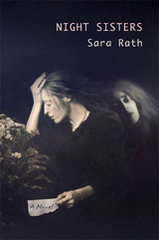 Night Sisters: A Novel
Sara Rath
University of Wisconsin Press, 2008 Nell Grendon never thought about communing with the dead when she was growing up in Little Wolf, Wisconsin; she was more concerned with slumber parties, boys, and the Lord’s Prayer Ring she won (dishonestly) in a Methodist Bible Bee. But when a chance visit to the eccentric but charming Wocanaga Spiritualist Camp brings the adult Nell face-to-face with the elderly medium Grace Waverly, she cannot resist the temptation to learn more about spirit mediumship. Nell intends to fake her intuitive talents, but soon she spontaneously channels Angella Wing, an actress from the 1920s once known as the “Woman of a Thousand Voices.” Nell attempts to conceal her occult interests from skeptical friends, including George, a handsome jazz musician who rents an apartment in her historic home, and Polly, a childhood friend with buried anguish of her own. But soon Angella’s mischievous presence begins to make Nell’s life more and more difficult, eventually attracting shadows of Nell’s past. As she tries to free herself from Angella’s influence, Nell is forced into an investigation of a mysterious death at the very heart of her childhood—and the revelation of surprisingly dark secrets.
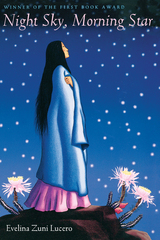 Night Sky, Morning Star
Evelina Zuni Lucero
University of Arizona Press, 2000 At the Indian artisans show in Santa Clara Pueblo, Cecelia Bluespruce sits with her wares in the middle of a row of booths—a good place to catch buyers. She is a successful Native American artist, a sculptor and potter of renown. But Cecelia is in the middle of something deeper than an art show, for she has become trapped by dreams and shadows of her past.
Night Sky, Morning Star is a story of remembrance and reconciliation in one Native American family separated by time and chance. Cecelia’s grown son, Jude, now wants to learn about the father he has never known. Political activist Julian Morning Star, imprisoned twenty years for a crime he did not commit, is unaware that his son even exists. Troubled by dreams, lies, and denial of the past, Cecelia is guided toward wholeness by family and friends who have their own pasts to confront.
This compelling novel plunges readers into the hubbub of the Indian arts market and into the grim reality of prison life. Evelina Zuni Lucero introduces us to experiences we may find unfamiliar: diverse Native American traditions, life on a BIA Indian agency compound, the making of an Indian activist. But she also reintroduces us to two things we all live for: the power of story and the power of love.
Night Sky, Morning Star is the fiction winner of the 1999 First Book Awards competition of the Native Writers’ Circle of the Americas.
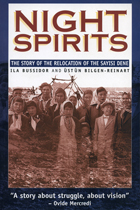 Night Spirits: The Story of the Relocation of the Sayisi Dene
Ila Bussidor
University of Manitoba Press, 1997 For over 1500 years, the Sayisi Dene, 'The Dene from the East', led an independent life, following the caribou herds and having little contact with white society. In 1956, an arbitrary government decision to relocate them catapulted the Sayisi Dene into the 20th century. It replaced their traditional nomadic life of hunting and fishing with a slum settlement on the outskirts of Churchill, Manitoba. Inadequately housed, without jobs, unfamiliar with the language or the culture, their independence and self-determination deteriorated into a tragic cycle of discrimination, poverty, alcoholism and violent death.By the early 1970s, the band realized they had to take their future into their own hands again. After searching for a suitable location, they set up a new community at Tadoule Lake, 250 miles north of Churchill. Today they run their own health, education and community programs. But the scars of the relocation will take years to heal, and Tadoule Lake is grappling with the problems of a people whose ties to the land, and to one another, have been tragically severed.In Night Spirits, the survivors, including those who were children at the time of the move, as well as the few remaining elders, recount their stories. They offer a stark and brutally honest account of the near-destruction of the Sayisi Dene, and their struggle to reclaim their lives. It is a dark story, told in hope.
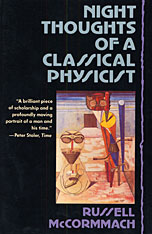 Night Thoughts of a Classical Physicist
Russell McCormmach
Harvard University Press, 1982 It is the end of an historical epoch, but to an old professor of physics, Victor Jakob, sitting in his unlighted study, eating dubious bread with jam made from turnips, it is the end of a way of thinking in his own subject. Younger men have challenged the classical world picture of physics and are looking forward to observational tests of Einstein’s new theory of relativity as well as the creation of a quantum mechanics of the atom. It is a time of both apprehension and hope.
In this remarkable book, the reader literally inhabits the mind of a scientist while Professor Jakob meditates on the discoveries of the past fifty years and reviews his own life and career—his scientific ambitions and his record of small successes. He recalls the great men who taught or inspired him: Helmholtz, Hertz, Maxwell, Planck, and above all Paul Drude, whose life and mind exemplified the classical virtues of proportion, harmony, and grace that Jakob reveres. In Drude’s shocking and unexpected suicide, we see reflected Jakob’s own bewilderment and loss of bearings as his once secure world comes to an end in the horrors of the war and in the cultural fragmentation wrought by twentieth-century modernism. His attempt to come to terms with himself, with his life in science, and with his spiritual legacy will affect deeply everyone who cares about the fragile structures of civilization that must fall before the onrush of progress.
The Night Train and the Golden Bird
Peter Meinke
University of Pittsburgh Press, 1977 Although The Night Train and the Golden Bird is Peter Meinke’s first poetry collection, it is a seasoned performance—the result of careful deliberation and mature judgment—yet impetuous and exciting. It’s full of wit and humor tempered with the sadness of approaching middle-age, anguish over political and social injustice, and of the very failings of everyday people and their lives.
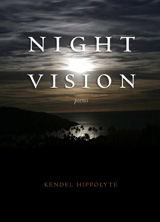 Night Vision: Poems
Kendel Hippolyte
Northwestern University Press, 2006 Because we see with history,
it is difficult to see through it. And yet we must
or we become it, become nothing else but history.
It is this challenge, laid down in the powerful title poem of this collection, which Kendel Hippolyte takes up in Night Vision. And the history that Hippolyte penetrates is a history of the change overtaking the island of St. Lucia. As town becomes city and city spreads like a cancer, the poet's searching verse finds among the waste of humanity, nature, and culture a microcosm of the transforming Caribbean-from tradition, community, rooted identity, to social fragmentation, isolation, uncertainty. And yet, in the personal, away from the daytime public glare, Night Vision also finds the possibility of renewal. Engaging society and self, the poet's dialogue is conducted in a range of poetic voices and styles-the traditional forms of sonnet, villanelle, triolet, echo poem, as well as dramatic monologues in Caribbean English idioms and rhythms of speech; poems written to the metrics of blues and rap alongside free verse poems that expand in long-breath incantatory lines and contract in miniaturist forms as concise as graffiti. The joyful linguistic energy of the poems is perhaps what makes them, and us, look beyond the glaring reality they contemplate to a more hopeful, if nighttime, vision.
Night Watch On The Chesapeake
Peter Meinke
University of Pittsburgh Press, 2024 Night Watch on the Chesapeake is Peter Meinke’s third collection of poetry. The poems traverse a wide landscape of topics from playing baseball, the death of a friend, divorce, and even poetry itself.
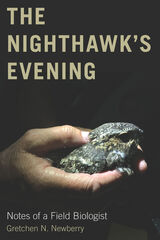 The Nighthawk's Evening: Notes of a Field Biologist
Gretchen N. Newberry
Oregon State University Press, 2021 In her late thirties, Gretchen Newberry left her office job in Portland, Oregon, to become a wildlife biologist studying nighthawks. The common nighthawk, Chordeiles minor, has long fascinated birders, scientists, farmers, and anyone who has awoken to its raspy calls on a hot city night. In The Nighthawk’s Evening, Newberry charts her journey across North America to study these birds, from the islands of British Columbia to rooftops in South Dakota, Oregon sagebrush, and Wisconsin forests.
This acrobatic, night-flying bird nests on rooftops and flocks in the thousands as it migrates from Alaska to Argentina and back every year. Nighthawks are strange animals, reptiles with feathers, sleepy during the day, but quick, agile, and especially adept at survival. They have the ability to withstand extreme temperatures and adapt to many habitats, but they are struggling for survival in the Anthropocene.
Newberry’s story focuses on the bird itself—its complex conservation status and cultural significance—and the larger, often hidden world of nocturnal animals. Along the way, she gives readers insight into the daily life of a scientist, especially one who works primarily at night. The Nighthawk’s Evening uses one scientist and one species to explore the challenges, disappointments, and successes of scientific research and conservation efforts. An accessible work of science, it will appeal to birders, students, wildlife managers, and anyone who is fascinated by urban wildlife.
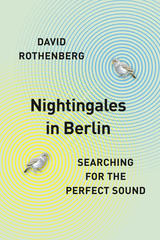 Nightingales in Berlin: Searching for the Perfect Sound
David Rothenberg
University of Chicago Press, 2019 A celebrated figure in myth, song, and story, the nightingale has captivated the imagination for millennia, its complex song evoking a prism of human emotions,—from melancholy to joy, from the fear of death to the immortality of art.
But have you ever listened closely to a nightingale’s song? It’s a strange and unsettling sort of composition—an eclectic assortment of chirps, whirs, trills, clicks, whistles, twitters, and gurgles. At times it is mellifluous, at others downright guttural. It is a rhythmic assault, always eluding capture. What happens if you decide to join in?
As philosopher and musician David Rothenberg shows in this searching and personal new book, the nightingale’s song is so peculiar in part because it reflects our own cacophony back at us. As vocal learners, nightingales acquire their music through the world around them, singing amidst the sounds of humanity in all its contradictions of noise and beauty, hard machinery and soft melody. Rather than try to capture a sound not made for us to understand, Rothenberg seeks these musical creatures out, clarinet in tow, and makes a new sound with them. He takes us to the urban landscape of Berlin—longtime home to nightingale colonies where the birds sing ever louder in order to be heard—and invites us to listen in on their remarkable collaboration as birds and instruments riff off of each other’s sounds. Through dialogue, travel records, sonograms, tours of Berlin’s city parks, and musings on the place animal music occupies in our collective imagination, Rothenberg takes us on a quest for a new sonic alchemy, a music impossible for any one species to make alone. In the tradition of The Hidden Life of Trees and The Invention of Nature, Rothenberg has written a provocative and accessible book to attune us ever closer to the natural environment around us.
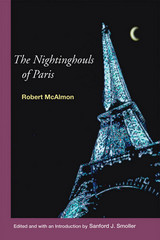 The Nightinghouls of Paris
Robert McAlmon. Edited and with an Introduction by Sanford J. Smoller
University of Illinois Press, 2006 The Nightinghouls of Paris is a thinly fictionalized memoir of the darker side of expatriate life in Paris. Beginning in 1928, the story follows the changes undergone by Canadian youths John Glassco and his friend Graeme Taylor during their (mis)adventures in Paris while trying to become writers. There they meet Robert McAlmon, who guides them through the city’s cafes, bistros, and nightclubs, where they find writers and artists including Kay Boyle (with whom Glassco has a fling), Bill Bird, Djuna Barnes, Claude McKay, Hilaire Hiler, Peggy Guggenheim, and Ernest Hemingway. Fleeing France in late 1940, Robert McAlmon lost his notebook manuscripts and drafted
The Nightinghouls of Paris from memory. Till now, it has existed solely as a typescript held by Yale University. Unlike most memoirs of American expatriates in the ‘20s, The Nightinghouls of Paris centers not only on writers, but also encompasses the racial, national, and social mélange they encountered in everyday life.
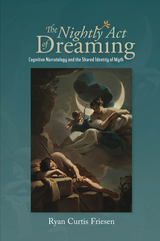 The Nightly Act of Dreaming: Cognitive Narratology and the Shared Identity of Myth
Ryan Friesen
Sussex Academic Press, 2022 The search for a shared practice of storytelling around which a popular study of cognitive narratology might form need look no further than our nightly experience of dreams. Dreams and memories are inseparable, complicating and building upon one another, reminding us that knowledge of ourselves based on our memories relies upon fictionalized narratives we create for ourselves. Psychologists refer to confabulation, the creation of false or distorted memories about oneself and the world we inhabit, albeit without any conscious intention to deceive. This process and narrative, inherent in the dreamlife of all people, is at odds with the daily menu of cultural myths and politicized fictions fed to the Western world through print and social media, and for which there is constant divisiveness and disagreement.
Cognitive Narratology and the Shared Identity of Myth uses insights gained from the scientific study of dreaming to explain how the shared experience of dreamlife can work in service to the common good. Primary texts and literary works, chosen for their influence on contemporary thinking, provide a rationale and historical background: From Artemidorus (a professional diviner) and Aristotle; to the Church fathers Tertullian, St. Augustine, Gregory of Nyssa, Sinesius of Cyrene; to The Wanderer (Old English poem) and Chaucer's Book of the Duchess; to Coleridge's writings and R. L. Stevenson's A Chapter on Dreams; and to twentieth-century dream theory, and dream use in film. The purpose is to enable readers through subjective self-analysis to recognize what they share with their fellow dreamers; shared identity in formation of a shared act of dreaming creation is a universal across centuries and throughout Western culture, albeit currently misrepresented and rarely acted upon.
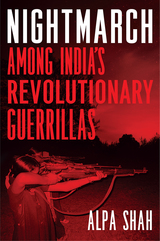 Nightmarch: Among India’s Revolutionary Guerrillas
Alpa Shah
University of Chicago Press, 2019 Winner of the 2020 Association for Political and Legal Anthropology Book Prize
Shortlisted for the Orwell Prize
Shortlisted for the New India Foundation Book Prize
Anthropologist Alpa Shah found herself in an active platoon of Naxalites—one of the longest-running guerrilla insurgencies in the world. The only woman, and the only person without a weapon, she walked alongside the militants for seven nights across 150 miles of dense, hilly forests in eastern India. Nightmarch is the riveting story of Shah's journey, grounded in her years of living with India’s tribal people, an eye-opening exploration of the movement’s history and future and a powerful contemplation of how disadvantaged people fight back against unjust systems in today’s world.
The Naxalites have fought for a communist society for the past fifty years, caught in a conflict that has so far claimed at least forty thousand lives. Yet surprisingly little is known about these fighters in the West. Framed by the Indian state as a deadly terrorist group, the movement is actually made up of Marxist ideologues and lower-caste and tribal combatants, all of whom seek to overthrow a system that has abused them for decades. In Nightmarch, Shah shares some of their gritty untold stories: here we meet a high-caste leader who spent almost thirty years underground, a young Adivasi foot soldier, and an Adivasi youth who defected. Speaking with them and living for years with villagers in guerrilla strongholds, Shah has sought to understand why some of India’s poor have shunned the world’s largest democracy and taken up arms to fight for a fairer society—and asks whether they might be undermining their own aims.
By shining a light on this largely ignored corner of the world, Shah raises important questions about the uncaring advance of capitalism and offers a compelling reflection on dispossession and conflict at the heart of contemporary India.
The Nightmare Considered: Critical Essays on Nuclear War Literature
Nancy Anisfield
University of Wisconsin Press, 1991 These essays assess the nature of nuclear war literature from a variety of perspectives. Scholars, activists, novelists, poets, and teachers challenge nuclear ideologies and traditional readings of apocalyptic texts. Included: Holocaust literature of the 1950s, Michael Dorris and Louise Erdrich, poetry and nuclear war, Riddley Walker, Fiskadoro, haiku and Hiroshima, Kopit’s End of the World, O’Brien’s The Nuclear Age, and Vonnegut’s cataclysmic novels.
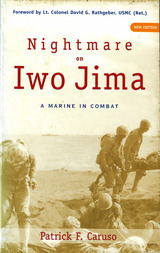 Nightmare on Iwo Jima: A Marine in Combat
Patrick F. Caruso, with a foreword by David G. Rathgeber
University of Alabama Press, 2007 On February 19, 1945, the 4th and 5th Marine Divisions stormed ashore from a naval support force. Among them was green young lieutenant Pat Caruso who became de facto company commander when the five officers ranking him were killed or wounded. He led his rapidly diminishing force steadily forward for the next few days, when a day’s gains were measured in yards. Caruso was eventually wounded himself and was evacuated. Realizing that the heroism of his comrades would be lost by the decimation of his unit, Caruso latched onto any paper he could find and filled every blank space with his memory of the fighting. This edition has a new foreword and index, boasts nine new photographs, and a map of the action. It resumes its place as a classic account of the experience of being in close, direct, and constant contact with a determined enemy at close quarters. Many did not survive; those who did were changed forever.
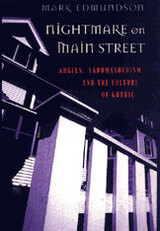 Nightmare on Main Street: Angels, Sadomasochism, and the Culture of Gothic
Mark Edmundson
Harvard University Press, 1997 Once we've terrified ourselves reading Anne Rice or Stephen King, watching Halloween or following the O. J. Simpson trial, we can rely on the comfort of our inner child or Robert Bly's bongos, an angel, or even a crystal. In a brilliant assessment of American culture on the eve of the millennium, Mark Edmundson asks why we're determined to be haunted, courting the Gothic at every turn--and, at the same time, committed to escape through any new scheme for ready-made transcendence.
Nightmare on Main Street depicts a culture suffused with the Gothic, not just in novels and films but even in the nonfictive realms of politics and academic theories, TV news and talk shows, various therapies, and discourses on AIDS and the environment. Gothic's first wave, in the 1790s, reflected the truly terrifying events unfolding in revolutionary France. What, Edmundson asks, does the ascendancy of the Gothic in the 1990s tell us about our own day?
And what of another trend, seemingly unrelated--the widespread belief that re-creating oneself is as easy as making a wish? Looking at the world according to Forrest Gump, Edmundson shows how this parallel culture actually works reciprocally with the Gothic.
An unchecked fixation on the Gothic, Edmundson argues, would result in a culture of sadomasochism. Against such a rancorous and dispiriting possibility, he draws on the work of Nietzsche and Shelley, and on the recent creations of Toni Morrison and Tony Kushner, to show how the Gothic and the visionary can come together in persuasive and renovating ways.
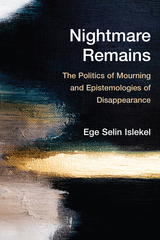 Nightmare Remains: The Politics of Mourning and Epistemologies of Disappearance
Ege Selin Islekel
Northwestern University Press, 2024 Offering a political epistemology of collective mourning Focusing on forms of improper burial in Turkey and Latin America, Ege Selin Islekel argues that a political technology of mourning is fundamental to contemporary politics. This technology of necrosovereignty shapes not only individuals’ and populations’ lives but also their epistemic and political afterlives. Local practices of mourning, however, contain resistant capacities, opening alternative ways of knowing, remembering, and assembling. “Nightmare knowledges,” Islekel posits, are resistant modes of knowing tied up with grief that challenge the contemporary politics of death and those politics’ archival boundaries. Seen in mothers’ movements across the globe, from the Mothers of the Plaza de Mayo of Argentina to the Saturday Mothers of Turkey, nightmare knowledges produce counterarchives that mobilize traditionally ignored epistemic categories. Nightmare Remains forges a new dialogue between post-Foucauldian political theory and decolonial thought and brings a fresh critical perspective to the theoretical discourse of enforced disappearances.
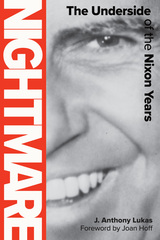 Nightmare: The Underside of the Nixon Years
J. Anthony Lukas
Ohio University Press, 1999 In July 1973, for the first time in its history, the New York Times Magazine devoted a full issue to a single article: Pulitzer Prize–winning journalist J. Anthony Lukas’s account of the Watergate story to date. Six months later, a second installment ran in another full issue. Later the Times asked him to write a third issue, on the impeachment, which never appeared because of Nixon’s intervening resignation. But all of Lukas’s painstaking reporting on Nixon’s last months in office appears here, along with added information on every aspect of Watergate.
Widely acclaimed as a major text of the Watergate saga, J. Anthony Lukas’s Nightmare is a masterwork of investigation, highlighted by in-depth character sketches of the key players. For students of history coming to these events for the first time, this book reveals in depth the particular trauma of a nation in turmoil; for those who remember, the upheaval and what was at stake are once more brought to life.
Nightmare's Fairy Tale: A Young Refugee's Home Fronts, 1938–1948
Gerd Korman
University of Wisconsin Press, 2007 Fleeing the Nazis in the months before World War II, the Korman family scattered from a Polish refugee camp with the hope of reuniting in America. The father sailed to Cuba on the ill-fated St. Louis; the mother left for the United States after sending her two sons on a Kindertransport. One of the sons was Gerd Korman, whose memoir follows his own path—from the family’s deportation from Hamburg, through his time with an Anglican family in rural England, to the family’s reunited life in New York City. His memoir plumbs the depths of twentieth-century history to rescue the remarkable life story of one of its survivors.
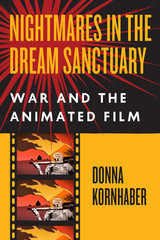 Nightmares in the Dream Sanctuary: War and the Animated Film
Donna Kornhaber
University of Chicago Press, 2019 In 2008, Waltz with Bashir shocked the world by presenting a bracing story of war in what seemed like the most unlikely of formats—an animated film. Yet as Donna Kornhaber shows in this pioneering new book, the relationship between animation and war is actually as old as film itself. The world’s very first animated movie was made to solicit donations for the Second Boer War, and even Walt Disney sent his earliest creations off to fight on gruesome animated battlefields drawn from his First World War experience. As Kornhaber strikingly demonstrates, the tradition of wartime animation, long ignored by scholars and film buffs alike, is one of the world’s richest archives of wartime memory and witness.
Generation after generation, artists have turned to this most fantastical of mediums to capture real-life horrors they can express in no other way. From Chinese animators depicting the Japanese invasion of Shanghai to Bosnian animators portraying the siege of Sarajevo, from African animators documenting ethnic cleansing to South American animators reflecting on torture and civil war, from Vietnam-era protest films to the films of the French Resistance, from firsthand memories of Hiroshima to the haunting work of Holocaust survivors, the animated medium has for more than a century served as a visual repository for some of the darkest chapters in human history. It is a tradition that continues even to this day, in animated shorts made by Russian dissidents decrying the fighting in Ukraine, American soldiers returning from Iraq, or Middle Eastern artists commenting on the Israeli-Palestinian conflict, the Arab Spring, or the ongoing crisis in Yemen.
Nightmares in the Dream Sanctuary: War and the Animated Film vividly tells the story of these works and many others, covering the full history of animated film and spanning the entire globe. A rich, serious, and deeply felt work of groundbreaking media history, it is also an emotional testament to the power of art to capture the endurance of the human spirit in the face of atrocity.
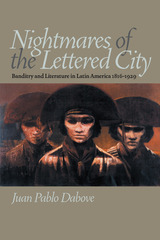 Nightmares of the Lettered City: Banditry and Literature in Latin America, 1816-1929
Juan Pablo Dabove
University of Pittsburgh Press, 2007
Nightmares of the Lettered City presents an original study of the popular theme of banditry in works of literature, essays, poetry, and drama, and banditry's pivotal role during the conceptualization and formation of the Latin American nation-state.
Juan Pablo Dabove examines writings over a broad time period, from the early nineteenth century to the 1920s, and while Nightmares of the Lettered City focuses on four crucial countries (Argentina, Mexico, Brazil, and Venezuela), it is the first book to address the depiction of banditry in Latin America as a whole. The work offers close reading of Facundo, Doña Bárbara, Os Sertões, and Martín Fierro, among other works, illuminating the ever-changing and often contradictory political agendas of the literary elite in their portrayals of the forms of peasant insurgency labeled “banditry.”
Banditry has haunted the Latin American literary imagination. As a cultural trope, banditry has always been an uneasy compromise between desire and anxiety (a “nightmare”), and Dabove isolates three main representational strategies. He analyzes the bandit as radical other, a figure through which the elites depicted the threats posed to them by various sectors outside the lettered city. Further, he considers the bandit as a trope used in elite internecine struggles. In this case, rural insurgency was a means to legitimize or refute an opposing sector or faction within the lettered city. Finally, Dabove shows how, in certain cases, the bandit was used as an image of the nonstate violence that the nation state has to suppress as a historical force and simultaneously exalt as a memory in order to achieve cultural coherence and actual sovereignty.
As Dabove convincingly demonstrates, the elite's construction of the bandit is essential to our understanding of the development of the Latin American nation in the nineteenth and early twentieth centuries.
Nightshade
Andrea Cohen
Four Way Books, 2019 The poems in Andrea Cohen’s Nightshade, her sixth full-length collection, are constructed from the wisdom of loss—of lovers and loved ones and a world gone awry. Cohen builds a short poem the way a master carpenter does a tiny house, in lines that are both economic and precise, with room enough for sorrow and wit to exist comfortably in their spaces. The great pleasure in reading these poems is their surprise in the way the endings arrive again and again in startling truths: The bride whose dress is sewn “from a hundred/tattered flags/of surrender” and the ever-present reminder of the title poem that the things of this world are both “poison and . . . balms” that “We /call . . . bitter- / sweet––what / living isn’t?”
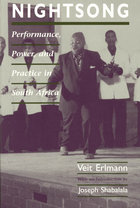 Nightsong: Performance, Power, and Practice in South Africa
Veit Erlmann
University of Chicago Press, 1996 First popularized by Ladysmith Black Mambazo and Paul Simon, the a cappella music known as isicathamiya has become internationally celebrated as one of South Africa's most vibrant and distinct performance traditions. But Ladysmith Black Mambazo is only one of hundreds of choirs that perform "nightsongs" during weekly all-night competitions in South Africa's cities.
Veit Erlmann provides the first comprehensive interpretation of isicathamiya performance practice and its relation to the culture and consciousness of the Zulu migrant laborers who largely compose its choirs. In songs and dances, the performers oppose the class and racial oppression that reduces them to "labor units." At the same time, Erlmann argues, the performers rework dominant images to symbolically reconstruct their "home," an imagined world of Zulu rural tradition and identity.
By contrasting the live performance of isicathamiya to its reproduction in mass media, recordings, and international concerts, Erlmann addresses important issues in performance studies and anthropology, and looks to the future of isicathamiya live performance in the new South Africa. Featuring an Introduction by Joseph Shabalala, the lead singer and founder of Ladysmith Black Mambazo, this book will be essential reading for anyone interested in the study of music, performance, popular culture, or South Africa.
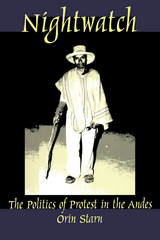 Nightwatch: The Politics of Protest in the Andes
Orin Starn
Duke University Press, 1999 Organized in the mid-1970s as a means of communal protection against livestock rustling and general thievery in Peru’s rugged northern mountains, the rondas campesinas (peasants who make the rounds) grew into an entire system of peasant justice and one of the most significant Andean social movements of the late twentieth century. Nightwatch is the first full-length ethnography and the only study in English to examine this grassroots agrarian social movement, which became a rallying point for rural pride. Drawing on fieldwork conducted over the course of a decade, Orin Starn chronicles the historical conditions that led to the formation of the rondas, the social and geographical expansion of the movement, and its gradual decline in the 1990s. Throughout this anecdotal yet deeply analytical account, the author relies on interviews with ronda participants, villagers, and Peru’s regional and national leaders to explore the role of women, the involvement of nongovernmental organizations, and struggles for leadership within the rondas. Starn moves easily from global to local contexts and from the fifteenth to the twentieth century, presenting this movement in a straightforward manner that makes it accessible to both specialists and nonspecialists. An engagingly written story of village mobilization, Nightwatch is also a meditation on the nature of fieldwork, the representation of subaltern people, the relationship between resistance and power, and what it means to be politically active at the end of the century. It will appeal widely to scholars and students of anthropology, Latin American studies, cultural studies, history, subaltern studies, and those interested in the politics of social movements.
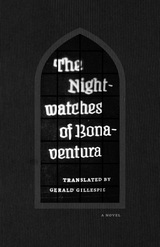 The Nightwatches of Bonaventura
Bonaventura
University of Chicago Press, 2014 First published in German in 1804, under the nom de plume “Bonaventura,” The Nightwatches of Bonaventura is a dark, twisted, and comic novel, one part Poe and one part Beckett. The narrator and antihero is not Bonaventura but a night watchman named Kreuzgang, a failed poet, actor, and puppeteer who claims to be the spawn of the devil himself. As a night watchman, Kreuzgang takes voyeuristic pleasure in spying on the follies of his fellow citizens, and every night he makes his rounds and stops to peer into a window or door, where he observes framed scenes of murder, despair, theft, romance, and other private activities. In his reactions, Kreuzgang is cynical and pessimistic, yet not without humor. For him, life is a grotesque, macabre, and base joke played by a mechanical and heartless force.
Since its publication, fans have speculated on the novel’s authorship, and it is now believed to be by theater director August Klingemann, who first staged Goethe’s Faust. Organized into sixteen separate nightwatches, the sordid scenes glimpsed through parted curtains, framed by door chinks, and lit by candles and shadows anticipate the cinematic. A cross between the gothic and the romantic, The Nightwatches of Bonaventura is brilliant in its perverse intensity, presenting an inventory of human despair and disgust through the eyes of a bitter, sardonic watcher who draws laughter from tragedy.
Translated by Gerald Gillespie, who supplies a fresh introduction, The Nightwatches of Bonaventura will be welcomed by a new generation of English-language fans eager to sample the night’s dark offerings.
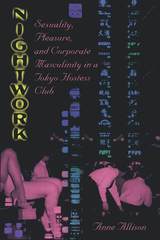 Nightwork: Sexuality, Pleasure, and Corporate Masculinity in a Tokyo Hostess Club
Anne Allison
University of Chicago Press, 1994 In Nightwork, Anne Allison opens a window onto Japanese corporate culture and gender identities. Allison performed the ritualized tasks of a hostess in one of Tokyo's many "hostess clubs": pouring drinks, lighting cigarettes, and making flattering or titillating conversation with the businessmen who came there on company expense accounts. Her book critically examines how such establishments create bonds among white-collar men and forge a masculine identity that suits the needs of their corporations.
Allison describes in detail a typical company outing to such a club—what the men do, how they interact with the hostesses, the role the hostess is expected to play, and the extent to which all of this involves "play" rather than "work." Unlike previous books on Japanese nightlife, Allison's ethnography of one specific hostess club (here referred to as Bijo) views the general phenomenon from the eyes of a woman, hostess, and feminist anthropologist.
Observing that clubs like Bijo further a kind of masculinity dependent on the gestures and labors of women, Allison seeks to uncover connections between such behavior and other social, economic, sexual, and gendered relations. She argues that Japanese corporate nightlife enables and institutionalizes a particular form of ritualized male dominance: in paying for this entertainment, Japanese corporations not only give their male workers a self-image as phallic man, but also develop relationships to work that are unconditional and unbreakable. This is a book that will appeal to anyone interested in gender roles or in contemporary Japanese society.
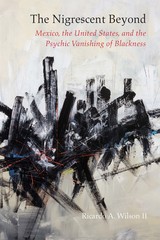 The Nigrescent Beyond: Mexico, the United States, and the Psychic Vanishing of Blackness
Ricardo A. Wilson II
Northwestern University Press, 2020 Despite New Spain’s significant participation in the early transatlantic slave trade, the collective imagination of the Mexican nation evolved in the nineteenth and twentieth centuries to understand itself as devoid of a black presence. In The Nigrescent Beyond, Ricardo Wilson proposes a framework for understanding this psychic vanishing of blackness and thinks through how it can be used both to productively unsettle contemporary multicultural and postracial discourses within the United States and to further the interrogations of being and blackness within the larger field of black studies.
Wilson models a practice of reading that honors the disruptive possibilities offered by an ever-present awareness of that which lies, irretrievable, beyond the horizon of vanishing itself. In doing so, he engages with historical accounts detailing maroon activities in early New Spain, contemporary coverage of the push to make legible Afro-Mexican identities, the electronic archives of the Obama presidency, and the work of Carlos de Sigüenza y Góngora, Octavio Paz, Ivan Van Sertima, Miguel Covarrubias, Steven Spielberg, and Colson Whitehead, among others.
 Nihikéyah: Navajo Homeland
Edited by Lloyd L. Lee
University of Arizona Press, 2023 This anthology of essays offers perspectives of the Navajo homeland, nihikéyah, highlighting Diné examinations and understandings of the land.
While various books have investigated Native American reservations and homelands, this book is from Diné individuals’ experiences, observations, and examinations. Poets, writers, and scholars frame their thoughts on four key questions: What are the thoughts/perspectives on nihikéyah/Navajo homeland? What challenges does nihikéyah face in the coming generations, and what should all peoples know about nihikéyah? And how can nihikéyah build a strong and positive Navajo Nation for the rest of this century and beyond?
The authors come from a variety of backgrounds and use multiple approaches to discuss Diné history in the U.S. Southwest, as well as forward-looking examinations of the Navajo Nation.
Together, the essays shed new light on Diné homeland and the challenges to the Navajo homeland and its peoples.
Contributors
Mario Atencio
Shawn Attakai
Wendy Shelly Greyeyes
Rex Lee Jim
Manny Loley
Jonathan Perry
Jake Skeets
Jennifer Jackson Wheeler
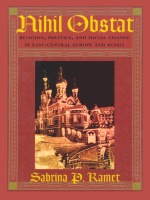 Nihil Obstat: Religion, Politics, and Social Change in East-Central Europe and Russia
Sabrina P. Ramet
Duke University Press, 1998 Nihil Obstat—Latin for "nothing stands in the way"—examines the interplay between religion and politics in East-Central Europe and Russia. While focusing on the postcommunist, late twentieth century, Sabrina P. Ramet discusses developments as far back as the eleventh century to explain the patterns that have developed over time and to show how they still affect contemporary interecclesiastical relations as well as those among Church, state, and society.
Based on interview research in Germany, Austria, Slovenia, Croatia, Bosnia, Serbia, and Macedonia, and on materials published in German, Italian, Serbo-Croatian, Polish, Czech, Slovak, Russian, and English, Ramet paints a clear picture of the political and religious fragility of former communist states, which are experiencing some aspects of freedom and choice for the first time. With its comprehensive discussion of the largest religious institutions in the area, especially the Catholic and Orthodox Churches, and its extensive survey of nontraditional religious associations that have become active in the region since 1989, this study makes a distinct contribution to growing discussions about the rise of fundamentalism and the inner dilemmas of modernity. With its depth of information and thoughtful exploration of cultural traditions, Nihil Obstat uniquely presents the ramifications and complexities of European religion in a postcommunist world.
 Nihilism and Negritude: Ways of Living in Africa
Célestin Monga
Harvard University Press, 2016 “A terrific meditation on contemporary African modernity, conceived through a series of essays that reflect on the practices of everyday life.” ―Kwame Anthony Appiah, New York University
There are two common ways of writing about Africa, says Célestin Monga. One way blames Africa’s ills on the continent’s history of exploitation and oppression. The other way blames Africans themselves for failing to rise above poisonous national prejudices and resentments. But patronizing caricatures that reduce Africans to either victims or slackers do not get us very far in understanding the complexities and paradoxes of Africa today.
A searching, often searing, meditation on ways of living in modern Africa, Nihilism and Negritude dispels the stereotypes that cloud how outsiders view the continent—and how Africans sometimes view themselves. In the role of a traveler-philosopher, Monga seeks to register “the picturesque absurdity of daily life” in his native Cameroon and across the continent. Whether navigating the chaotic choreography of street traffic or discoursing on the philosophy of café menus, he illuminates the patterns of reasoning behind everyday behaviors and offers new interpretations of what some observers have misunderstood as Africans’ resigned acceptance of suffering and violence.
Monga does not wish to revive Negritude, the once-influential movement that sought to identify and celebrate allegedly unique African values. Rather, he seeks to show how daily life and thought—witnessed in dance and music, sensual pleasure and bodily experience, faith and mourning—reflect a form of nihilism developed to cope with chaos, poverty, and oppression. This is not the nihilism of despair, Monga insists, but the determination to find meaning and even joy in a life that would otherwise seem absurd.
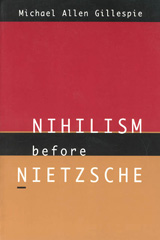 Nihilism Before Nietzsche
Michael Allen Gillespie
University of Chicago Press, 1994 In the twentieth century, we often think of Nietzsche, nihilism, and the death of God as inextricably connected. But, in this pathbreaking work, Michael Gillespie argues that Nietzsche, in fact, misunderstood nihilism, and that his misunderstanding has misled nearly all succeeding thought about the subject.
Reconstructing nihilism's intellectual and spiritual origins before it was given its determinitive definition by Nietzsche, Gillespie focuses on the crucial turning points in the development of nihilism, from Ockham and the nominalist revolution to Descartes, Fichte, the German Romantics, the Russian nihilists and Nietzsche himself. His analysis shows that nihilism is not the result of the death of God, as Nietzsche believed; but the consequence of a new idea of God as a God of will who overturns all eternal standards of truth and justice. To understand nihilism, one has to understand how this notion of God came to inform a new notion of man and nature, one that puts will in place of reason, and freedom in place of necessity and order.
 Nihilistic Times: Thinking with Max Weber
Wendy Brown
Harvard University Press, 2023 One of America’s leading political theorists analyzes the nihilism degrading—and confounding—political and academic life today. Through readings of Max Weber’s Vocation Lectures, she proposes ways to counter nihilism’s devaluations of both knowledge and political responsibility.
How has politics become a playpen for vain demagogues? Why has the university become an ideological war zone? What has happened to Truth? Wendy Brown places nihilism at the center of these predicaments. Emerging from European modernity’s replacement of God and tradition with science and reason, nihilism removes the foundation on which values, including that of truth itself, stand. It hyperpoliticizes knowledge and reduces the political sphere to displays of narcissism and irresponsible power plays. It renders the profound trivial, the future unimportant, and corruption banal.
To consider remedies for this condition, Brown turns to Weber’s famous Vocation Lectures, delivered at the end of World War I. There, Weber himself decries the effects of nihilism on both scholarly and political life. He also spells out requirements for re-securing truth in the academy and integrity in politics. Famously opposing the two spheres to each other, he sought to restrict academic life to the pursuit of facts and reserve for the political realm the pursuit and legislation of values.
Without accepting Weber’s arch oppositions, Brown acknowledges the distinctions they aim to mark as she charts reparative strategies for our own times. She calls for retrieving knowledge from hyperpoliticization without expunging values from research or teaching, and reflects on ways to embed responsibility in radical political action. Above all, she challenges the left to make good on its commitment to critical thinking by submitting all values to scrutiny in the classroom and to make good on its ambition for political transformation by twinning a radical democratic vision with charismatic leadership.
 Nihilistic Times: Thinking with Max Weber
Wendy Brown
Harvard University Press A Seminary Co-op Notable Book
“What makes Brown’s book especially well worth reading is her impressive ability to show how key themes in Weber’s scholarship—including his emphasis on the defining characteristics of modernity . . . speak to our own time.” —Inside Higher Ed
“Presses us to think more carefully and imaginatively about the relationships among human freedom, human value, and something beyond purely human concerns, be it truth, God, or Gaia.” —Commonweal
“Worth reading…A timely reminder of the nihilistic air we breathe.” —Law & Liberty
“Elegantly and concisely written…this insightful, thought-provoking book illuminates some objective culture factors contributing to the social division and degradation of public life in many democracies today.” —Critical Theology
How has politics become a playpen for vain demagogues? Why has the university become an ideological war zone? What has happened to Truth? Wendy Brown places nihilism at the center of these predicaments. Emerging from the replacement of God and tradition with science and reason, nihilism removes the foundation on which values, including that of truth itself, stand. It hyperpoliticizes knowledge and renders the profound trivial, the future unimportant, and corruption banal.
To consider remedies for this condition, Brown turns to Max Weber’s Vocation Lectures. Weber decries the effects of nihilism on scholarly and political life and famously proposes to keep the two separate, restricting academic work to the pursuit of facts and the political realm to the legislation of values. Without accepting Weber’s arch oppositions, Brown acknowledges the distinctions they mark as she charts reparative strategies for our own times. She calls for retrieving knowledge from hyperpoliticization without expunging values from research or teaching, and she challenges the left to make good on its commitments to critical thinking and democratization.
 Nikephoros, Patriarch of Constantinople: Short History
Cyril Mango
Harvard University Press, 1990 The Short History or Breviarium of Nikephoros, patriarch of Constantinople (d. 828), covers the period 602–769 and is one of the two Greek historical texts that relate the fortunes of the Byzantine Empire and its neighbors during that difficult period. Despite its brevity, it is a source of primary importance for the study of events in medieval eastern Europe and the Near East, including the dramatic reign of Emperor Herakleios (610–641), the Arab conquests, the establishment of the Bulgarian state, and Byzantine iconoclasm. Not being an eyewitness to the events he describes, Nikephoros had to rely on earlier sources, now lost to us, which he paraphrastically rendered in ancient Greek so as to attain the stylistic elegance that was expected of a “history.”
The English translation is accompanied here by succinct commentary that sets out the basic problems posed by the Short History and provides essential guidance for the reader.
 Nikephoros, Patriarch of Constantinople: Short History
Cyril Mango
Harvard University Press The Short History or Breviarium of Nikephoros, patriarch of Constantinople (d. 828), covers the period 602–769 and is one of the two Greek historical texts that relate the fortunes of the Byzantine Empire and its neighbors during that difficult period. Despite its brevity, it is a source of primary importance for the study of events in medieval eastern Europe and the Near East, including the dramatic reign of Emperor Herakleios (610–641), the Arab conquests, the establishment of the Bulgarian state, and Byzantine iconoclasm. Not being an eyewitness to the events he describes, Nikephoros had to rely on earlier sources, now lost to us, which he paraphrastically rendered in ancient Greek so as to attain the stylistic elegance that was expected of a “history.”
The English translation is accompanied here by succinct commentary that sets out the basic problems posed by the Short History and provides essential guidance for the reader.
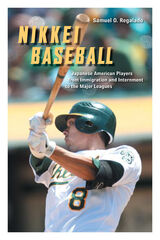 Nikkei Baseball: Japanese American Players from Immigration and Internment to the Major Leagues
Samuel Ragalado
University of Illinois Press, 2013 Nikkei Baseball examines baseball's evolving importance to the Japanese American community and the construction of Japanese American identity. Originally introduced in Japan in the late 1800s, baseball was played in the United States by Japanese immigrants first in Hawaii, then San Francisco and northern California, then in amateur leagues up and down the Pacific Coast. For Japanese American players, baseball was seen as a sport that encouraged healthy competition by imposing rules and standards of ethical behavior for both players and fans. The value of baseball as exercise and amusement quickly expanded into something even more important, a means for strengthening social ties within Japanese American communities and for linking their aspirations to America's pastimes and America's promise. With World War II came internment and baseball and softball played behind barbed wire. After their release from the camps, Japanese Americans found their reentry to American society beset by anti-Japanese laws, policies, and vigilante violence, but they rebuilt their leagues and played in schools and colleges. Drawing from archival research, prior scholarship, and personal interviews, Samuel O. Regalado explores key historical factors such as Meji-era modernization policies in Japan, American anti-Asian sentiments, internment during World War II, the postwar transition, economic and educational opportunities in the 1960s, the developing concept of a distinct "Asian American" identity, and Japanese Americans' rise to the major leagues with star players including Lenn Sakata and Kurt Suzuki and even managers such as the Seattle Mariners' Don Wakamatsu.
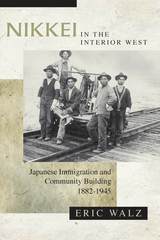 Nikkei in the Interior West: Japanese Immigration and Community Building, 1882–1945
Eric Walz
University of Arizona Press, 2012 Eric Walz's Nikkei in the Interior West tells the story of more than twelve thousand Japanese immigrants who settled in the interior West--Arizona, Colorado, Idaho, Nebraska, and Utah. They came inland not as fugitives forced to relocate after Pearl Harbor but arrived decades before World War II as workers searching for a job or as picture brides looking to join husbands they had never met. Despite being isolated from their native country and the support of larger settlements on the West Coast, these immigrants formed ethnic associations, language schools, and religious institutions. They also experienced persecution and discrimination during World War II in dramatically different ways than the often-studied immigrants living along the Pacific Coast. Even though they struggled with discrimination, these interior communities grew both in size and in permanence to become an integral part of the American West. Using oral histories, journal entries, newspaper accounts, organization records, and local histories, Nikkei in the Interior West explores the conditions in Japan that led to emigration, the immigration process, the factors that drew immigrants to the interior, the cultural negotiation that led to ethnic development, and the effects of World War II. Examining not only the formation and impact of these Japanese communities but also their interaction with others in the region, Walz demonstrates how these communities connect with the broader Japanese diaspora.
Nikola the Outlaw
Ivan Olbracht
Northwestern University Press, 2001 The invulnerable Nikola Suhaj lives a Robin Hood-like existence as he and his band rob travelers and rich Jewish merchants. Nikola seems invulnerable until a new police captain and a generous reward tempt his bandit cohorts into betraying him.
Ivan Olbracht's reputation as one of Czechoslovakia's most important authors stems from his works dealing with Ruthenia and the tensions between the two major ethnic groups of the region: the Ruthenians and the Jews. Weaving myth with realism, Nikola the Outlaw is considered Olbracht's masterpiece.
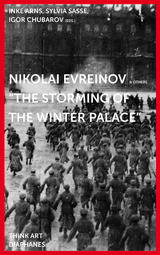 Nikolai Evreinov & Others: »The Storming of the Winter Palace«
Edited by Inke Arns, Sylvia Sasse, and Igor Chubarov
Diaphanes, 2017 In 1920, on the third anniversary of the October Revolution, dramatist Nikolai Evreinov directed a cast of 10,000 actors, dancers, and circus performers—as well as a convoy of armored cars and tanks—in The Storming of the Winter Palace. The mass spectacle, presented in and around the real Winter Palace in Petrograd, was intended to recall the storming as the beginning of the October Revolution. But it was a deceptive reenactment because, in producing the events it sought to reenact, it created a new kind of theater, agit-drama, promulgating political propaganda and deliberately breaking down the distinction between performers and spectators.
Nikolaj Evreinov: “The Storming of the Winter Palace” tells the fascinating story of this production. Taking readers through the relevant history, the authors describe the role of The Storming of the Winter Palace in commemorating Soviet power. With a wealth of illustrations, they also show how photographs of Evreinov’s theatrical storming eventually became historical documents of the October Revolution themselves.
 Nikolai Gogol: Between Ukrainian and Russian Nationalism
Edyta M. Bojanowska
Harvard University Press, 2007 No other writer captured the fraught relations between Ukrainian and Russian nationalisms with as much complexity and lasting relevance as Nikolai Gogol. This pathbreaking book illuminates the deep cultural stakes of today’s geopolitical conflict.
The nineteenth-century author Nikolai Gogol occupies a key place in the Russian cultural pantheon as an ardent champion of Russian nationalism. Indeed, he created the nation’s most famous literary icon: Russia as a rushing carriage, full of elemental energy and limitless potential.
In a pathbreaking book, Edyta M. Bojanowska topples the foundations of this russocentric myth of the Ukrainian-born writer, a myth that has also dominated his Western image. She reveals Gogol’s creative engagement with Ukrainian nationalism and calls attention to the subversive irony and ambiguity in his writings on Russian themes. While in early writings Gogol endowed Ukraine with cultural wholeness and a heroic past, his Russia appears bleak and fractured. Russian readers resented this unflattering contrast and called upon him to produce a brighter vision of Russia. Gogol struggled to satisfy their demands but ultimately failed.
In exploring Gogol’s fluctuating nationalist commitments, this book traces the connections and tensions between the Russian and Ukrainian nationalist paradigms in his work, and situates both in the larger imperial context. In addition to radically new interpretations of Gogol’s texts, Bojanowska offers a comprehensive analysis of his reception by contemporaries.
Brilliantly conceived and masterfully argued, Edyta Bojanowska fundamentally changes our understanding of this beloved author and his place in Russian literature.
Nikolai Klyuev: Time and Text, Place and Poet
Michael Makin
Northwestern University Press, 2010 Nikolai Klyuev is the first book in English to examine the life and work of this enigmatic poet. Klyuev (1884–1937) rose to prominence in the early twentieth century as the first of the so-called "new peasant poets" but later fell victim to Stalinist hostility to both his cultural ideology and his homosexuality. He was arrested and exiled in 1933, then shot in 1937.
Klyuev’s work incorporates rich elements of folklore, mysticism, politics, and religion, and he sometimes invokes arcane Russian syntax and vocabulary. Makin’s feat is particularly notable because Klyuev was often elusive in his own accounts of his life, and Makin successfully brings into focus the poet’s deliberate strategies of self-mythologization. Nikolai Klyuev is an indispensable guide to the life and the work of an important poet winning wider recognition outside of Russia.
 Nikolai Leskov: The Man and His Art
Hugh McLean
Harvard University Press, 1977 This is a stunning achievement: an examination of all of Nikolai Leskov's fiction, exploring the relationship between his personality and his art, between his life experience and the form and content of his works. It is the first book-length study of Leskov in English and the most comprehensive in any language.
Leskov (1831–1895) is a major figure in the great tradition of nineteenth century Russian fiction. He was underestimated in his lifetime by Russian critics, partly for political reasons (in an age dominated by radicals he opposed revolution and stressed improvement of individual moral standards) and partly for literary ones (in an age of giant novels, his best work was in the shorter forms). Yet he remained popular among readers, and since his death his reputation has steadily risen, despite official Soviet disapproval of his religious interests and antiradical stance. Hugh McLean's biographical account and analysis of Leskov's novellas and stories place the writer in Russian social, intellectual, and religious history.
 Nikolai Strakhov
Linda Gerstein
Harvard University Press, 1971 That Nikolai Nikolaevich Strakhov was always classified by his contemporaries as a "conservative" gives his life a special significance in Russian intellectual history. The myth of radical historiography has made him a victim of purposeful historical forgetfulness. In this respect he shares the fate of men like Aksakov, Danilevsky, and Katkov, indeed, of most Russian conservatives. Yet it is misleading to place him in such politically conservative company.
Strakhov was born in 1828, the same year as his great friend Leo Tolstoy and his great opponent Nikolai Chernyshevsky. His adult life spans the entire second half of the century. As a philosopher, literary critic, and journalist, he was involved in most of the major intellectual controversies of his time. He was personally close to and a major influence on the giants of the period: Tolstoy, Dostoevsky, Vladimir Solovev. One of the most penetrating thinkers of nineteenth-century Russia, he engaged in serious and often bitter debate with the leading intellectuals of Russian radicalism: Chernyshevsky, Pisarev, Mikhailovsky.
In this first full-length intellectual biography in any language of Strakhov, Linda Gerstein provides a guide both to the individual and to the amazingly complex picture of Russian intellectual life in the nineteenth century. Strakhov's concerns, she shows, were the major concerns of his era: positivism, nihilism, materialism, the woman question, Darwinism. In all these matters he displayed a consistent intelligence and independence, unusual in that time of intellectual faddishness, that make him a rewarding figure to study.
Nikolai Zabolotsky: Enigma and Cultural Paradigm
Sarah Pratt
Northwestern University Press, 2000 Sarah Pratt traces interwoven questions in the work of Nikolai Zabolotsky, a figure ranking just behind Pasternak, Mandelstram and Akhmatova in modern Russian poetry and the first major poet to come to light in the Soviet period.
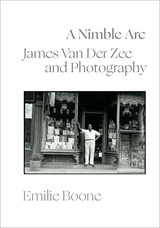 A Nimble Arc: James Van Der Zee and Photography
Emilie Boone
Duke University Press, 2023 While James Van Der Zee is widely known and praised for his studio portraits from the Harlem Renaissance era, much of the diversity and expansive reach of his work has been overlooked. From the major role his studio played for decades photographing ordinary people and events in the Harlem community to the inclusion of his photographs in the landmark Harlem on My Mind exhibition at the Metropolitan Museum of Art in 1969, Van Der Zee was a foundational Black photographer whose work illustrates the shifting ways photography serves as a constitutive force within Black life. In A Nimble Arc, Emilie Boone considers Van Der Zee’s photographic work over the course of the twentieth century, showing how it foregrounded aspects of Black daily life in the United States and in the larger African diaspora. Boone argues that Van Der Zee’s work exists at the crossroads of art and the vernacular, challenging the distinction between canonical art photographs and the kind of output common to commercial photography studios. Boone’s account recasts our understanding not only of this celebrated figure but of photography within the arc of quotidian Black life.
Nimble Believing: Dickinson and the Unknown
James McIntosh
University of Michigan Press, 2004 "The most subtly intelligent discussion of Dickinson's spirituality."
--Harold Bloom, Genius
" . . . a truly literary study in the largest, most humane, sense. Instead of subjecting poems to the distortions of theory, it brings biography, theology, psychology, and cultural history to bear on the intricacies of language, where all the issues of the poet's life and work converge, contend, and seek resolution."
--Albert Gelpi, American Literature
" . . . insightful readings of many of Dickinson's difficult poems and . . . a significant contribution to Dickinson studies."
---Choice
"McIntosh shows the power of Dickinson's religious quest in word, in verse, and in truth. He shows that she was much more than an ever-adolescent angry rebel trying to subvert the religious oppression of benighted Amherst neighbors."
---Emily Dickinson Journal
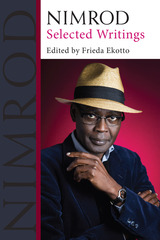 Nimrod: Selected Writings
Frieda Ekotto, editor
University of Michigan Press, 2018 The Chadian writer Nimrod—philosopher, poet, novelist, and essayist—is one of the most dynamic and vital voices in contemporary African literature and thought. Yet little of Nimrod’s writing has been translated into English until now. Introductory material by Frieda Ekotto provides context for Nimrod’s work and demonstrates the urgency of making it available beyond Francophone Africa to a broader global audience.
At the heart of this volume are Nimrod’s essays on Léopold Sédar Senghor, a key figure in the literary and aesthetic Négritude movement of the 1930s and president of Senegal from 1945 through 1980. Widely dismissed in recent decades as problematically essentialist, Senghorian Negritude articulated notions of “blackness” as a way of transcending deep divisions across a Black Diaspora under French colonial rule. Nimrod offers a nuanced reading of Senghor, drawing out the full complexities of Senghor’s philosophy and reevaluating how race and colonialism function in a French-speaking space.
Also included in this volume are Nimrod’s essays on literature from the 2008 collection, The New French Matter (La nouvelle chose française). Representing his prose fiction is his 2010 work, Rivers’ Gold (L’or des rivières). Also featured are some of Nimrod’s best-loved poems, in both English translation and the original French.
The works selected and translated for this volume showcase Nimrod’s versatility, his intellectual liveliness, and his exploration of questions of aesthetics in African literature, philosophy, and linguistics. Nimrod: Selected Writings marks a significant contribution toward engaging a broader audience with one of the vital voices of our time. This book will be essential reading for Anglophone students and scholars of African philosophy, literature, poetry, and critical theory, and will offer a welcome introduction to Nimrod for general readers of contemporary international writing.
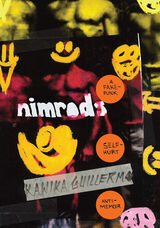 Nimrods: a fake-punk self-hurt anti-memoir
Kawika Guillermo
Duke University Press, 2023 In Nimrods, Kawika Guillermo chronicles the agonizing absurdities of being a newly minted professor (and overtired father) hired to teach in a Social Justice Institute while haunted by the inner ghosts of patriarchy, racial pessimism, and imperial arrogance. Charged with the “personal is political” mandate of feminist critique, Guillermo honestly and powerfully recounts his wayward path, from being raised by two preachers’ kids in a chaotic mixed-race family to his uncle’s death from HIV-related illness, which helped prompt his parents' divorce and his mother’s move to Las Vegas, to his many attempts to flee from American gender, racial, and religious norms by immigrating to South Korea, China, Hong Kong, and Canada. Through an often crass, cringey, and raw hybrid prose-poetic style, Guillermo reflects on anger, alcoholism, and suicidal ideation—traits that do not simply vanish after one is cast into the treacherous role of fatherhood or the dreaded role of professor. Guillermo’s shameless mixtures of autotheory, queer punk poetry, musical ekphrasis, haibun, academic (mis)quotations, and bad dad jokes present a bold new take on the autobiography: the fake-punk self-hurt anti-memoir.
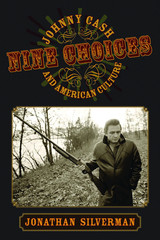 Nine Choices: Johnny Cash and American Culture
Jonathan Silverman
University of Massachusetts Press, 2010 For much of his career, Johnny Cash opened his shows with the tagline, "Hello, I'm Johnny Cash." This introduction seemed unnecessary, since everyone in the audience knew who he was—the famous musical artist whose career spanned almost five decades, whose troubled life on and off the stage received wide publicity, and whose cragged face seemed to express a depth and intensity not found in any other artist, living or dead.
For Cash, as for many celebrities, renown was the product of both hard work and luck. Often a visionary and always a tireless performer, he was subject to a whirlwind of social, economic, and cultural countercurrents. Nine Choices explores the tension between Cash's desire for mainstream success, his personal struggles with alcohol and drugs, and an ever-changing cultural landscape that often circumscribed his options.
Drawing on interviews, archival research, and textual analysis, Jonathan Silverman focuses on Cash's personal and artistic choices as a way of understanding his life, his impact on American culture, and the ways in which that culture in turn shaped him. Cash made decisions about where he would live, what he would play, who would produce his albums, whether he would support the Vietnam War, and even if he would flip his famous "bird"—the iconic image of Cash giving the finger which is now plastered on posters and T-shirts everywhere—in the context of cultural forces both visible and opaque. He made other decisions in consultation with a variety of people, many of whom were chiefly concerned with the reaction of his audiences.
Less a conventional biography than a study of the making of an identity, Nine Choices explores how Johnny Cash sought to define who he was, how he was perceived, and what he signified through a series of self-conscious actions. The result, Silverman shows, was a life that was often tumultuous but never uninteresting.
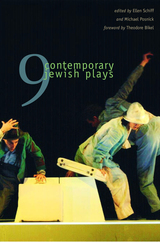 Nine Contemporary Jewish Plays
Edited by Ellen Schiff and Michael Posnick
University of Texas Press, 2005 Jewish theatre—plays about and usually by Jews—enters the twenty-first century with a long and distinguished history. To keep this vibrant tradition alive, the National Foundation for Jewish Culture established the New Play Commissions in Jewish Theatre in 1994. The commissions are awarded in an annual competition. Their goal is to help emerging and established dramatists develop new works in collaboration with a wide variety of theatres. Since its inception, the New Play Commissions has contributed support to more than seventy-five professional productions, staged readings, and workshops. This anthology brings together nine commissioned plays that have gone on to full production. Ellen Schiff and Michael Posnick have selected works that reflect many of the historical and social forces that have shaped contemporary Jewish experience and defined Jewish identity—among them, surviving the Holocaust, the Israeli-Palestinian conflict, and the lives of newcomers in America, Israel, and Argentina. Following a foreword by Theodore Bikel, the editors provide introductory explanations of the New Play Commissions and an overview of Jewish theatre. The playwrights comment on the genesis of their work and its production history.
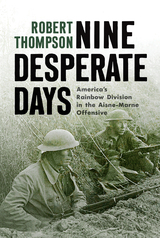 Nine Desperate Days: America's Rainbow Division in the Aisne-Marne Offensive
Robert Thompson
Westholme Publishing, 2022 American forces entered World War I combat in October 1917, but it was not until July 1918 that they went on the offensive for the first time. Among the units selected for this operation was the 42nd Division, or the “Rainbow Division” as it was known popularly. This division, which was composed of National Guard units from twenty-six states, including Joyce Kilmer’s 69th New York Infantry, would spend 164 days in combat, a number exceeded by only two other American divisions. However, it was the nine days from July 25 to August 2, 1918 that were the most terrible and heroic in the division’s history. General of the Army Douglas MacArthur, who served as the division’s chief of staff, later said of the Rainbow Division’s fighting during those pivotal days, “There was neither rest nor mercy.” During those nine days, the Rainbow Division would spearhead the Allied attack in the Aisne-Marne region, the final phase of the Second Battle of the Marne, which saw the last major German offensive on the Western Front defeated. Unfortunately, American leadership proved to be completely unprepared for a dynamic war of maneuver. Basing decisions on wildly inaccurate information about the Germans, senior commanders ordered the men of the Rainbow Division to make ill-advised assaults again and again with little support. Facing an enemy who was determined to hold itspositions, these National Guardsmen fought with courage and determination to gain what was often only yards of ground, and did so at a deadly cost. In Nine Desperate Days: America’s Rainbow Division in the Aisne-Marne Offensive, historian Robert Thompson chronicles the hardships and tenacity of the men from the 42nd Division during this pivotal campaign. The Americans did not break despite heavy losses, and were able to drive the Germans back from territory they initially gained. The efforts of the Rainbow Division during Aisne-Marne were key to the ultimate Allied victory and are a symbol of American valor and sacrifice during the “war to end all wars.”
Nine Fairy Tales: and One More Thrown in for Good Measure
Karl Capek
Northwestern University Press, 1996 Karel Čapek, author of the acclaimed War with the Newts, is one of the great Czechoslovak writers of the twentieth century. These fairy tales bear Čapek's combination of the fantastic and the satirical, offering fairies, elves, and talking animals alongside references to detectives, secret police agents, luxury automobiles, and Hollywood starlets. Filled with the delight of language, dazzling wordplay, a sense of absurdity about the so-called adult world, and a deeply humane vision, these witty stories will appeal to readers of all ages.
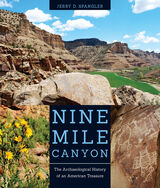 Nine Mile Canyon: The Archaeological History of an American Treasure
Jerry D. Spangler
University of Utah Press, 2013 With an estimated 10,000 ancient rock art sites, Nine Mile Canyon has long captivated people the world over. The 45-mile-long canyon, dubbed the “World’s Longest Art Gallery,” hosts what is believed to be the largest concentration of rock art in North America. But rock art is only part of the amazing archaeological fabric that scholars have been struggling to explain for more than a century. Jerry D. Spangler takes the reader on a journey into Nine Mile Canyon through the eyes of the generations of archaeologists who have gone there only to leave bewildered by what it all means.
The early visitors in the 1890s were determined to recover collections for museums but never much cared to understand the people who left the artifacts. Then came a cadre of young scientists—the first to be trained specifically in archaeology—who found Nine Mile Canyon to be an intriguing laboratory that yielded more questions than answers. Scholars such as Noel Morss, Donald Scott, Julian Steward, John Gillin, and John Otis Brew all left their boot prints there.
Today, archaeological research is experiencing another renaissance—a new generation of university-trained archaeologists is determined to unravel the mystery of Nine Mile Canyon using scientific tools and techniques that were unavailable to past generations. Through the words and thoughts of the archaeologists, as well as the more than 150 photos, readers will come to see Nine Mile Canyon as an American treasure unlike any other. As the first book that is devoted exclusively to the archaeology of this unique place, Nine Mile Canyon will evoke fascination among scholars and the general public alike.
Winner of a Choice Outstanding Academic Title award.
Nine Months Is a Year: At Baboquívari School
Eulalia Bourne
University of Arizona Press, 1968 From the author of the widely acclaimed Woman in Levi’s, this colorful autobiography follows a year in the lives of the lone woman rancher, her students, and their families in 1930s rural Southern Arizona.
The Nine Pillars of Technologies for Industry 4.0
Wai Yie Leong
The Institution of Engineering and Technology, 2021 Industry 4.0 refers to automation and data exchange in manufacturing technologies. From innovative research, challenges, solutions and strategies to real-world case studies, the aim of this edited book is to focus on the nine pillars of technology that are supporting the transition to Industry 4.0 and smart manufacturing. The nine pillars include the internet of things, cloud computing, autonomous and robotics systems, big data analytics, augmented reality, cyber security, simulation, system integration, and additive manufacturing. A key role is played by the industrial IoTs and state-of-the-art technologies such as fog and edge computing, advanced data analytics, innovative data exchange models, artificial intelligence, machine learning, mobile and network technologies, robotics and sensors.
 Nine Skies: POEMS
A. V. Christie
University of Illinois Press, 1997 Selected by Sandra McPherson
for the 1996 National Poetry Series
The late poet James V. Dickey
was judge of the Yale Prize poetry competition when he wrote to A. V.
Christie, one of the finalists, "I have become very fond of your
poems, especially the elegiac ones. . . . Your work is heartfelt; one
believes every word of it. . . . You have given me much in-depth pleasure;
have moved me strongly."
The work in Nine Skies
is as Dickey described it--heartfelt, moving. Here is what others
say about it:
"Beautifully crafted
and sustained, with six or seven poems as fine as anything being written
today. This remarkable book is a rite of passage for the poet and speaks
of even better things to come." -- Elizabeth Spires
"Only the best poetry
is written this well, with this much craft and conviction. Of course the
poems are meditative and elegiac, brilliant and finely detailed, but they
are also thought through and wholly felt, so that even in their small
moments they celebrate."
-- Stanley Plumly
"A. V. Christie writes
with a Romantic's eye and a Realist's heart, so there is no sentimentality,
that sickness afflicting our age. The voice on these pages is hard-bitten,
luxuriant, and true." -- Henri Cole
"Nine Skies is
a graceful realization in each detail of elegy or celebration." --
Sandra McPherson
Nineteenth Century Home Architecture of Iowa City: A Silver Anniversary Edition
Margaret N. Keyes
University of Iowa Press, 1993 Newly expanded with over twenty new houses and twenty-five new photographs—plus a map that allows readers to explore Iowa City's historic neighborhoods! This silver anniversary edition of Margaret Keyes' 1967 classic will be required reading for all those fascinated by local history and by the development of architectural styles in the Midwest and for all those devoted to restoring and preserving historic houses.
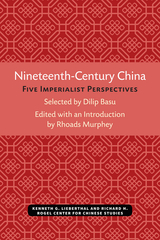 Nineteenth-Century China: Five Imperialist Perspectives
Selected by Dilip Basu. Edited with an introduction by Rhoads Murphey
University of Michigan Press, 1972 Materials from the past that wrongly anticipate the future, or present information or judgments that are later proved misleading or erroneous, are sometimes overlooked in reconstructing the past. Yet such documents are as legimiate, and perhaps as important, as those that are vindicated by events or continue to share perspectives with later generations. The five documents reproduced in Nineteenth-Century China are typical of the periods from which they come, but each was overtaken or contradicted by events. Collected with a belief in the legitimacy of attempting to see every period as much as possible in its own terms, these texts offer a glimpse of what China looked like and suggested to Englishmen on the spot in Canton and Hong Kong in the first half of the nineteenth century, and how they viewed their own country and its role vis-à-vis the China they observed. The first two texts in Nineteenth-Century China exemplify the imperialist mind’s eagerness to explore the world, to get a picture of all of its parts, and as rapidly as possible to “open” all areas to the benificent influence of the West, notably through an expanded commerce that would enrich its Western masters. Samuel Ball’s “Observations” (1817) show how much detailed information was available to Westerners and what the mercantile British were after, and an anonymous dissertation (1838) provides an example of the dream of the China as El Dorado: an immense population of eager traders, hard workers, and willing buyers. The third text (1845) is an early foreshadowing by a colonial official, R. M. Martin, of Western imperial arguments, rationalizations, and attitudes that would become common fifty years later. The fourth selection consists of an exchange of correspondence in 1847 about British access to and use of land in the vicinity of Canton. A short statement of purpose (1848) from the Morrison Education Society, demonstrating a missionary enterprise combining Christian evangelism and English education, concludes the book.
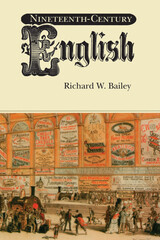 Nineteenth-Century English
Richard W. Bailey
University of Michigan Press, 1998 Jane Austen's English is far different from Virginia Woolf's, but historians of the English language have given scant attention to the ways in which English changed over the course of the nineteenth century. In Nineteenth-Century English, Richard W. Bailey treads new ground by showing the extent to which the language changed as cultural and economic transformations brought us into the modern world.
Six aspects of nineteenth-century English are treated in separate chapters: writing, sounds, words, slang, grammar, and "voices." In each domain, innovation and obsolescence are discussed as they were observed by contemporary writers. Thus Bailey shows how linguistic details gained powerful social meaning in the emergent stratification by class, region, race, and gender of the anglophone community.
At the beginning of the century, the "Italian" sound of a in dance was thought to be an intolerable vulgarity; by the end, it was a sign of the highest refinement. At the beginning, OK had yet to be invented; by the end, it was being used in nearly all varieties of English and had appeared as a loanword in many languages touched by English. At the beginning, mixed forms of English--pidgins and creoles--were little known and thoroughly despised; by the end some of them had become vehicles for Bible translation. As English became a global language, it took on the local color of its surroundings, and proper usage became ever more important as an index of social worth, as a measure of intelligence, and as a gauge to a person's suitability for employment, often resulting in painful consequences. What the language was like changed dramatically. What people thought about the language changed even more.
"The tale that Bailey has to tell . . . is little short of enthralling. Drawing on previously neglected material--novels, magazines, letters and diaries--he shows how the language came into the century a Georgian popinjay and left it a sober-suited man of business, purged of quirks and flashy curiosities. Along the way, Bailey uncovers a language which, while it seems familiar enough on the printed page of a Jane Austen novel, was actually quite different from the English we use today. . . ." --Robert McCrum, Observer (London)
Language changes as time goes by. Modern listeners can barely comprehend Old and Middle English. Although we are able to understand nineteenth-century English, the language changed with the effects of industrialization, urbanization, bilingualism, and growing literacy. In this book, Richard Bailey uses numerous examples and illustrations to demonstrate the changes in English. Furthermore, he identifies the connections between social events and linguistic transformation.
". . . a highly engaging study of a broad and difficult subject. Bailey is an excellent writer--the chapters are well-organized and written in a vigorous style that is buoyed by a wry sense of humor. . . ." --Lexicographia
". . . entertaining, lucid, packed with detail, and refreshingly alert to the arresting quotation. If it is unusual to associate pleasurable reading with the scholarly analysis of language, Bailey also makes clear the serious philological and political implications of his study." -- Times Literary Supplement
Richard Bailey is Professor of English, University of Michigan, and is known internationally as an expert on social and regional varieties of English.
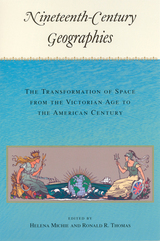 Nineteenth-Century Geographies: The Transformation of Space from the Victorian Age to the American Century
Thomas, Ronald R
Rutgers University Press, 2002 The nineteenth century was a time of unprecedented discovery and exploration throughout the globe, a period when the “blank spaces” of the earth were systematically investigated, occupied, and exploited by the major imperial powers of Western Europe and the United States. The lived experience of space was also changing in dramatic ways for people as a result of new developments in technology, communication, and transportation. As a result, the century was characterized by a new and intense interest in place, both local and global.
The collection is comprised of seventeen essays from various disciplines organized into four areas of geographic concern. The first, “Time Zones,” examines several ways that place gets expressed as time during the period, how geography becomes history. A second grouping, “Commodities and Exchanges,” explores the role of geographic origin as it was embodied in particular objects, from the souvenir map to imported tea. The set of essays on “Domestic Fronts” moves the discussion from the public to the private sphere by looking at how domestic space became defined in terms of its boundary with the foreign. The final section, “Orientations,” takes up the changing relations of bodies, identities, and the spaces they inhabit and through which they moved. The collection as a whole also traces the development of the discipline of geography with its different institutional and political trajectories in the United States and Great Britain.
 Nineteenth-Century Philosophy: Revolutionary Responses to the Existing Order
Edited by Alan D. Schrift and Daniel Conway
University of Chicago Press, 2010 From Kant to Kierkegaard, from Hegel to Heidegger, continental philosophers have indelibly shaped the trajectory of Western thought since the eighteenth century. Although much has been written about these monumental thinkers, students and scholars lack a definitive guide to the entire scope of the continental tradition. The most comprehensive reference work to date, this eight-volume History of Continental Philosophy will both encapsulate the subject and reorient our understanding of it. Beginning with an overview of Kant’s philosophy and its initial reception, the History traces the evolution of continental philosophy through major figures as well as movements such as existentialism, phenomenology, hermeneutics, and poststructuralism. The final volume outlines the current state of the field, bringing the work of both historical and modern thinkers to bear on such contemporary topics as feminism, globalization, and the environment. Throughout, the volumes examine important philosophical figures and developments in their historical, political, and cultural contexts.
The first reference of its kind, A History of Continental Philosophy has been written and edited by internationally recognized experts with a commitment to explaining complex thinkers, texts, and movements in rigorous yet jargon-free essays suitable for both undergraduates and seasoned specialists. These volumes also elucidate ongoing debates about the nature of continental and analytic philosophy, surveying the distinctive, sometimes overlapping characteristics and approaches of each tradition. Featuring helpful overviews of major topics and plotting road maps to their underlying contexts, A History of Continental Philosophy is destined to be the resource of first and last resort for students and scholars alike.
Nineteenth-Century Rhetoric in North America
Nan Johnson
Southern Illinois University Press, 1991 Johnson argues that nineteenth-century rhetoric was primarily synthetic, derived from the combination of classical elements and eighteenth-century belletristic and epistemological approaches to theory and practice. She reveals that nineteenth-century rhetoric supported several rhetorical arts, each conceived systematically from a similar theoretical foundation.
 Nineteenth-Century Scottish Rhetoric: The American Connection
Winifred Bryan Horner
Southern Illinois University Press, 1992
Winifred Bryan Horner argues that an understanding of the changes that occurred in the content of nineteenth-century courses in logic, rhetoric, and belles lettres taught in Scottish universities provides important critical insight into the development of the twentieth-century American composition course, as well as courses in English literature and critical theory.
Because of the inaccessibility of primary materials documenting the changes in courses taught at Scottish universities, the impression remains that the nineteenth century represents a break with the traditional school curriculum rather than a logical transition to a new focus of study. Horner has discovered that the notes of students who attended these classes—meticulously transcribed records of the lectures that professors dictated in lieu of printed texts—provide reliable documentation of the content of courses taught during the period. Using these records, Horner traces the evolution of current traditional composition, developed in the United States in the first part of the twentieth century, from courses taught in nineteenth-century, northern Scottish universities. She locates the beginning of courses in English literature and belletristic composition in the southern schools, particularly Edinburgh.
Horner’s study opens new vistas for the study of the evolution of university curricula, especially the never before acknowledged influence of belletristric rhetoric on the development of the North American composition course.
 Nineteenth-Century Spanish America: A Cultural History
Christopher Conway
Vanderbilt University Press, 2015 Nineteenth-Century Spanish America: A Cultural History provides a panoramic and accessible introduction to the era in which Latin America took its first steps into the Modern Age. Including colorful characters like circus clowns, prostitutes, bullfighters, street puppeteers, and bestselling authors, this book maps vivid and often surprising combinations of the new and the old, the high and the low, and the political and the cultural. Christopher Conway shows that beneath the diversity of the New World there was a deeper structure of shared patterns of cultural creation and meaning. Whether it be the ways that people of refinement from different countries used the same rules of etiquette, or how commoners shared their stories through the same types of songs, Conway creates a multidisciplinary framework for understanding the culture of an entire hemisphere.
The book opens with key themes that will help students and scholars understand the century, such as the civilization and barbarism binary, urbanism, the divide between conservatives and liberals, and transculturation. In the chapters that follow, Conway weaves transnational trends together with brief case studies and compelling snapshots that help us understand the period. How much did books and photographs cost in the nineteenth century? What was the dominant style in painting? What kinds of ballroom dancing were popular? Richly illustrated with striking photographs and lithographs, this is a book that invites the reader to rediscover a past age that is not quite past, still resonating into the present.
Nineteenth-Century Women at the Movies: Adapting Classic Women's Fiction to Film
Barbara Tepa Lupack
University of Wisconsin Press, 1999 Even in Hollywood’s world of blockbusters and special effects, there continues to be interest in “quieter” adaptations based on the works of writers of other eras, especially the classic novels of nineteenth-century women. Those novels emphasize strong female protagonists, fine language, and sensitivity to social nuances.
This volume’s twelve essays offer critical insights not only into the visions of the novelist and the filmmaker but also into contemporary cultural concerns. The adaptations of novels by eight popular writers are analyzied: Mary Shelley, Jane Austen, Charlotte Brontë, Emily Brontë, Harriet Beecher Stowe, Louisa May Alcott, Ouida, and George Eliot.
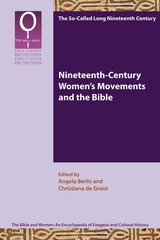 Nineteenth-Century Women’s Movements and the Bible
Angela Berlis
SBL Press, 2024 Nineteenth-Century Women’s Movements and the Bible examines politically motivated women’s movements in the nineteenth century, including the legal, cultural, and ecclesiastical contexts of women. Focusing on the period beginning with the French Revolution in 1789 through the end of World War I in 1918, contributors explore the many ways that women’s lives were limited in both the public and domestic spheres. Essays consider the social, political, biblical, and theological factors that resulted in a multinational raising of awareness and emancipation for women in the nineteenth century and the strengthening of their international networks. The contributors include Angela Berlis, Kristin Kobes Du Mez, Ute Gerhard, Christiana de Groot, Arnfriður Guðmundsdóttir, Izaak J. de Hulster, Elisabeth Joris, Christine Lienemann-Perrin, Amanda Russell-Jones, Claudia Setzer, Aud V. Tønnessen, Adriana Valerio, and Royce M. Victor.
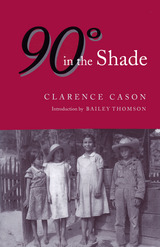 Ninety Degrees in the Shade
Clarence E. Cason
University of Alabama Press, 2001 Clarence Cason belonged to that restless generation of southern intellectuals who, between the world wars, questioned the South's stubborn traditionalism, even as they tried to explain and defend its distinctiveness. From his professorial perch at The University of Alabama, Cason wrote polished essays for leading national publications while contributing weekly editorials for newspaper readers. As a journalist in academia, he cultivated a broad audience for his eloquent though tentative observations about the "character" of a region that seemed to be a separate province of the nation. In 1935, Cason collected his thoughts in a small book of essays titled 90° in the Shade. In it, he declared that climate and the relaxation afforded by field and stream had given southerners excellent reasons for their notoriously slow pace of life. Still, he wrote, "there is much work that ought to be done below the Potomac." Cason captured the pathos of race relations and other persistent problems and declared that the abominable practice of lynching would end when the best people of the South risked their personal and commercial standing to denounce it. Just days before the book's publication, however, Cason shot himself in his campus office. He left no explanation, but apparently he feared angry reaction from fellow citizens to his mild criticisms and gentle suggestions for change. The University of Alabama Press brought the book back into print in 1983. This new edition of Cason's classic features an introduction by journalist and UA professor H. Bailey Thomson, allowing yet another generation the enjoyment of Cason's perceptive writing, not so much for any remedy he proposed but rather for the open-minded and loving way in which he addressed the region's tragic experience.
 Ninety Degrees In The Shade
Clarence E. Cason
University of Alabama Press, 1983 Clarence Cason belonged to that restless generation of southern intellectuals who, between the world wars, questioned the South's stubborn traditionalism, even as they tried to explain and defend its distinctiveness. From his professorial perch at The University of Alabama, Cason wrote polished essays for leading national publications while contributing weekly editorials for newspaper readers. As a journalist in academia, he cultivated a broad audience for his eloquent though tentative observations about the "character" of a region that seemed to be a separate province of the nation.
In 1935, Cason collected his thoughts in a small book of essays titled 90° in the Shade. In it, he declared that climate and the relaxation afforded by field and stream had given southerners excellent reasons for their notoriously slow pace of life. Still, he wrote, "there is much work that ought to be done below the Potomac." Cason captured the pathos of race relations and other persistent problems and declared that the abominable practice of lynching would end when the best people of the South risked their personal and commercial standing to denounce it. Just days before the book's publication, however, Cason shot himself in his campus office. He left no explanation, but apparently he feared angry reaction from fellow citizens to his mild criticisms and gentle suggestions for change.
The University of Alabama Press brought the book back into print in 1983. This new edition of Cason's classic features an introduction by journalist and UA professor H. Bailey Thomson, allowing yet another generation the enjoyment of Cason's perceptive writing, not so much for any remedy he proposed but rather for the open-minded and loving way in which he addressed the region's tragic experience.
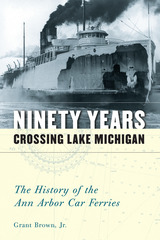 Ninety Years Crossing Lake Michigan: The History of the Ann Arbor Car Ferries
Grant Brown, Jr.
University of Michigan Press, 2008 "A must buy for anyone interested in the Great Lakes."
---Frederick Stonehouse, maritime historian In 1892, the Ann Arbor Car Ferries shook the transportation world by doing what was then deemed impossible---carrying loaded railroad cars by ship across the sixty-two miles of open water between Frankfort, Michigan and Kewaunee, Wisconsin. With passion, acuity, and remarkable detail, Grant Brown describes the nearly 100-year crossings---from their beginnings with James Ashley's bold new idea of car ferrying down to the last fight for survival until the Michigan Interstate Rail Company finally closed in 1982. Crossing the lake with loaded freight cars was a treacherous task that presented daily obstacles. Knowledgeable people believed it was impossible to secure rail cars from tipping over and sinking the ship. Weather and ice presented two near-insurmountable hurdles, making car ferrying doubly difficult in the winter when nearly all shipping on the Great Lakes shut down. This vivid history gives voice to the ships and their crews as they battled the storms without modern navigational aids or adequate power. This spirited account of the Ann Arbor car ferries draws on ships' logs from various museums, over 2,000 newspaper articles, annual reports from 1889 through 1976, and interviews with former employees. The result is a living history of the ships, the crews, and their adventures; of the men who built and ran the business; and of the enormous influence the vessels had on the communities they served. Grant Brown, Jr., worked for S.D. Warren Company, a paper manufacturer, for 37 years. He raced sailboats on Crystal Lake in northern Michigan for ten years while growing up, continued in Boston and St. Louis, and has since returned to living and racing in Frankfort, Michigan. He spent eight years in the U.S. Coast Guard Reserve, where he learned navigation and shipboard procedure.
 Ninety Years Crossing Lake Michigan: The History of the Ann Arbor Car Ferries
Grant Brown, Jr.
University of Michigan Press, 2008 "A must buy for anyone interested in the Great Lakes."
---Frederick Stonehouse, maritime historian In 1892, the Ann Arbor Car Ferries shook the transportation world by doing what was then deemed impossible---carrying loaded railroad cars by ship across the sixty-two miles of open water between Frankfort, Michigan and Kewaunee, Wisconsin. With passion, acuity, and remarkable detail, Grant Brown describes the nearly 100-year crossings---from their beginnings with James Ashley's bold new idea of car ferrying down to the last fight for survival until the Michigan Interstate Rail Company finally closed in 1982. Crossing the lake with loaded freight cars was a treacherous task that presented daily obstacles. Knowledgeable people believed it was impossible to secure rail cars from tipping over and sinking the ship. Weather and ice presented two near-insurmountable hurdles, making car ferrying doubly difficult in the winter when nearly all shipping on the Great Lakes shut down. This vivid history gives voice to the ships and their crews as they battled the storms without modern navigational aids or adequate power. This spirited account of the Ann Arbor car ferries draws on ships' logs from various museums, over 2,000 newspaper articles, annual reports from 1889 through 1976, and interviews with former employees. The result is a living history of the ships, the crews, and their adventures; of the men who built and ran the business; and of the enormous influence the vessels had on the communities they served. Grant Brown, Jr., worked for S.D. Warren Company, a paper manufacturer, for 37 years. He raced sailboats on Crystal Lake in northern Michigan for ten years while growing up, continued in Boston and St. Louis, and has since returned to living and racing in Frankfort, Michigan. He spent eight years in the U.S. Coast Guard Reserve, where he learned navigation and shipboard procedure.
 Ninety-Eight Days: Geographers View Vicksburg Campaign
Warren E. Grabau
University of Tennessee Press, 2000 Grant's campaign against Vicksburg has been studied from a number of perspectives—but always with the outcome in the foreground. This documented history of the final phases of the Vicksburg Campaign, from March 29 through July 4, 1863, examines the actions of Union and Confederate commanders as they unfolded, reconstructing their decisions based only on what they knew at any given time.
In meticulous detail, Warren E. Grabau describes the logistical situation at key junctures during the campaign and explains how and why those situations constrained the choices available to Grant and Confederate commander John C. Pemberton. Alternating between Confederate and Federal perspectives, he allows the reader to see the situation as the commanders did and then describes how the available information led to their decisions.
Grabau examines not only topographic and hydrographic features but also strategic, political, economic, and demographic factors that influenced the commanders’ thinking. He analyzes the effectiveness of the intelligence-gathering capabilities of each side, shows how the decisions of both commanders were affected by the presence of the Union Navy, and describes the impact of political philosophies and command structures on the conduct of the campaign. Through his detailed analysis, Grabau even suggests that Grant had no actual campaign plan but was instead a master opportunist, able to exploit every situation.
Remarkably detailed maps reconstruct the terrain as it was at the time and show how incomplete data often resulted in poor military decisions. Other supportive material includes Command Structures of the Federal and Confederate Forces in diagrammatic form as they stood at the beginning of the ninety-eight days.
Ninety-eight Days is a monumental work masterfully executed, a reconstruction of military reasoning that is more analytical than any previous study of Vicksburg. It contributes substantially to our understanding of those military operations and demonstrates how crucial geography is to the conduct of war.
The Author: Warren E. Grabau is a retired geologist with a long interest in the Civil War. He is he coauthor of two earlier books: Evolution of Geomorphology; A Nation-by-Nation Summary of Development (with H. J. Walker) and The Battle of Jackson, May 14, 1863 (with Edwin C. Bearss).
Ninety-nine Gnats, Nits, and Nibblers
May R. Berenbaum
University of Illinois Press, 1989 In this classic of natural history, National Medal of Science winner May Berenbaum weaves a web of spellbinding portraits that acquaints readers with the multitudes sharing our world and, alas, our kitchen. Go small or go home as Berenbaum reveals:
Why the "Jesus bug" can walk on water
How the katydid’s nighttime noise inspired romantic poetry
The trapping prowess of the hungry antlion
That disgusting thing chiggers do to eat your skin
A witty and educational guide that’s as accessible as the container of flour you should have closed more tightly, Ninety-nine Gnats, Nits, and Nibblers is the fascinating story of our million closest neighbors.
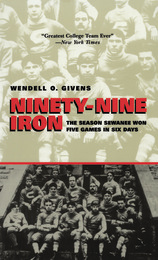 Ninety-Nine Iron: The Season Sewanee Won Five Games in Six Days
Wendell Givens
University of Alabama Press, 2003 The fascinating story of the 1899 Sewanee football team’s remarkable, unassailable winning streak
Ninety-Nine Iron is the story of the 1899 Sewanee football team. The University of the South, as it is formally called, is a small Episcopal college on Mounteagle Mountain in southeastern Tennessee. It is a respected academic institution not known for its athletic programs. But in that final year of the 19th century the Sewanee football team, led by captain “Diddy” Seibels, produced a record that is legendary.
In six days, on a grueling 2,500-mile train trip, the team defeated Texas, Texas A&M, Tulane, Louisiana State University, and Ole Miss—all much larger schools than Sewanee. In addition to this marathon of victory, the 21 members of the Sewanee Iron Men won all 12 of their regular games, and of their 12 opponents, only Auburn managed to score at all against them. Ten of these 12 victories were against Southern Intercollegiate Athletic Association opponents, which put Sewanee in the record books for most conference games played and most won in a season.
In Ninety-Nine Iron, Wendell Givens provides a play-by-play account of that remarkable season. He includes an overview of campus life at Sewanee and profiles of the players, the team’s coach (Billy Suter), the manager (Luke Lea), and the trainer (Cal Burrows). In the five years he researched the work, Givens conducted interviews with Seibels and visited the five cities in which the Iron Men had played—Austin, Houston, New Orleans, Baton Rouge, and Memphis. Givens has written a vivid account of a sports achievement not likely to be seen again.
Ninety-nine More Maggots, Mites, and Munchers
May R. Berenbaum
University of Illinois Press, 1993 What lives in a reindeer’s nose? Glad you asked. In this sequel to Ninety-nine Gnats, Nits, and Nibblers, National Medal of Science winner May Berenbaum offers another classic compendium of creepy-crawly cameos. Read up on our myriad arthropodan indignities and allies as Berenbaum reveals:
Why the rove beetle gives mind-altering drugs to ants
How the snail-killing fly enjoys its escargot
Why Piophila casei doesn’t care when you eat its larvae
What strange fate awaits a honey ant worker engorged with nectar
As lively as a fly in the buttermilk, Ninety-nine More Maggots, Mites, and Munchers is a who’s who and what’s THAT? guide to Lilliputian life-forms both familiar and obscure.
The Ninth: A Novel
Ferenc Barnas
Northwestern University Press, 2009 Set in a sleepy village north of Budapest in 1968, this touching, unsettling novel paints a richly wrought portrait of mid-twentieth-century Hungary. The narrator is the ninth child of a family distinguished by its size, poverty, faith, and abundance of physical and psychological disabilities. His confusion is exacerbated by the strict, secretive Catholic household his parents keep in the face of a Communist system. These dual oppressions propel him toward an inevitable realization of his guilt and desire that speaks to his struggle with a fateful, seamless beauty.
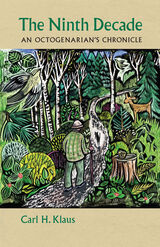 The Ninth Decade: An Octogenarian’s Chronicle
Klaus, Carl H.
University of Iowa Press, 2021 The Ninth Decade is a path-breaking and timely book on aging: the first to focus explicitly and at length on eighty-somethings, the fastest-growing demographic in the industrialized world. Covering eight years in lively six-month installments, Klaus tells a vivid story not only of his own ninth decade and survival routines, but also of his loving companion, Jackie, who is strikingly different from him in her physical well-being, practical outlook, sociable temperament, and vigorous workouts. Cameos of their octogenarian friends and relatives near and far add to a wide-ranging and revelatory portrayal of advanced aging, as do bios of notable octogenarians.
The multi-year scope of his chronicle reveals the numerous physical and mental problems that arise during octogenarian life and how eighty-year-olds have dealt with those challenges. The Ninth Decade is a unique, first-hand source of information for anyone in their sixties, seventies, or eighties, as well as for persons devoted to care of the aged. Though the challenges of octogenarian life often require specialized care, The Ninth Decade also shows the pleasures of it to be so special as to have inspired Lillian Hellman’s paradoxical description of “longer life” as “the happy problem of our time.”
The Niobe Poems
Kate Daniels
University of Pittsburgh Press, 1988 Kate Daniels’s central myth is that of Niobe, the mother in Greek mythology whose children were killed by the gods because of her great pride in them. She taps the lasting power of the ancient story in poems about personal loss and political insanity. Though the subjects are frequently grim, the final effect of the book is not, since Daniels’s central theme is endurance, the discovery of what we need to survive.
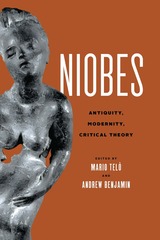 Niobes: Antiquity, Modernity, Critical Theory
Edited by Mario Telò and Andrew Benjamin
Ohio State University Press, 2024 A marginalized but persistent figure of Greek tragedy, Niobe, whose many children were killed by Apollo and Artemis, embodies yet problematizes the philosophically charged dialectics between life and death, mourning and melancholy, animation and inanimation, silence and logos. The essays in Niobes present her as a set of complex figurations, an elusive mythical character but also an overdetermined figure who has long exerted a profound influence on various modes of modern thought, especially in the domains of aesthetics, ethics, psychoanalysis, and politics. As a symbol of both exclusion and resistance, Niobe calls for critical attention at a time of global crisis. Reconstructing the dialogues of Phillis Wheatley, G. W. F. Hegel, Walter Benjamin, Aby Warburg, and others with Niobe as she appears in Aeschylus, Sophocles, Ovid, and the visual arts, a collective of major thinkers—classicists, art historians, and critical theorists—reflect on the space that she can occupy in the humanities today. Inspiring new ways of connecting the classical tradition and ancient tragic discourse with crises and political questions relating to gender, race, and social justice, Niobe insists on living on. Contributors: Barbara Baert, Andrew Benjamin, drea brown, Adriana Cavarero, Rebecca Comay, Mildred Galland-Szymkowiak, John T. Hamilton, Paul A. Kottman, Jacques Lezra, Andres Matlock, Ben Radcliffe, Victoria Rimell, Mario Telò, Mathura Umachandran, Daniel Villegas Vélez
Nisa: The Life and Words of a !Kung Woman
Marjorie Shostak
Harvard University Press, 1981 This classic paperback is available once again—and exclusively—from Harvard University Press.This book is the story of the life of Nisa, a member of the !Kung tribe of hunter-gatherers from southern Africa’s Kalahari desert. Told in her own words—earthy, emotional, vivid—to Marjorie Shostak, a Harvard anthropologist who succeeded, with Nisa’s collaboration, in breaking through the immense barriers of language and culture, the story is a fascinating view of a remarkable woman.
Nisei Sansei
Jere Takahashi
Temple University Press, 1998 A thorough examination of the diverse political styles of second and third generation Japanese Americans and their resonance within the changing racial dynamics and political complexities in the United States.
 Nisei: The Quiet Americans, Revised Edition
Bill Hosokawa
University Press of Colorado, 2002 Hailed at the time of its publication in 1969, Bill Hosokawa's Nisei remains an inspiring account of the original Japanese immigrants and their role in the development of the West. Hosokawa recounts the ordeals faced by the immigrant generation and their American-born offspring, the Nisei; the ill-advised government decisions that led to their uprooting during World War II; how they withstood harsh camp life; and their courageous efforts to prove their loyalty to the United States. As Hosokawa additionally demonstrates, since World War II, Japanese Americans have achieved exceptional social, economic, and political progress. Their efforts led to apologies by four U.S. presidents for wartime injustices and redress through the landmark Civil Liberties Act of 1988. Brought up-to-date in this newly revised edition, Nisei details the transformation of these "quiet Americans" from despised security risks to respected citizens.
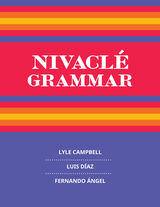 Nivaclé Grammar
Lyle Campbell, Luis Díaz, and Fernando Ángel
University of Utah Press, 2020 This book offers an extensive description of Nivaclé, an indigenous language spoken in the Gran Chaco region of Argentina and Paraguay. Nivaclé’s phonology, morphology, and syntax are complex; the language has no tenses marked on verbs, essentially no prepositions, and a sizable number of lexical suffixes whose content is so concrete they would be expected to be independent words in most other languages. Nivaclé has a unique speech sound, /k͡ l/, known nowhere else. In some locations where it is spoken, multilingual conversations are the norm. These and other rare traits make Nivaclé an especially fascinating language for linguists, with many implications for language typology and linguistic theory. The book is based on dozens of audio and video recordings of narratives and on hundreds of hours of elicitation and analysis with native speakers. Four lengthy texts are included here to demonstrate the language in action. Scholars—whether in anthropology, folklore, geography, history, or language—will find value in the narratives included here and in the insights into Nivaclé life and culture found throughout the book.
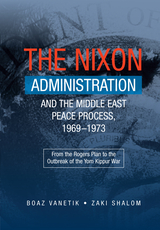 The Nixon Administration and the Middle East Peace Process, 1969-1973: From the Rogers Plan to the Outbreak of the Yom Kippur War
Boaz Vanetik
Sussex Academic Press, 2022 In the years following the Yom Kippur War, many studies addressed the internal and international political background prior to the war, attempting to determine causes and steps by political players and parties in Israel, Egypt, and the United States. But to date there has been no comprehensive study based on archival materials and other primary sources. Classified documents from that period have recently become available and it is now possible to examine in depth a crucial period in Middle East history generally and Israeli history in particular. The authors provide a penetrating and insightful viewpoint on the question that lies at the heart of the Israeli polity and military: Was an opportunity missed to prevent the outbreak of the Yom Kippur War? The book provides surprising answers to longstanding issues: How did National Security Adviser, Henry Kissinger, succeed in torpedoing the efforts of the State Department to bring about an interim agreement between Israel and Egypt in 1971? Would that agreement have allowed Israel to hold on to most of the Sinai Peninsula for many years and at the same time avert the outbreak of the war? Did Golda Meir reject any diplomatic initiative that came up for discussion in the years preceding the war? And Was the White House's Middle East policy throughout 1973 a catalyst for war breaking out?
Nixon and the Silver Screen
Mark Feeney
University of Chicago Press, 2004 Richard Nixon and the film industry arrived in Southern California in the same year, 1913. In Nixon and the Silver Screen, Mark Feeney offers a new and often revelatory way of thinking about one of our most controversial presidents: by looking not just at Nixon's career—but Hollywood's. Nixon viewed more movies while in office than any other president, and Feeney argues that Nixon’s story, both in politics and in his personal life, is nothing if not quintessentially American. Bearing in mind the events that shaped his presidency from 1969 to 1974, Feeney sees aspects of Nixon’s character—and the nation’s—refracted and reimagined in the more than 500 films Nixon watched during his tenure in the White House. The verdict? Nixon’s legacy, for better or worse, is forever representative of the “Silver Age” in Hollywood, shaping and being shaped by that flickering silver screen.
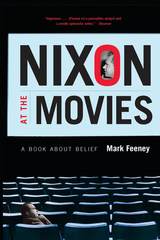 Nixon at the Movies: A Book about Belief
Mark Feeney
University of Chicago Press, 2004 Was it an omen? Richard Nixon and the film industry arrived in Southern California in the same year, 1913. As Mark Feeney relates in this unusual and unusually absorbing book, Nixon and the movies have shared a long and complex history. Some of that history—the president's multiple screenings of Patton before and during the invasion of Cambodia, or Oliver Stone's Nixon—is well known. Yet much more is not. How many are aware, for example, that Nixon was an enthusiastic filmgoer who watched more than five hundred movies during his presidency?
Nixon at the Movies takes a new and often revelatory approach to looking at Nixon's career—and Hollywood's. From the obvious (All the President's Men) to the less so (Elvis Presley movies and Nixon's relationship to '60s youth culture) to several onscreen "alternate" Nixons (Fred MacMurray in Double Indemnity, Tony Curtis in The Sweet Smell of Success, Gene Hackman in The Conversation), Feeney sees aspects of Nixon's character, and the nation's, refracted and reimagined in film. Conversely, Feeney argues that Nixon can help us see the movies in a new light, making a strong case for Nixon as the movies' tutelary deity during the early '70s, playing a role in Hollywood's Silver Age comparable to FDR's during its Golden Age.
Stylishly written and bracingly eclectic, Nixon at the Movies draws on biography, politics, cultural history, and film criticism to show just how deeply in the twentieth-century American grain lies the pair of seemingly incongruous nouns in its title. As Nixon once remarked to Garry Wills: "Isn't that a hell of a thing, that the fate of a great country can depend on camera angles?"
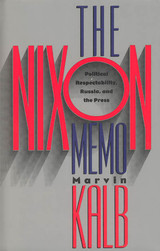 The Nixon Memo: Political Respectability, Russia, and the Press
Marvin Kalb
University of Chicago Press, 1994 An absorbing example of political journalism, The Nixon Memo is a case study of Richard Nixon's relentless quest for political rehabilitation. At issue is the key role of this former president of the United States (best known for his involvement in the famous "watergate" scandal) in the post-cold war debate about aiding Russia in its uncertain revolution.
The story begins on March 10, 1992. Nixon had written a private memo critical of president George Bush's policy toward Russia. The memo leaked and exploded on the front page of The New York Times. Why would Nixon attack Bush, a fellow party member fighting for re-election? Why on an issue of foreign affairs, which was Bush's strength? The questions are as intriguing as the answers, and distinguished journalist and scholar Marvin Kalb offers a suspenseful, eye-opening account of how our conventional wisdom on United States foreign policy is shaped by the insider's game of press/politics.
This story of Nixon's Machiavellian efforts to pressure the White House, by way of the press, into helping Boris Yeltsin and Russia sheds new light on the inner workings of the world inside the government of the United States. Marvin Kalb read the documents behind the Nixon memo and interviewed scores of journalists, scholars, and officials in and from Washington and Moscow. Drawing on his years of experience as a diplomatic correspondent, he identifies and illuminates the intersection of press and politics in the fashioning of public policy.
"An absorbing and often compelling argument that Richard Nixon directed his own political rehabilitation on the world stage, using presidents, lesser politicians, and the press as his supporting cast. This is a first-class job of unraveling a complex and usually unseen tapestry."—Ted Koppel
"With Marvin Kalb's captivating account, Richard Nixon continues to fascinate us even in death."—Al Hunt
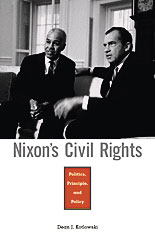 Nixon’s Civil Rights: Politics, Principle, and Policy
Dean J. Kotlowski
Harvard University Press, 2001 Richard Nixon believed that history would show his administration in the forefront of civil rights progress. What does the record really say about civil rights under Nixon? In a groundbreaking new book, Dean Kotlowski offers a surprising study of an administration that redirected the course of civil rights in America.
Nixon's policymaking recast the civil rights debate from an argument over racial integration to an effort to improve the economic station of disadvantaged groups. Kotlowski examines such issues as school desegregation, fair housing, voting rights, affirmative action, and minority businesses as well as Native American and women's rights. He details Nixon's role, revealing a president who favored deeds over rhetoric and who constantly weighed political expediency and principles in crafting civil rights policy.
In moving the debate from the street to the system, Nixon set civil rights on a path whose merits and results are still debated. Nixon's Civil Rights is a revealing portrait of one of the most enigmatic figures of modern American politics and a major contribution to the study of civil rights in America.
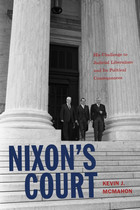 Nixon's Court: His Challenge to Judicial Liberalism and Its Political Consequences
Kevin J. McMahon
University of Chicago Press, 2011 Most analysts have deemed Richard Nixon’s challenge to the judicial liberalism of the Warren Supreme Court a failure—“a counterrevolution that wasn’t.” Nixon’s Court offers an alternative assessment. Kevin J. McMahon reveals a Nixon whose public rhetoric was more conservative than his administration’s actions and whose policy towards the Court was more subtle than previously recognized. Viewing Nixon’s judicial strategy as part political and part legal, McMahon argues that Nixon succeeded substantially on both counts. Many of the issues dear to social conservatives, such as abortion and school prayer, were not nearly as important to Nixon. Consequently, his nominations for the Supreme Court were chosen primarily to advance his “law and order” and school desegregation agendas—agendas the Court eventually endorsed. But there were also political motivations to Nixon’s approach: he wanted his judicial policy to be conservative enough to attract white southerners and northern white ethnics disgruntled with the Democratic party but not so conservative as to drive away moderates in his own party. In essence, then, he used his criticisms of the Court to speak to members of his “Silent Majority” in hopes of disrupting the long-dominant New Deal Democratic coalition. For McMahon, Nixon’s judicial strategy succeeded not only in shaping the course of constitutional law in the areas he most desired but also in laying the foundation of an electoral alliance that would dominate presidential politics for a generation.
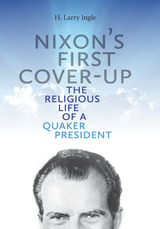 Nixon's First Cover-up: The Religious Life of a Quaker President
H. Larry Ingle
University of Missouri Press, 2015 Have you ever thought you completely knew a story, inside and out, only to see some new information that shatters what you had come to accept as unquestioned fact? Well, Richard Nixon is that story, and Nixon’s First Cover-up is that new information. With few exceptions, the religious ideologies and backgrounds of U.S. presidents is a topic sorely lacking in analysis. H. Larry Ingle seeks to remedy this situation regarding Nixon—one of the most controversial and intriguing of the presidents. Ingle delves more deeply into Nixon’s Quaker background than any previous scholar to observe the role Nixon’s religion played in his political career. Nixon’s unique and personally tailored brand of evangelical Quakerism stayed hidden when he wanted it to, but was on display whenever he felt it might help him advance his career in some way. Ingle’s unparalleled knowledge of Quakerism enables him to deftly point out how Nixon bent the traditional rules of the religion to suit his needs or, in some cases, simply ignored them entirely. This theme of the constant contradiction between Nixon’s actions and his apparent religious beliefs makes Nixon’s First Cover-up truly a groundbreaking study both in the field of Nixon research as well as the field of the influence of religion on the U.S. presidency. Forty years after Nixon’s resignation from office, Ingle’s work proves there remains much about the thirty-seventh president that the American public does not yet know.
 Njinga of Angola: Africa’s Warrior Queen
Linda M. Heywood
Harvard University Press, 2017 “The fascinating story of arguably the greatest queen in sub-Saharan African history, who surely deserves a place in the pantheon of revolutionary world leaders.”
—Henry Louis Gates, Jr.
Though largely unknown in the West, the seventeenth-century African queen Njinga was one of the most multifaceted rulers in history, a woman who rivaled Queen Elizabeth I in political cunning and military prowess. In this landmark book, based on nine years of research and drawing from missionary accounts, letters, and colonial records, Linda Heywood reveals how this legendary queen skillfully navigated—and ultimately transcended—the ruthless, male-dominated power struggles of her time.
“Queen Njinga of Angola has long been among the many heroes whom black diasporians have used to construct a pantheon and a usable past. Linda Heywood gives us a different Njinga—one brimming with all the qualities that made her the stuff of legend but also full of all the interests and inclinations that made her human. A thorough, serious, and long overdue study of a fascinating ruler, Njinga of Angola is an essential addition to the study of the black Atlantic world.”
—Ta-Nehisi Coates
“This fine biography attempts to reconcile her political acumen with the human sacrifices, infanticide, and slave trading by which she consolidated and projected power.”
—New Yorker
“Queen Njinga was by far the most successful of African rulers in resisting Portuguese colonialism…Tactically pious and unhesitatingly murderous…a commanding figure in velvet slippers and elephant hair ripe for big-screen treatment; and surely, as our social media age puts it, one badass woman.”
—Karen Shook, Times Higher Education
 Nkrumah & the Chiefs: The Politics of Chieftaincy in Ghana, 1951–1960
Richard Rathbone
Ohio University Press, 1999 Kwame Nkrumah, who won independence for Ghana in 1957, was the first African statesman to achieve world recognition. Nkrumah and his movement also brought about the end of independent chieftaincy—one of the most fundamental changes in the history of Ghana. Kwame Nkrumah’s Convention Peoples’ Party was committed not only to the rapid termination of British colonial rule but also to the elimination of chiefly power. This book is an account of Kwame Nkrumah and his government’s long struggle to wrest administrative control of the Ghanaian countryside from the chiefs. Based largely upon previously unstudied documentation in Ghana, this study charts the government’s frustrated attempts to democratize local government and the long and bitter campaigns mounted by many southern chiefs to resist their political marginalization. Between 1951 and the creation of the First Republic in 1960, Ghanaian governments sought to discard the chiefly principle in local government, then to weaken chieftaincy by attrition and eventually, by altering the legal basis of chieftaincy, to incorporate and control a considerably altered chieftaincy. The book demonstrates that chieftaincy was consciously and systematically reconstructed in the decade of the 1950s with implications which can still be felt in modern Ghana.
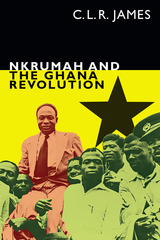 Nkrumah and the Ghana Revolution
C. L. R. James
Duke University Press, 2022 In this new edition of Nkrumah and the Ghana Revolution, C. L. R. James tells the history of the socialist revolution led by Kwame Nkrumah, the first president and prime minister of Ghana. Although James wrote it in the immediate post-independence period around 1958, he did not publish it until nearly twenty years later, when he added a series of his own letters, speeches, and articles from the 1960s. Although Nkrumah led the revolution, James emphasizes that it was a popular mass movement fundamentally realized by the actions of everyday Ghanaians. Moreover, James shows that Ghana’s independence movement was an exceptional moment in global revolutionary history: it moved revolutionary activity to the African continent and employed new tactics not seen in previous revolutions. Featuring a new introduction by Leslie James, an unpublished draft of C. L. R. James's introduction to the 1977 edition, and correspondence, this definitive edition of Nkrumah and the Ghana Revolution offers a revised understanding of Africa’s shaping of freedom movements and insight into the possibilities for decolonial futures.
 No
Idea Vilariño
Carnegie Mellon University Press, 2025 Idea Vilariño’s final masterpiece, where poetry becomes both refusal and resilience.
In No, Idea Vilariño strips poetry to its essence—distilling love, loss, and the inexorable passage of time into spare yet searing verses. Renowned as a leading voice of Uruguay’s “Generation of 45,” Vilariño’s final collection is at once a defiant refusal and an unrelenting assertion of existence. From its stark nihilism emerges a poetic voice that insists on being heard, even as it denies life’s joys.
Now available in English for the first time, No has been masterfully translated by María José Zubieta, in collaboration with poet and musicologist J. Martin Daughtry. This bilingual edition preserves Vilariño’s rhythmic precision and existential intensity, giving readers a rare glimpse into a body of work that continues to resonate far beyond its origins. No is a testament to the power of poetry to confront the void, and to carve meaning from silence.
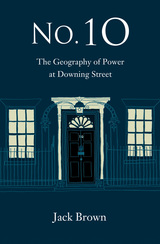 No. 10: The Geography of Power at Downing Street
Jack Brown
Haus Publishing, 2019 Fronted by one of the world’s most iconic doors, 10 Downing Street is the home and office of the British Prime Minister and the heart of British politics. Steeped in both political and architectural history, this famed address was originally designed in the late seventeenth century as little more than a place of residence, with no foresight of the political significance the location would come to hold. As its role evolved, 10 Downing Street, now known simply as ‘Number 10,’ has required constant adaptation in order to accommodate the changing requirements of the premiership.
Written by Number 10’s first ever ‘Researcher in Residence,’ with unprecedented access to people and papers, No. 10: The Geography of Power at Downing Street sheds new light on unexplored aspects of Prime Ministers’ lives. Jack Brown tells the story of the intimately entwined relationships between the house and its post-war residents, telling how each occupant’s use and modification of the building reveals their own values and approaches to the office of Prime Minister. The book reveals how and why Prime Ministers have stamped their personalities and philosophies upon Number 10 and how the building has directly affected the ability of some Prime Ministers to perform the role. Both fascinating and extremely revealing, No. 10 offers an intimate account of British political power and the building at its core. It is essential reading for anyone interested in the nature and history of British politics.
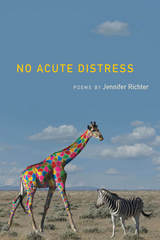 No Acute Distress
Jennifer Richter
Southern Illinois University Press, 2016 Jennifer Richter’s penetrating second collection of poems, No Acute Distress, introduces us to the unspoken struggles and unanticipated epiphanies of illness and motherhood, subjects rarely explored together in contemporary poetry. The first poem of each section borrows from a classic joke form—one begins, “An intractable migraine walks into a bar”—to consider the thin line this mother walks between the tragic and comic: debilitating pain met with increasingly absurd and desperate medical treatments.
Richter seasons her work with irony from the start, titling the book’s opening poem, “Pleasant, healthy-appearing adult white female in no acute distress.” As the collection progresses, the speaker’s growing children bring new, wider perspective to the poems; the heart of the book opens up to embrace the adolescents’ increasing self-sufficiency and the body’s vibrant re-emergence into health.
No Acute Distress offers readers fresh language grounded in a masterful use of form, speaking with an urgency that acknowledges chronic pain’s cumulative damage to the body and spirit, and with an openness that allows for hope and the inexplicable on the path to victorious recovery.
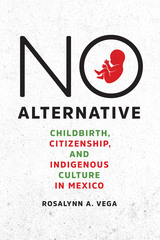 No Alternative: Childbirth, Citizenship, and Indigenous Culture in Mexico
By Rosalynn A. Vega
University of Texas Press, 2018 Recent anthropological scholarship on “new midwifery” centers on how professional midwives in various countries are helping women reconnect with “nature,” teaching them to trust in their bodies, respecting women’s “choices,” and fighting for women’s right to birth as naturally as possible. In No Alternative, Rosalynn A. Vega uses ethnographic accounts of natural birth practices in Mexico to complicate these narratives about new midwifery and illuminate larger questions of female empowerment, citizenship, and the commodification of indigenous culture, by showing how alternative birth actually reinscribes traditional racial and gender hierarchies. Vega contrasts the vastly different birthing experiences of upper-class and indigenous Mexican women. Upper-class women often travel to birthing centers to be delivered by professional midwives whose methods are adopted from and represented as indigenous culture, while indigenous women from those same cultures are often forced by lack of resources to use government hospitals regardless of their preferred birthing method. Vega demonstrates that women’s empowerment, having a “choice,” is a privilege of those capable of paying for private medical services—albeit a dubious privilege, as it puts the burden of correctly producing future members of society on women’s shoulders. Vega’s research thus also reveals the limits of citizenship in a neoliberal world, as indigeneity becomes an object of consumption within a transnational racialized economy.
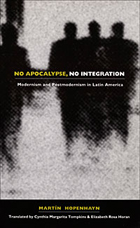 No Apocalypse, No Integration: Modernism and Postmodernism in Latin America
Martín Hopenhayn
Duke University Press, 2001 Winner of the Premio Iberoamericano Book Award in 1997 (Spanish Edition) What form does the crisis of modernity take in Latin America when societies are politically demobilized and there is no revolutionary agenda in sight? How does postmodern criticism reflect on enlightenment and utopia in a region marked by incomplete modernization, new waves of privatization, great masses of excluded peoples, and profound sociocultural heterogeneity? In No Apocalypse, No Integration Martín Hopenhayn examines the social and philosophical implications of the triumph of neoliberalism and the collapse of leftist and state-sponsored social planning in Latin America.
With the failure of utopian movements that promised social change, the rupture of the link between the production of knowledge and practical intervention, and the defeat of modernization and development policy established after World War II, Latin American intellectuals and militants have been left at an impasse without a vital program of action. Hopenhayn analyzes these crises from a theoretical perspective and calls upon Latin American intellectuals to reevaluate their objects of study, their political reality, and their society’s cultural production, as well as to seek within their own history the elements for a new collective discourse. Challenging the notion that strict adherence to a single paradigm of action can rescue intellectual and cultural movements, Hopenhayn advocates a course of epistemological pluralism, arguing that such an approach values respect for difference and for cultural and theoretical diversity and heterodoxy.
This essay collection will appeal to readers of sociology, public policy, philosophy, cultural theory, and Latin American history and culture, as well as to those with an interest in Latin America’s current transition.
 No Author Better Served: The Correspondence of Samuel Beckett and Alan Schneider
Samuel Beckett and Alan Schneider; edited by Maurice Harmon
Harvard University Press, 2000 For Alan Schneider, directing Endgame, Samuel Beckett lays out the play’s philosophy, then adds: “Don’t mention any of this to your actors!”
He claimed he couldn’t talk about his work, but Beckett proves remarkably forthcoming in these pages, which document the thirty-year working relationship between the playwright and his principal producer in the United States. The correspondence between Beckett and Schneider offers an unparalleled picture of the art and craft of theater in the hands of two masters. It is also an endlessly enlightening look into the playwright’s ideas and methods, his remarks a virtual crib sheet for his brilliant, eccentric plays.
Alan Schneider premiered five of Beckett’s plays in the United States, including Waiting for Godot, Krapp’s Last Tape, and Endgame, and directed a number of revivals. Preparing for each new production, the two wrote extensive letters—about intended tone, conception of characters, irony and verbal echoes, staging details for scenes, delivery of individual lines. From such details a remarkable sense of the playwright’s vision emerges, as well as a feel for the director’s task. Of Godot, Beckett wrote to Schneider, “I feel my monster is in safe keeping.” His confidence in the director, and Schneider’s persistent probing for a surer understanding of each play, have produced a marvelous resource: a detailed map of Beckett’s work in conception and in production.
The correspondence starts in December 1955, shortly after their first meeting, and continues to Schneider’s accidental death in March 1984 (when crossing a street to mail a letter to Beckett). The 500 letters capture the world of theater as well as the personalities of their authors. Maurice Harmon’s thorough notes provide a helpful guide to people and events mentioned throughout.
|
|
